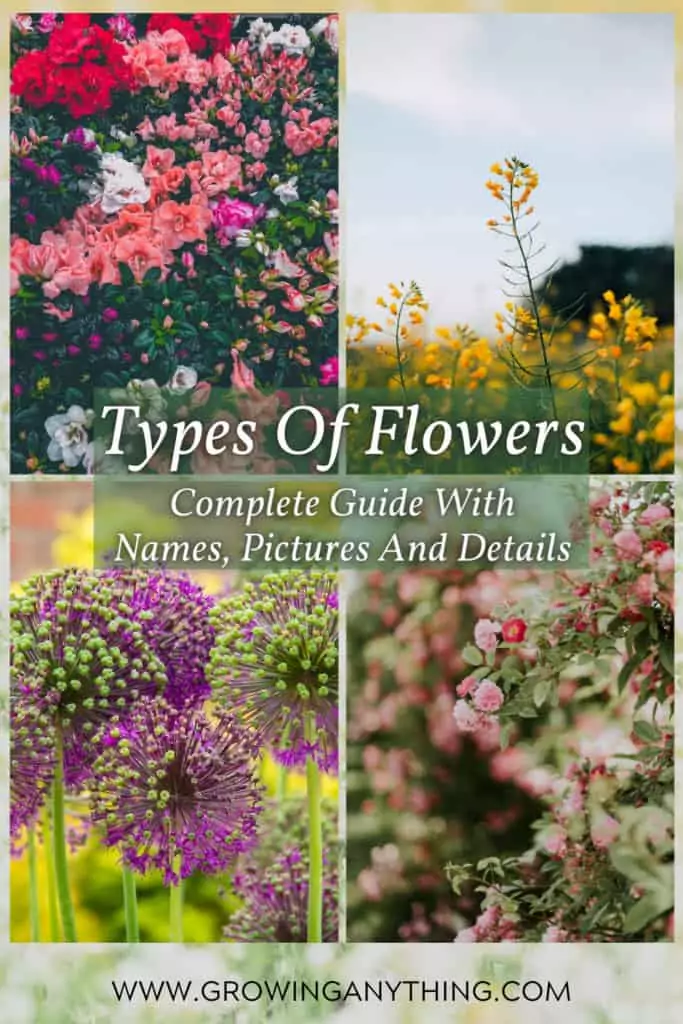211 Difference Types of Flowers
Did many types of flowers fascinate you? Here is your ultimate database for all those lovely blooms we can see in nature!
You can save the list to have it handy to learn more about different varieties, flower names, and available colors and get more information about growing them!
After you read the article, you’ll know about annual, perennial, flowering shrubs, and other general flower types. I will also include a specific alphabetic list of flowers you can use to identify plants and get inspiration for your garden.
Let’s start!
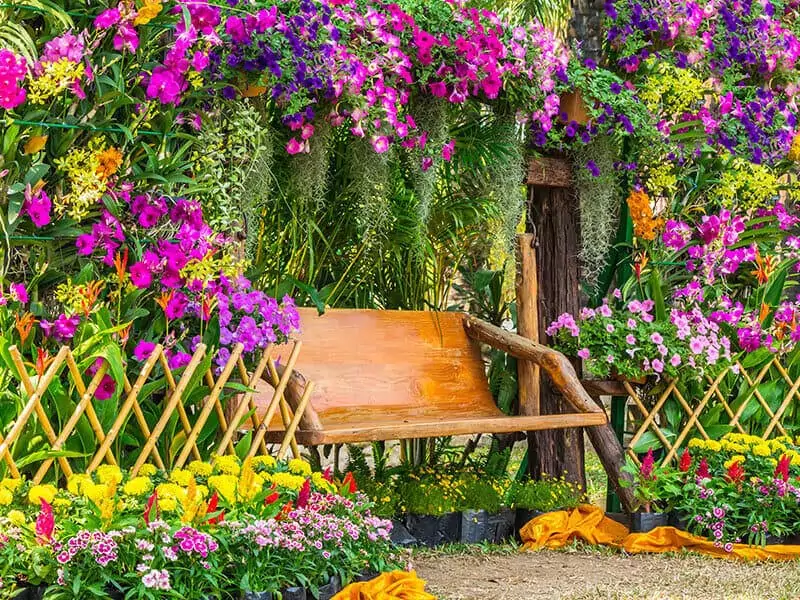
8 General Categories Of Flowers
All flowering plants are classified into several categories. Let’s first talk about general classification. Then, we enjoy the complete A to Z list of flowers!
1. Annual Flowers
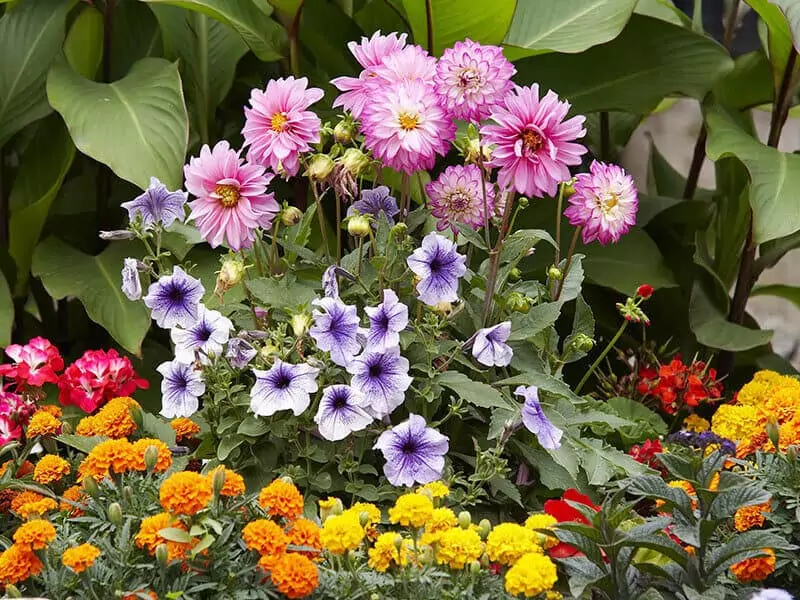
Annual flowers complete their life cycle in one growing season. After that, the plant dies. Before that, the plants germinate, bloom, and set seeds. Therefore, it completes its reproductive purpose, so gardeners get seeds to plant in the new season.
Most annual flowers are rich bloomers and produce magnificent and abundant flowers before they die. There are also techniques to postpone the setting of the seeds and expand the flowering season. You can try deadheading with annuals and some may flower until the frost.
Mixing annual flowers with other flower categories ensures you get amazing diversity in your garden.
In the world of annual flowers, you can find plants, such as hardy, half-hardy, and tender annuals.
Hardy annuals are called cool-season annuals because they prefer cooler temperatures and are resistant to light frosts. The second category, half-hardy annuals are very adaptable and can tolerate slightly cooler temperatures at the beginning or end of the season.
Lastly, tender annuals are warm-season flowers. They come from tropical climates and cannot grow in cooler weather. Therefore, you can only plant them in late spring when the danger of frost has passed.
There are so many benefits of growing annuals. They allow you to experiment with the dynamics of your garden, in terms of colors and textures, without fear of temporary setting.
These plants also mature quicker and bloom richer than some perennials. You can also use them to attract pollinators and boost your crops in the middle of the season.
2. Perennial Flowers
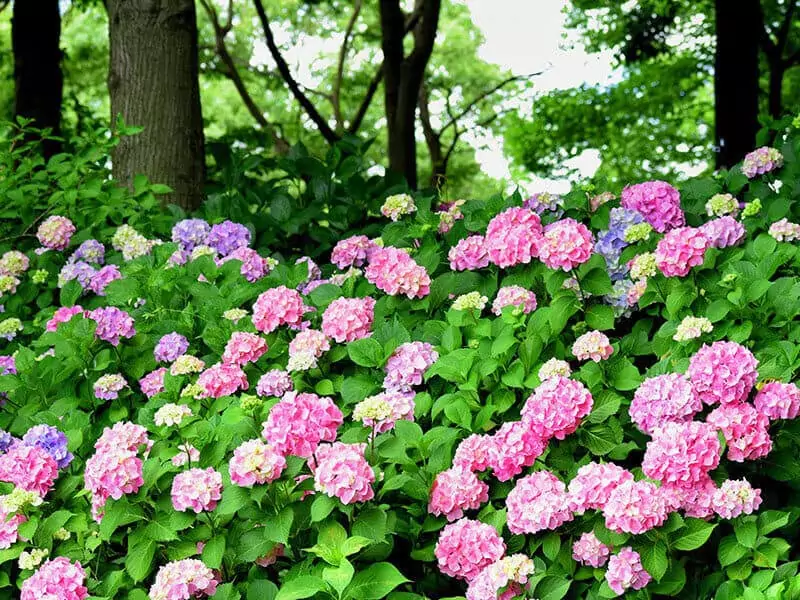
Perennial flowers are cold-hardy and will return after the winter passes. Most perennial flowers only bloom for a limited time of the year. It is often spring or summer, but several perennial flowers also re-bloom year-round.
By definition, perennials live longer than three years. But, it doesn’t mean your perennial flowers will live indefinitely on their own. Some may still need winter protection or will only bloom for several years. They also might require pruning and regular propagation to remain attractive.
Luckily, the perennials category is huge, and you can also find lovely perennial flowers which thrive on neglect.
A perennial flower might cost more money initially. But, in reality, paying for perennial flowers is actually a long-term investment. The plants will remain beautiful for years, and you can reseed them, divide them and expand your garden!
Perennials are often easier to grow in drought-prone places. In addition, if you choose perennials that are native to your area, you will attract local wildlife and pollinators. Therefore, your entire garden can benefit from it.
So, if you want to add a long-term beauty aspect to your garden with minimal maintenance, perennial flowers are the way to go!
3. Flowering Succulents
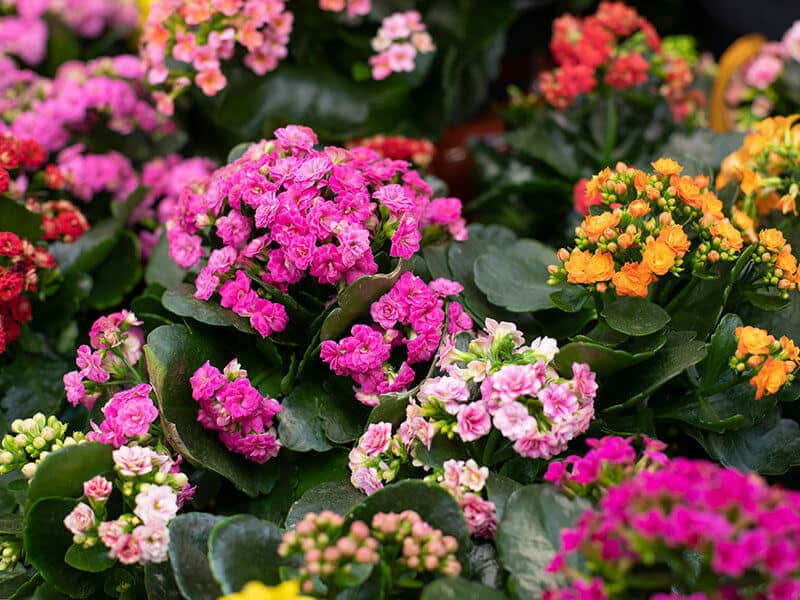
Flowering succulents are an exceptional category of flowers, capturing some of the most attractive plants in the world. Colorful succulents are among the most attractive and unusual plants
Succulents are able to conserve water in stems and foliage, and therefore, require less frequent watering.
They are often grown because of their attractive foliage and blooms, low-maintenance nature, and diversity. Flowering succulents are an excellent choice for desert gardens, and areas with minimal rainfalls. In most cases, succulents are small plants, which you can plant in the soil or containers.
They can also be found as groundcovers, and you can grow them outdoors and indoors.
Most succulents have their reproductive organs underground, such as bulbs and tubers. Their reproductive organs also conserve water.
4. Cacti
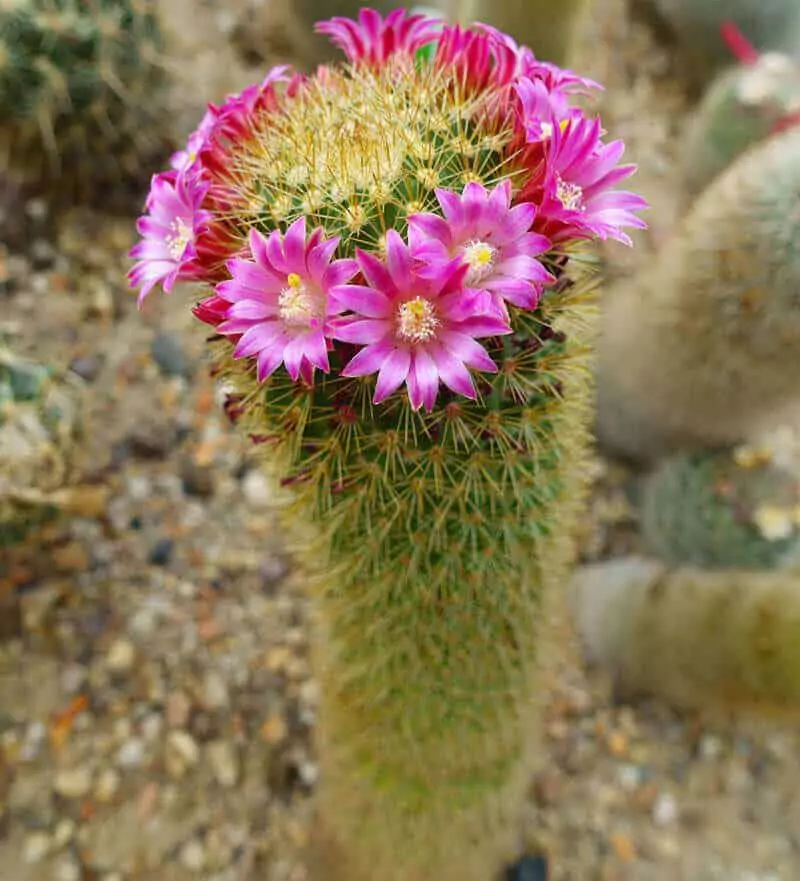
All cacti produce flowers. But, some bloom with magnificent, spectacular flowers and others feature more modest displays.
In general, cacti can survive in extreme drought environments because they conserve water. Most cacti have fleshy foliage, and stems, which hold the water and keep the plant safe from extreme heat.
Cacti also have spines that control water loss and keep the plant safe from herbivores. In addition, spines provide shade that prevents the plant from overheating!
In most cacti plants, flowers remain attractive for one to two weeks. In rare cases, and under ideal conditions, the flowers may last two months. Overall, flowering cacti are low-maintenance plants. But, they respond to sudden changes in temperatures and humidity.
Also, don’t expect your cacti to bloom at an early age. Most cacti only bloom once they reach full maturity. For some varieties, it means that the first flowers will appear once the plant is six feet tall.
Cacti produce flowers once a year. Rare species may rebloom, but they require special care. In most cases, the blooming seasons are spring and summer. It is because cacti need a lot of sunlight to produce flowers.
After the blooming season, you should remove spent flowers to keep your cactus healthy and attractive. Don’t forget to wear protective gloves to keep you safe from spines.
5. Flowering Shrubs
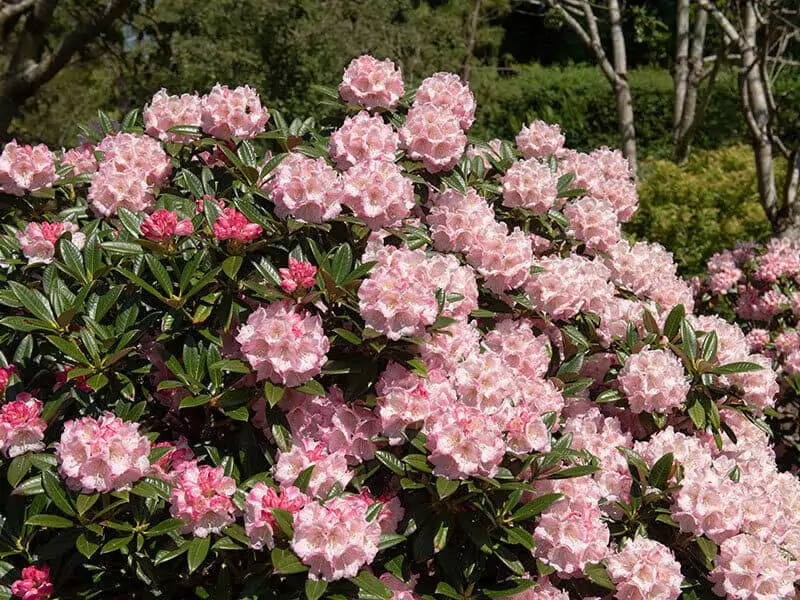
Flowering shrubs are an excellent way to add color, structure, and beauty to your garden. These shrubs are beautiful, provide color, attract helpful pollinators, and can even serve for privacy. You can grow flowering shrubs in your garden or in large containers on the patio.
They will be in charge of adding the extra beauty element to your outdoor space from spring to summer! They are suitable for walkways, foundation plantings, around pools, or in the garden borders.
Most flowering shrubs are small to medium. They have strong woody stems, and some smaller trees are classified as shrubs. A typical shrub has a multi-stemmed trunk and is relatively short. The average shrub height is less than ten feet.
Flowering shrubs are either deciduous or evergreen. In most cases, broadleaved shrubs are deciduous, and needle-like shrubs are evergreen.
There are several classifications of shrubs based on their foliage density. You can find shrubs with dense foliage, and mid-dense and sparse foliage.
Flowering shrubs are also popular in gardens because of their lovely aromas and attractive leaf colors.
But, when you choose a flowering shrub for your garden, consider the location carefully. It will serve as a focal point there for the upcoming ten years.
6. Bamboo
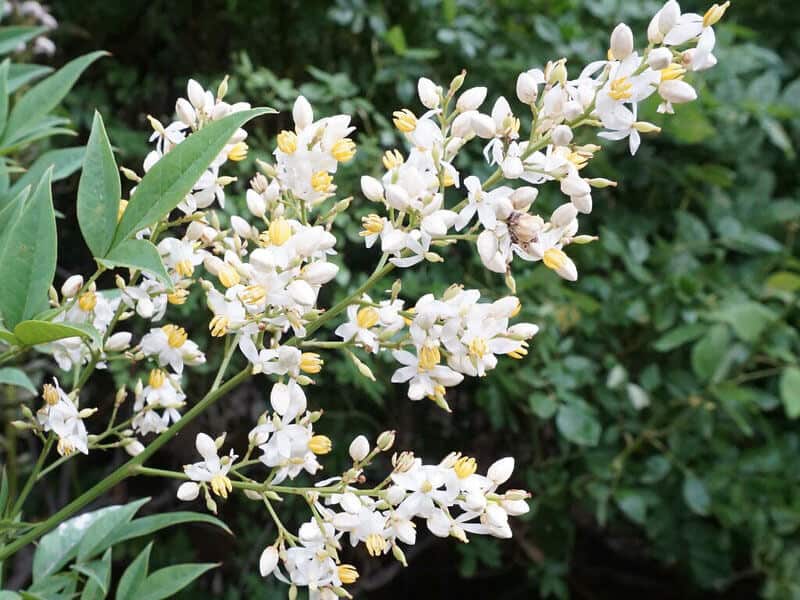
Bamboo is one of the oldest plants and has been around for millions of years. Today, bamboo is cultivated for different purposes, and not only for decoration. It is a common construction material, and perfect for bamboo DIY projects (internal link keyword “Bamboo projects”).
Bamboo is a resilient plant, technically grass. It has deep roots and adaptable nature. There are so many bamboo species, and some are considered fast growers because they can grow several inches per day.
Growing bamboo isn’t difficult. You can easily grow bamboo from cuttings (internal link keyword “How to grow bamboo from cuttings”).
All bamboo species are classified into clumping and running categories. The first one features one single root system, and runner bamboo develops canes that spread in different directions.
Bamboo flowers, but its flowering cycle often confuses botanists and is the focus of ongoing research. There is a classification of bamboo flowering.
Therefore, all bamboo varieties and their blooming habits are divided into continuous, sporadic, and gregarious flowering.
Continuous flowering is annual bamboo blooming, and most herbaceous and some woody bamboo species feature it. These species may bloom several years in a row, without any harmful effect on the plant.
The bamboo varieties that feature continuous flowering don’t produce viable seeds.
Blooming on the individual stems is called sporadic flowering. Most scientists believe environmental factors, such as sudden drought or temperature reduction, are the cause. In this case, seeds aren’t viable.
Lastly, gregarious flowering is typical for many woody bamboo cultivars. During gregarious flowering, blooms are produced on all bamboo plants, despite differences in growing conditions, climates, and geographic locations. Several years after gregarious flowering, the plant will die.
7. Ornamental Grass
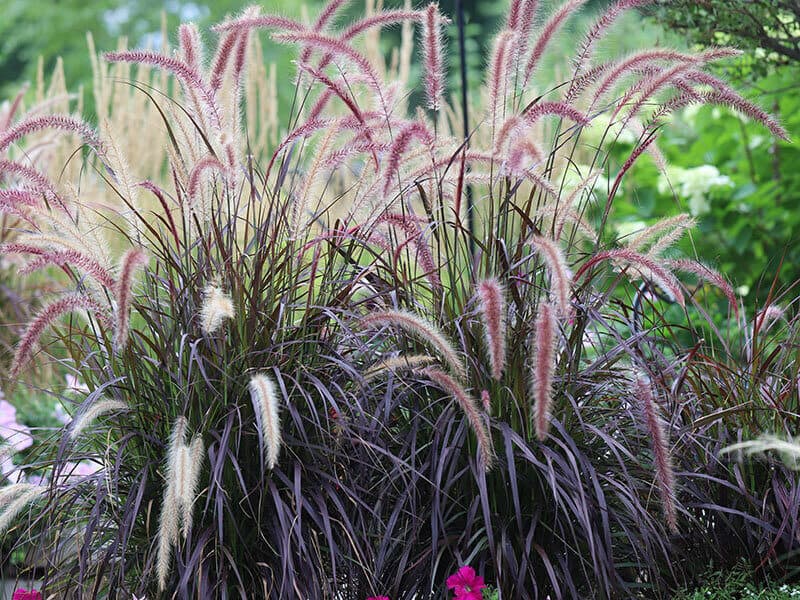
Many people choose ornamental grass for their garden to provide year-round visual interest or even winter interest!
Varieties of ornamental grasses produce attractive flowers which remain attractive for weeks and months. The flowers differ based on their sizes, colors, and textures.
Flowering ornamental grass is an excellent plant for all seasons. There is a huge range of cultivars, and they can be cultivated under different conditions, despite the soil quality.
Technically speaking, ornamental grass is a monocotyledonous plant. It has plenty of narrow leaves which operate as a single plant.
Herbaceous perennial grasses go dormant in fall, and they come back when the temperature rises, in spring. Evergreen grasses often have woody tissues.
Ornamental grasses are spectacular for adding motion to your garden, colors, and texture.
8. Bonsai
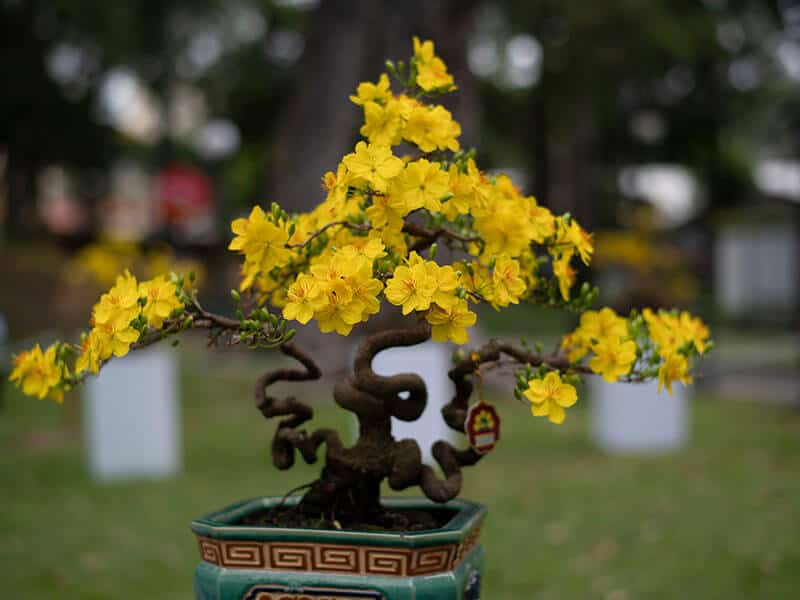
A bonsai tree is a product of gardeners’ efforts to contain the root system. Therefore, bonsai trees aren’t growing in nature.
The bonsai technique is ancient and first started in Japan. The technique includes wiring branching and pinching, pruning, and additional care. A bonsai tree won’t resemble a full-size tree completely, it takes a lot of effort for the tree to get the desired look.
Flowers look a lot like wild trees and provide a spectacularly colorful display.
People grow bonsai trees in containers, and they come in various sizes and shapes. Like full-size trees, bonsai trees bloom.
Their blooming seasons are spring and summer. However, to get your bonsai tree to bloom, you will have to use special fertilizers which will provide all important nutrients for your bonsai tree. The most effective are fertilizers for fruits and flowers.
These contain higher amounts of phosphorus and potassium and less nitrogen. Bonsai trees also need a lot of sunlight to bloom. Also, you shouldn’t let the soil dry completely, especially in the blooming season.
There are four sizes of bonsai trees: miniature, small, medium, and average. For example, miniature bonsai trees are about two inches tall. They need approximately five years to bloom to mature.
Complete A-Z Flower List With Names and Pictures
Here is the only list of flowers you’ll ever need! Find every flower you can come across in indoor and outdoor gardens!
1. Abutilon
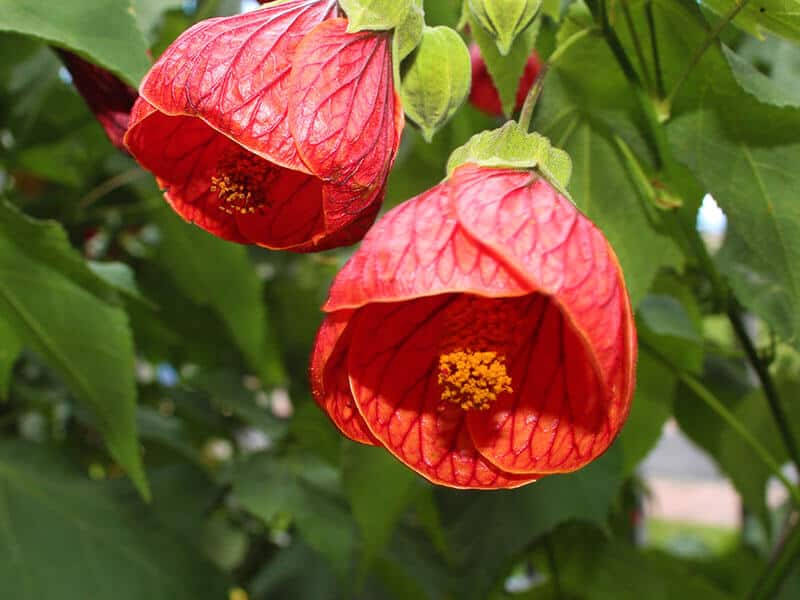
Abutilon flower comes from Brazil and can be found all across South and Central America. The plant features a shrub-like growing habit and has interesting flowers which look like hibiscus blooms. Often, Abutilon is called flowering maple because of its similarity to the tree.
The blooming season is from June to October. During that time, the plant gets covered in lovely orange flowers.
To grow Abutilon, put it in full sun or light shade. Ensure well-draining soil and water well, especially during the blooming season.
2. Acacia
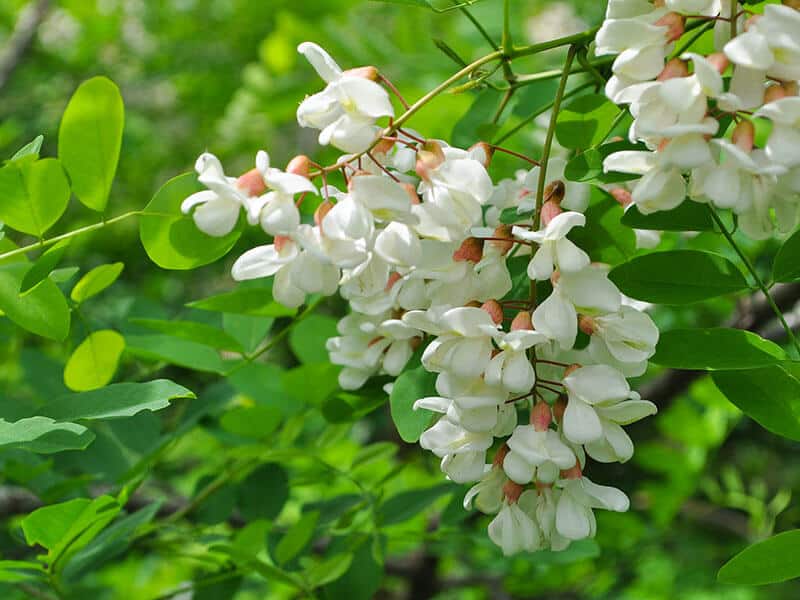
Acacia is one of the most recognizable types of yellow blooms. But, some nurseries also offer white Acacia with a slightly fuzzy look.
Acacia is also known to produce legumes, which differ vastly in size and looks. The plant looks like Mimosa, but it is a completely different species.
Acacia trees and shrubs are easy to grow in a Mediterranean climate. Hot Savana is also suitable for the plant. Additional growing requirements include well-draining soil, full sun exposure, and moderate watering.
The root system of Acacia is deep, and the plant can survive drought very well.
3. Aconitum
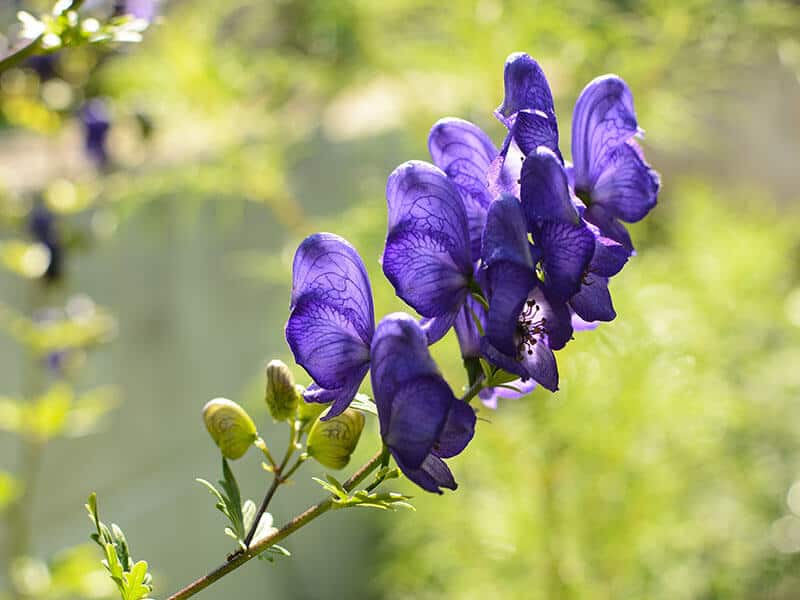
Aconitum belongs to the Ranunculus family and has several common names, including wolfsbane and monkshood. The plant is beautiful and has lovely foliage with subtly divided leaves.
But, the purple flowers, which appear in the beginning and middle of the summer, are the reason Aconitum is a popular garden plant.
Cool and moist soil is good for Aconitum and the plant grows well in partial shade or full sun. You can add organic matter to the soil before planting.
4. African Daisy
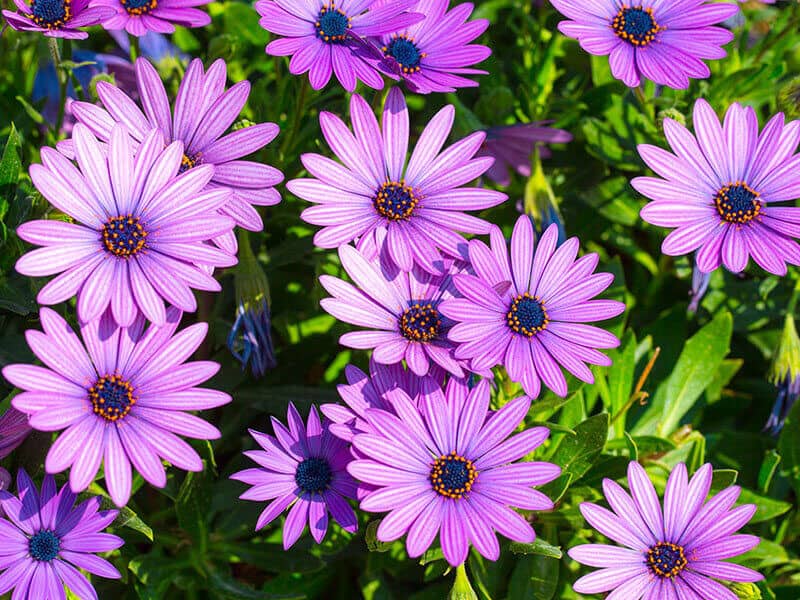
Most types of African Daisy, scientifically Gazania, are perennials. Popular cultivars have bright pink, blue or yellow petals. But, there are also some astonishing hybrids with variegated petals and deep purple centers.
African Daisies grow best in nutrient-rich, slightly acidic, and fast-draining soil. Juvenile plants need constant watering, and mature African Daisies have better drought resistance.
The ideal location for them is full sun. Feed the plants in the growing season, and deadheads spent flowers regularly to induce growth.
5. Agapanthus
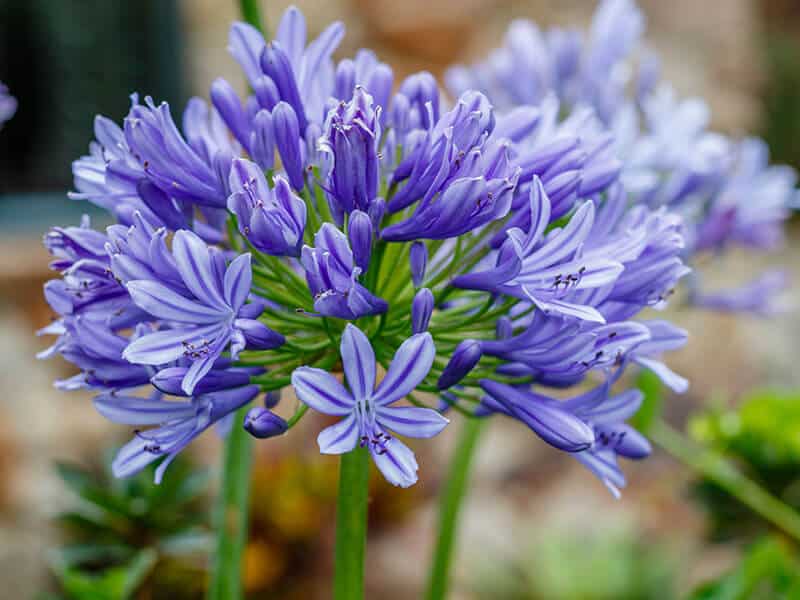
Agapanthus prefers full-sun exposure and a minimum of six hours of sunlight per day. If you want to grow Agapanthus in a tropical area, partial shade ensures a higher chance for success.
The flower isn’t too picky about the soil type. It grows best in moist, well-draining, and averagely fertile soil. The plant doesn’t have preferences for the pH value of the soil, but some varieties may grow slightly faster in acidic soil.
Star of Bethlehem is a popular name for Agapanthus.
6. Ageratum Houstonianum
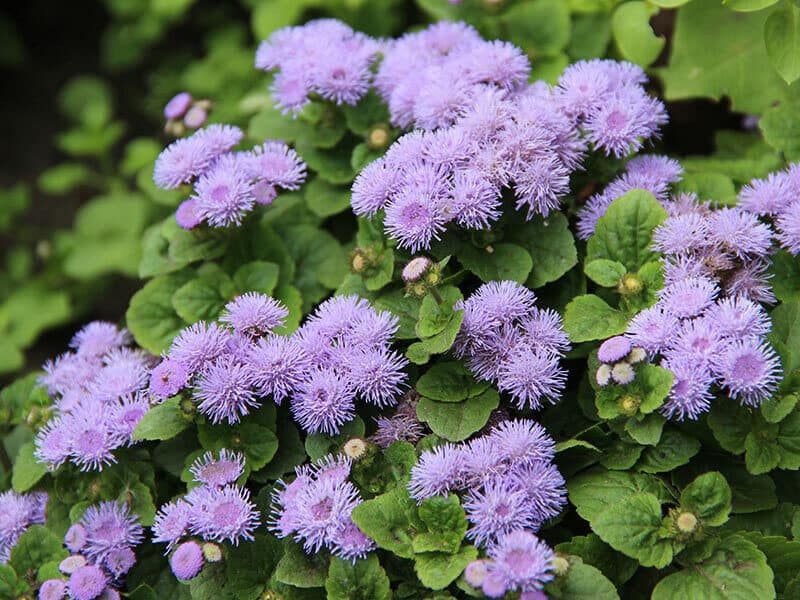
Ageratum houstonianum or Floss Flower is a low-maintenance annual flower. It is best and easiest grown from seeds and features lovely blue flowers (internal link keyword “Blue flowers”).
Floss flower requires excellent drainage and consistent moisture. However, never water the plant from overhead, because it significantly increases the risk of powdery mildew.
The plant thrives in full sun but may tolerate light shade. Air circulation and sunlight allow Ageratum to develop to its full potential.
7. Alchemilla
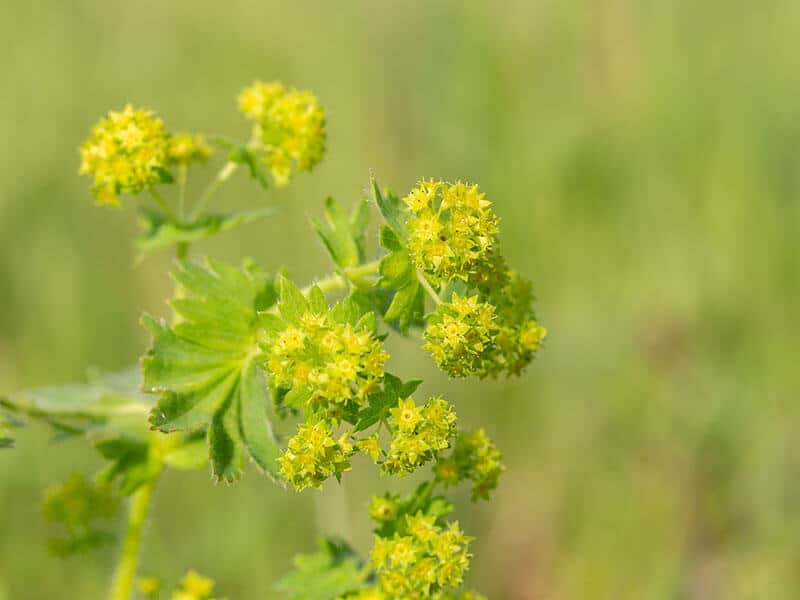
Alchemilla or Lady Mantle produces charming yellow-greenish flowers. It is rarely planted on its own. More frequently, Lady Mantle is combined with brighter flowers.
Alchemilla is easy to grow. Plant it in moist and fast-draining soil. Ideally, choose a full sun location for Alchemilla.
After the flowering season, cut Alchemilla back and apply an all-purpose fertilizer. It will encourage foliage development and re-blooming in a month or two.
8. Allium Roseum
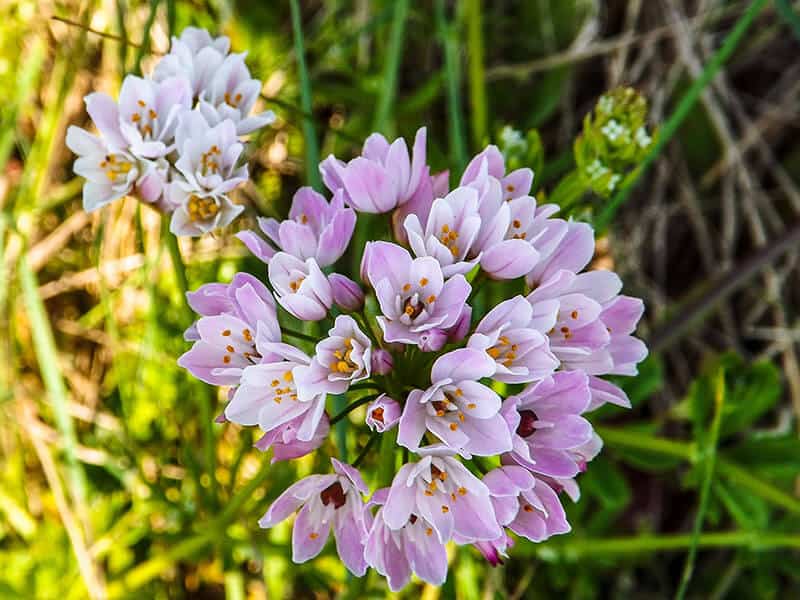
Allium roseum is ornamental garlic that produces delicate pale and rich pink blooms. The plant also has strap-shaped leaves, which contribute to its attractive appearance.
The blooming seasons start in late spring, and people plant Allium roseum to fill in the gaps in the garden or add a subtle touch of color. You can also grow Allium roseum in pots on your patio.
Allium roseum is ornamental garlic, but the bulbs are edible.
9. Alstroemeria
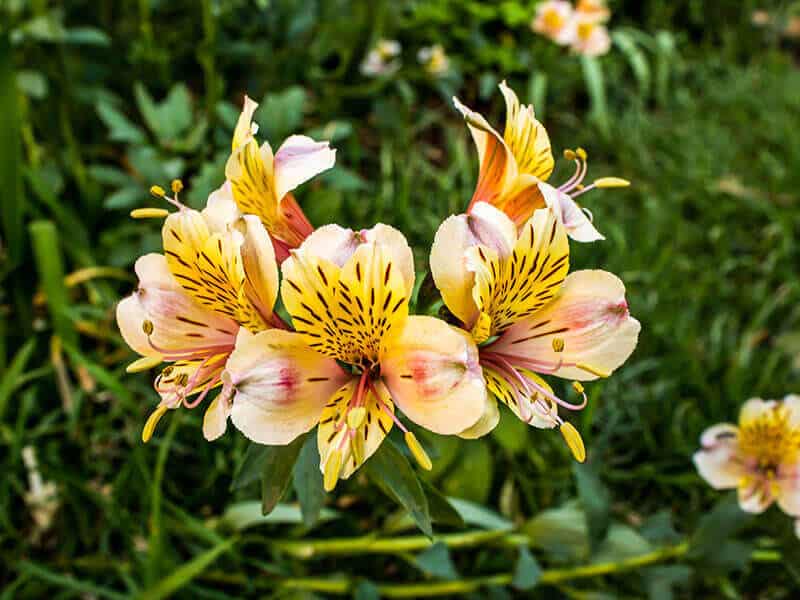
Alstroemerias look great on the garden borders and in containers. Their beautiful flowers are large and showy and available in different colors. Moreover, the blooming season is exceptional, from early summer to the late fall.
Most Alstroemerias are low-maintenance perennials and are frequently used as cut flowers.
Grow Alstroemerias in full sun and fertile and fast-draining soil. Your flowers need protection from harsh winds, so a sheltered position is ideal.
In addition, you can amend the soil with organic matter to get the best results. Peruvian lily is the common name for Alstroemeria.
10. Alyssum
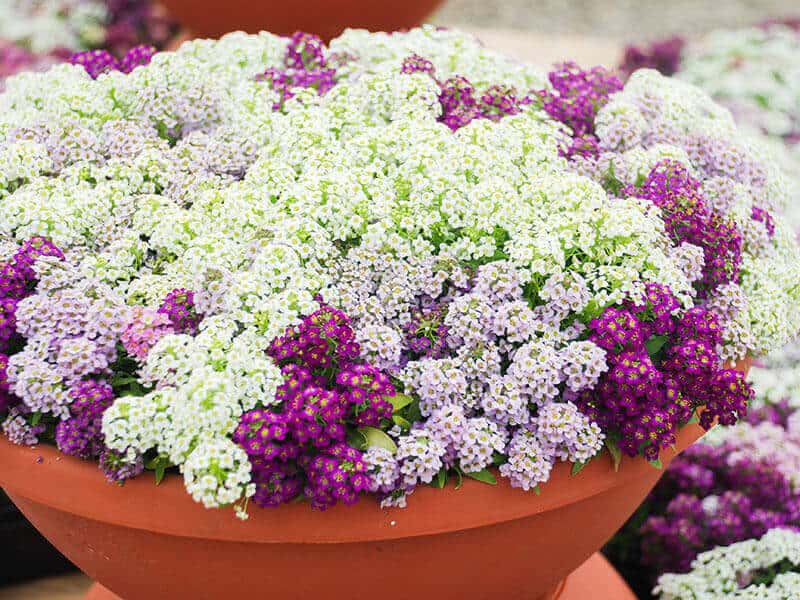
Alyssum is an attractive addition to containers, garden borders, and window boxes. It features small white or purple flowers which stand out against attractive deep green foliage.
The flower needs full sun to grow to its full potential, but you may get away with planting it in partial shade. Alyssum needs a moderate amount of water, approximately one inch per week.
11. Amaranthus
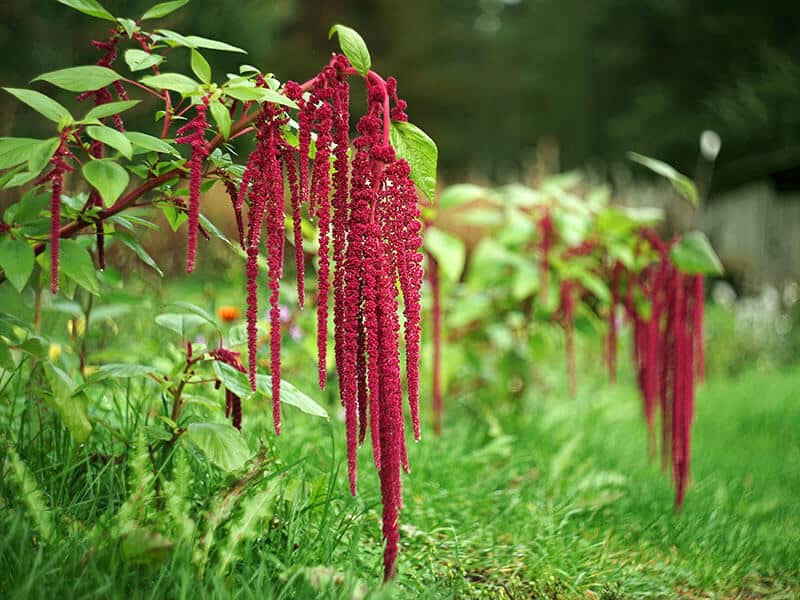
Prince’s Feather or Amaranthus is available as an annual or short-lived perennial. It goes under many names, and some varieties are edible. Amaranthus is cereal in some parts of South America.
The plant is easy to start from seeds. You should do it in March, and use moist compost for the best results. Don’t cover the seeds, and expose them to sunlight to ensure germination. The ideal temperature for germination is around 68 degrees Fahrenheit.
Transplant the seedlings into well-draining soil and full sun. Water once or twice per week and use fertilizer occasionally.
12. Amaryllis
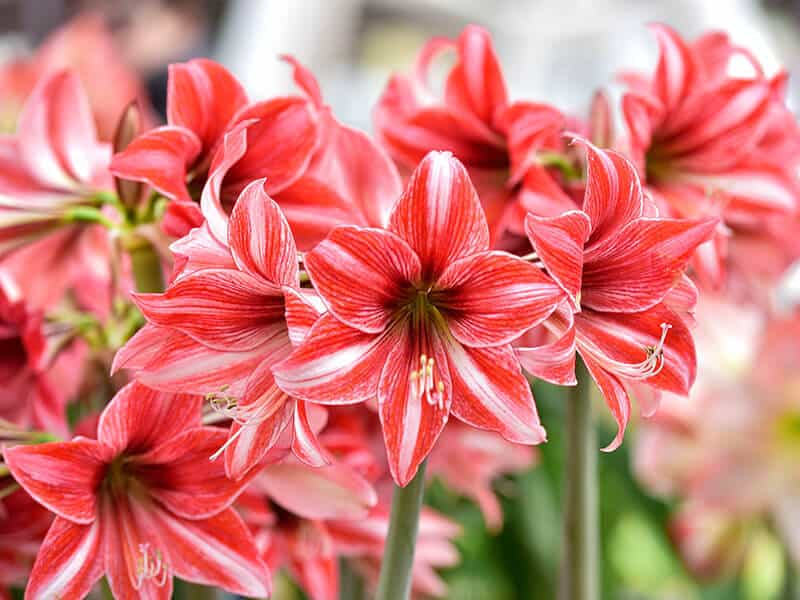
Hippeastrum or Amaryllis is a beautiful bulbous flower, which blooms in January. The flowers are star-shaped and funnel and can be white, pink, or red. Amaryllis is an excellent way to brighten up your space in the winter!
Amaryllis is easy to grow, but you’ll need a large container. Pick a sunny, indoor space and plant the bulbs in the loose soil. Weekly watering is enough.
Don’t forget to rotate the plant occasionally, so the plant gets even sunlight exposure. The first blooms should appear after a month or two!
13. Anemone
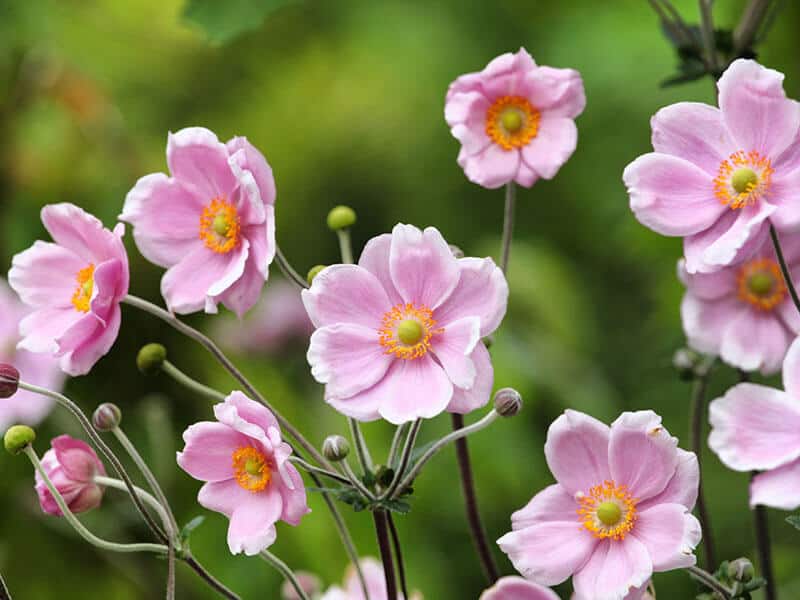
Anemones or Windflowers produce charming white, pink or blue flowers. They grow from tubers and bloom in late spring. Some Anemone varieties are great as shade-loving plants in your garden.
You can plant Anemone tubers in spring or autumn. The key to success is to plant tubers as soon as possible because they can dry. The soil needs to be well-draining, and the plant needs winter protection.
14. Angelonia
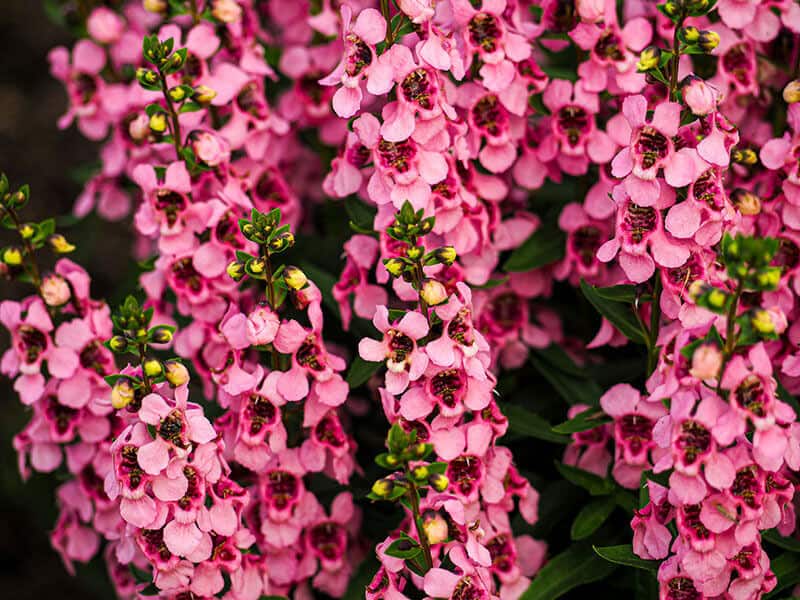
Angelonia is a tough and beautiful plant that disperses the lovely grape scent. The flowers are rich in nectar and attract pollinators, so your entire garden can benefit from them. These plants are low-maintenance, so they suit even the busiest gardeners!
Angelonia flowers grow well in various soil types (internal link keyword “Soil Types Explained”), but they need full sun exposure to bloom and grow. The plants have moderate drought resistance. This flower is often referred to as Summer Snapdragon.
15. Anthurium
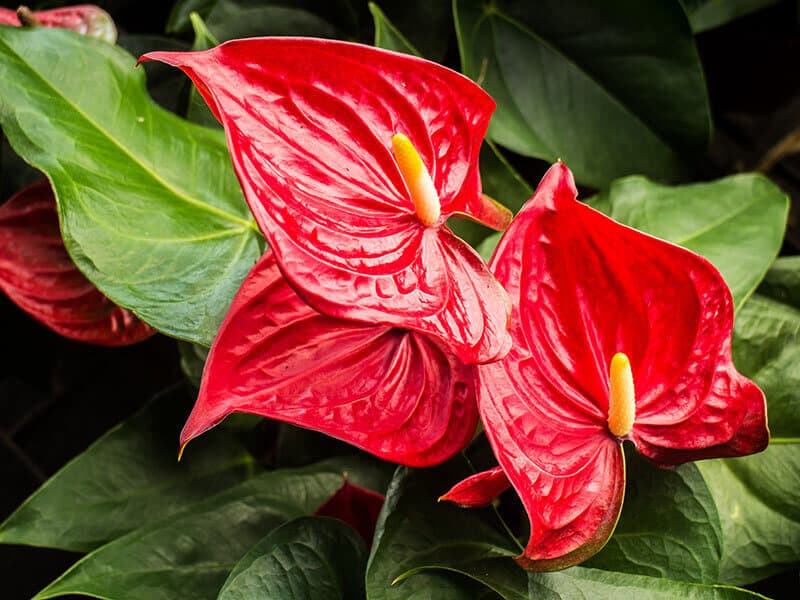
Anthurium or Flamingo Flower features easily fantastic bright red flowers. You need a full sun location, protected from direct sunlight because too much light can burn the flowers and foliage.
Anthuriums are perfect indoor plants because they thrive in temperatures up to 68 degrees Fahrenheit. Next, the plant needs high humidity, and you can keep it near the window in your bathroom. The conservatory is also a suitable location for growing Anthuriums.
16. Antirrhinum Majus

With their lovely bright pink, yellow or white blooms and low-maintenance nature, Antirrhinum majus are welcome in any garden! People also call them Snapdragon Flower, and it is hardy in zones seven to ten. Outside the zones, you can grow it as an annual plant.
Majus is a cool-season hardy plant, so it is the most attractive and healthy before the temperatures hit 80 degrees Fahrenheit. You can find various cultivars, from dwarf to taller varieties which will give beautiful structure to your garden.
17. Aquilegia
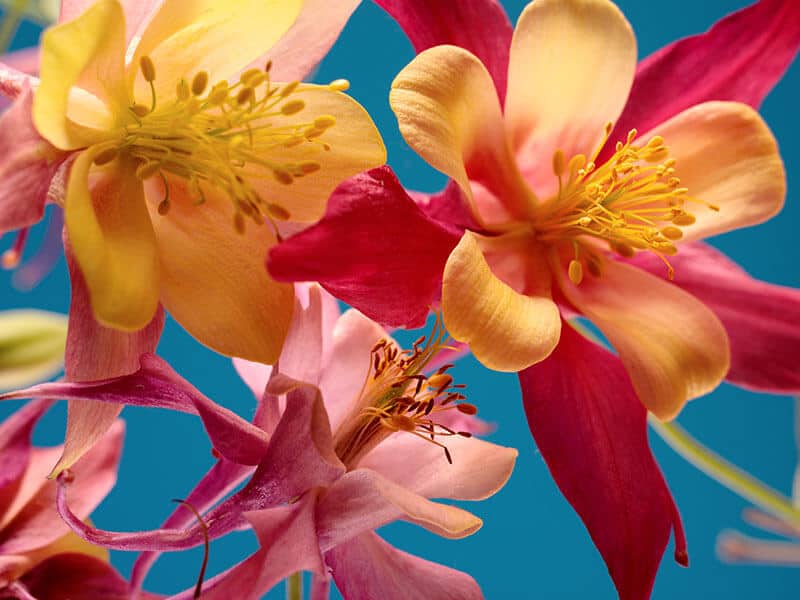
Aquilegia is common in cottage garden types and prefers rich and moist soil. Good drainage ensures your Aquilegia blooming in late spring.
Aquilegia prefers a sunny spot in cooler climates, but the semi-shaded area will work better in hot ones. If you want to prevent Aquilegia from self-seeding, cut the plant after the flowering season. It will also help the plant to refresh the foliage.
Common names for the plant are Columbine and Granny’s Bonnet.
18. Asclepias Syriaca
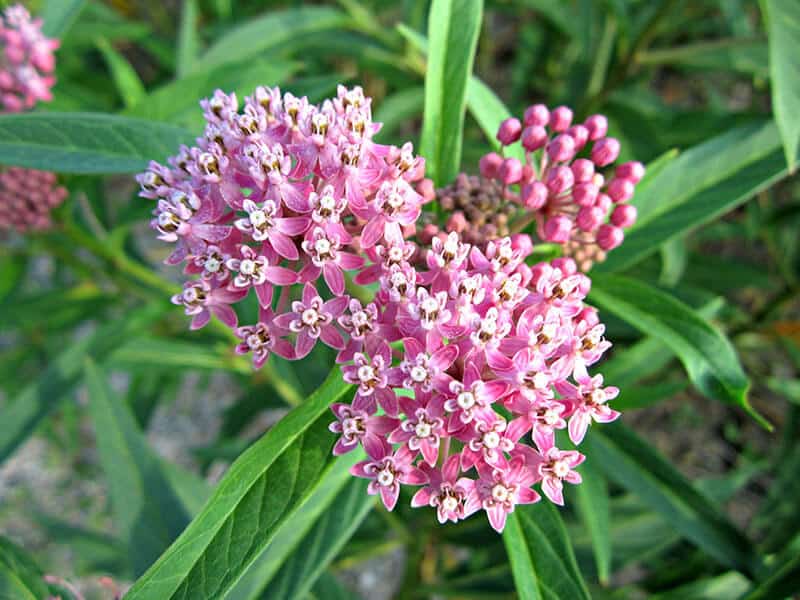
Asclepias syriaca or Purple Milkweed is a beautiful herbaceous perennial plant, attractive to butterflies. Butterflies use Asclepias syriaca as a host to lay eggs. Also, some types of green caterpillars feed specifically on Purple Milkweed, so the plant has enormous value to nature.
On average, Milkweed is between two and four feet tall. You can start it after the last frost, and the plant will spread faster. In late spring, you’ll be surprised by the aromas of pink-purple flowers!
19. Aster
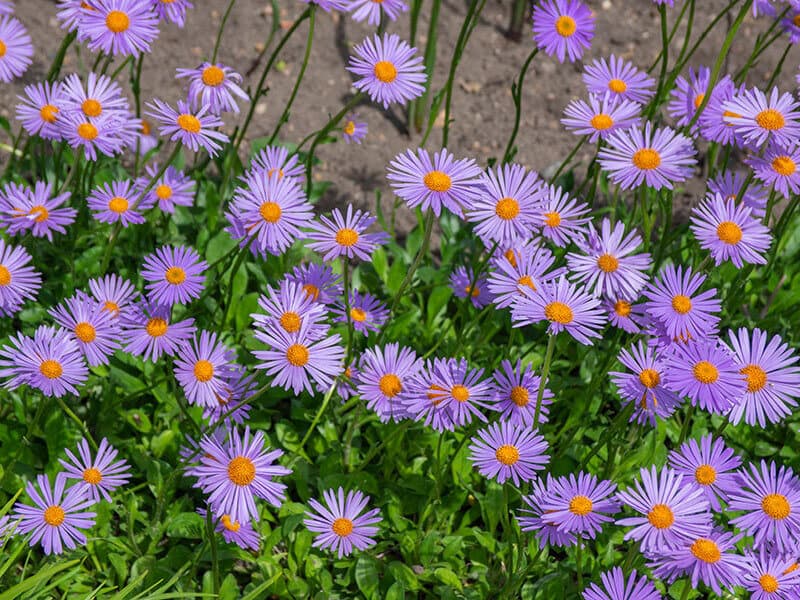
Beautiful Aster flowers come in a wide range of colors, including lilac, red, pink, and mauve. It belongs to Daisy’s family and has a fast-growing rate.
Aster is easy to grow. Pick a partial shade for your plants and moist and well-draining soil. If you want to encourage reblooming, regularly deadhead your spent flowers and cut the plant in the fall.
Another thing you can try is to pinch the new spring shoots when they appear in the spring to induce luscious blooms.
20. Astilbe
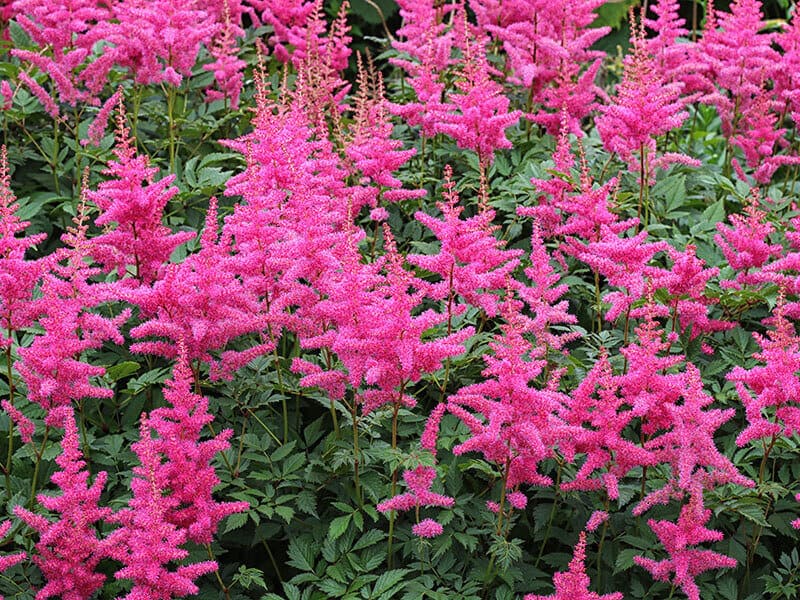
Astilbe plant is known under several names, including False Spirea and False Goat’s Beard.
Astilbes are the perfect choice for shade gardens and damp spots. In late spring, Astilbe produces beautiful fern-like foliage alongside feathery purplish flowers. They come in different sizes, and you can choose between 2-feet tall varieties, and dwarf cultivars. They need moisture to thrive, and if they are exposed to the sun, water your Astilbes frequently.
21. Astrantia
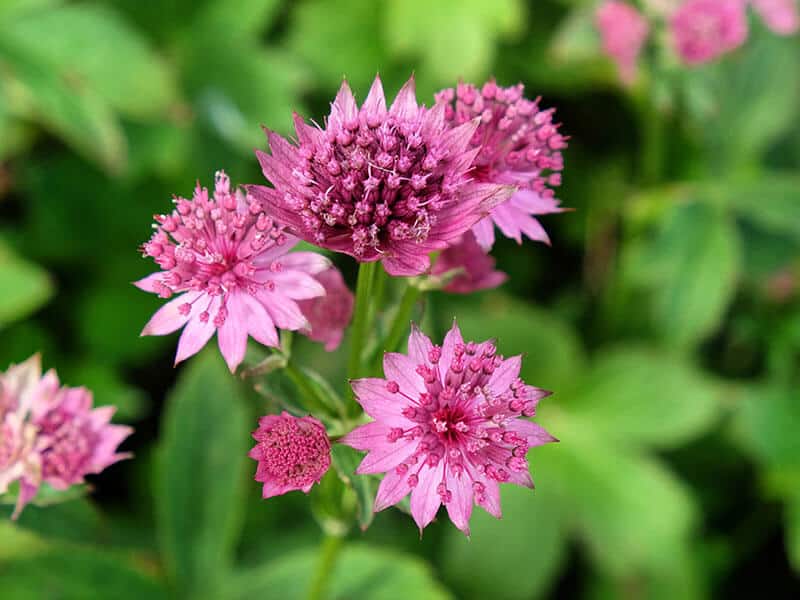
Astrantia or Masterwort is a charming garden plant, another part-shade lover. The plant prefers soil rich in organic material and needs consistent moisture.
Therefore, plant Astrantia where it will receive only the morning sun. If you plant Astrantia in the shaded area, the blooms might not be as lovely as you expect them to be.
Also, don’t forget to cut the plant back after blooming to induce a second flush of flowers.
22. Aubreita Deltoidea
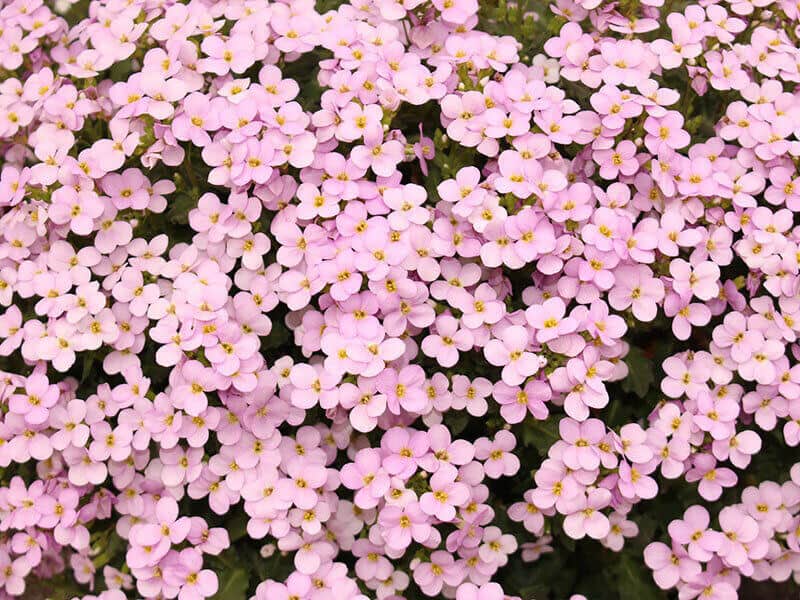
Aubreita deltoidea, shortly Aubreita, is a great plant to grow from seeds. Aubreita establishes easily and requires minimal care.
Once the seedlings appear, you should transplant them to a sunny spot with well-draining soil.
Timing is relevant when growing Aubreita. You can start the seeds indoors two months before the last frost or plant them in early spring.
Aubreita is well-known for its pretty violet, white and pink flowers.
23. Baby’s Breath
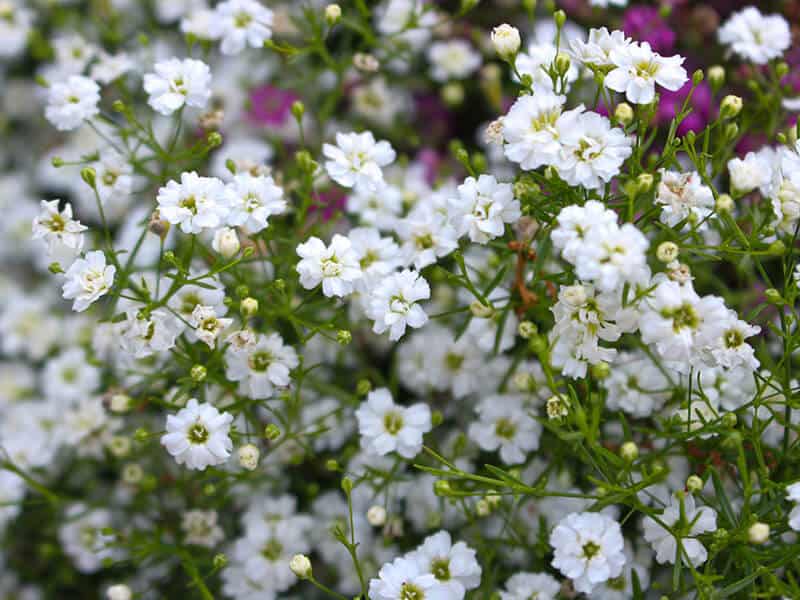
Baby’s Breath, or Gypsophila, is one of the easiest flowers to grow. It doesn’t need a lot of time to bloom, and it is common in bouquets, corsages, and other flower arrangements. You can use it as filler in your garden and enjoy its abundance of pink or white blooms.
Baby’s Breath flowers need moist, well-draining soil. Deadheading encourages re-blooming. Also, after the plants get established, avoid translation, because roots can suffer from shock.
24. Bachelor’s Button
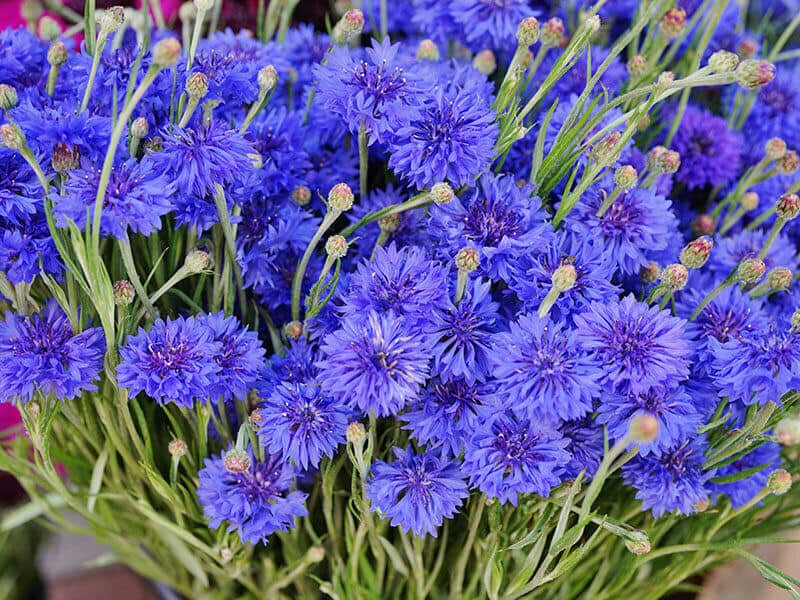
Bachelor’s Button flowers are easy to grow in all zones from two to 11. The plant is the perfect choice for people looking to add colors to their garden, without spending too much time caring for the plants!
Flowers are also called Cornflowers because they tend to pop on their own in the cornfields across the country.
Bachelor’s Button flowers can be grown from seeds. You can start seeds indoors, in full sun location and moist soil. Once you transplant the seedlings to garden soil, your plants will require minimal care.
25. Balloon Flower
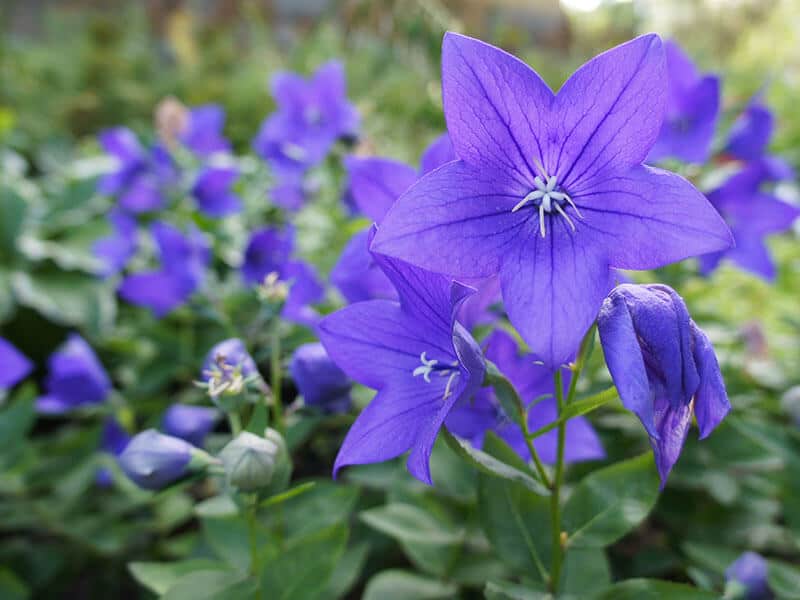
If you love purple flowers, you will adore Balloon Flower and its cold-hardy nature. It is suitable for cold and warm regions, as long as you pick the location well. If you grow Balloon flowers in a colder area, choose the full sun and plant them in partial shade in hot climates.
The plant needs a lot of moisture and well-draining soil to grow and produce spectacular purple blooms.
26. Bee Balm Flower
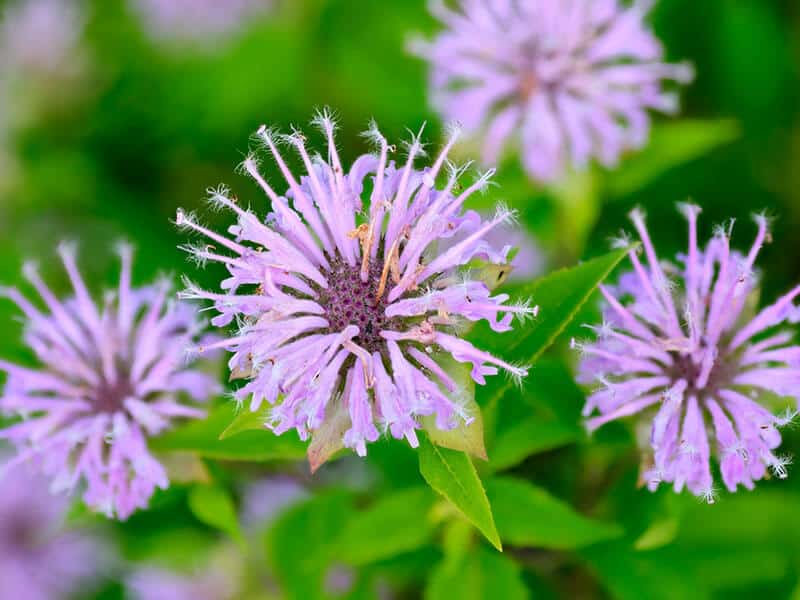
Bee balm flower or Monarda is an all-time American favorite, a native and low-maintenance garden plant. People love it because of its pink, white and purple blooms and catching aroma.
The flower attracts hummingbirds and bees and provides year-round interest with minimal effort. The ideal growing conditions for Bee balm flowers are well-draining soil, full sun location, and moderate moisture.
27. Begonia
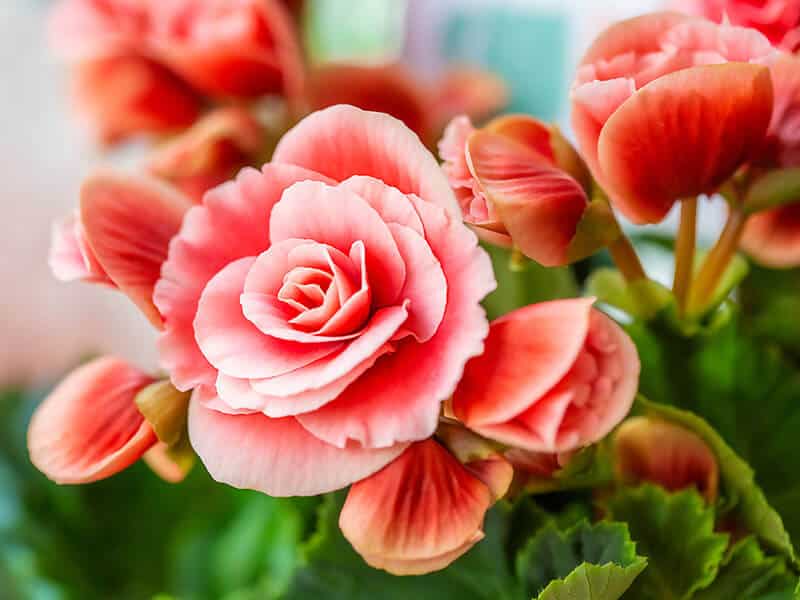
Begoniaceae, shortly Begonia, features colors in bright shades of orange, pink, white, red, and yellow. You can grow different types of Begonias in your garden or as houseplants even if you are a beginner in gardening.
They need sunlight to grow, but too much direct sunlight will burn the foliage and flowers.
You can also grow them in a DIY greenhouse in partial shade. Begonias with tubers look pretty in hanging baskets or pots on the patio.
You can see this video to know more:
28. Bellflower
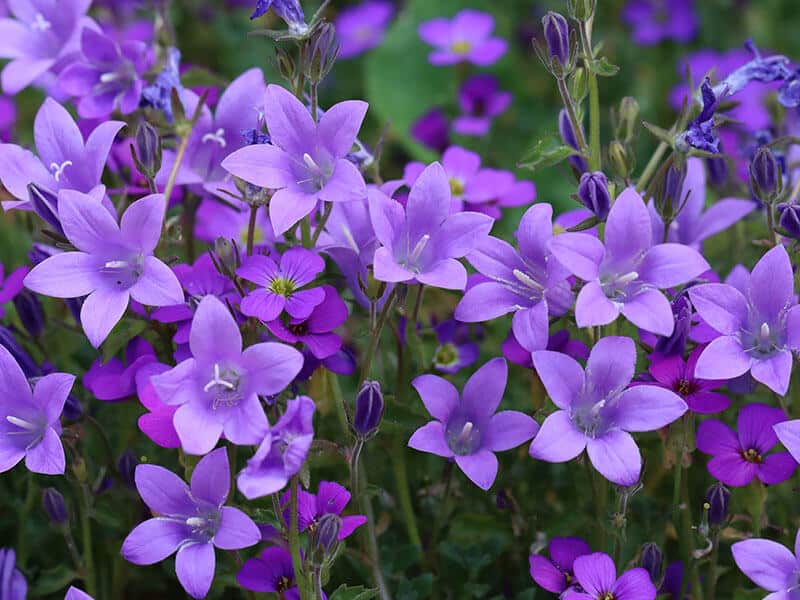
Bellflower or Campanula ensures a dazzling landscape in June and July. But, if you take good care of your Bellflowers, the blooming season may extend up to October.
These lovely flowers look best in garden borders or rock gardens. Their alpine nature thrives in cool and moist soil, with a tiny layer of compost. You can also mulch to help the soil retain moisture.
29. Bergenia
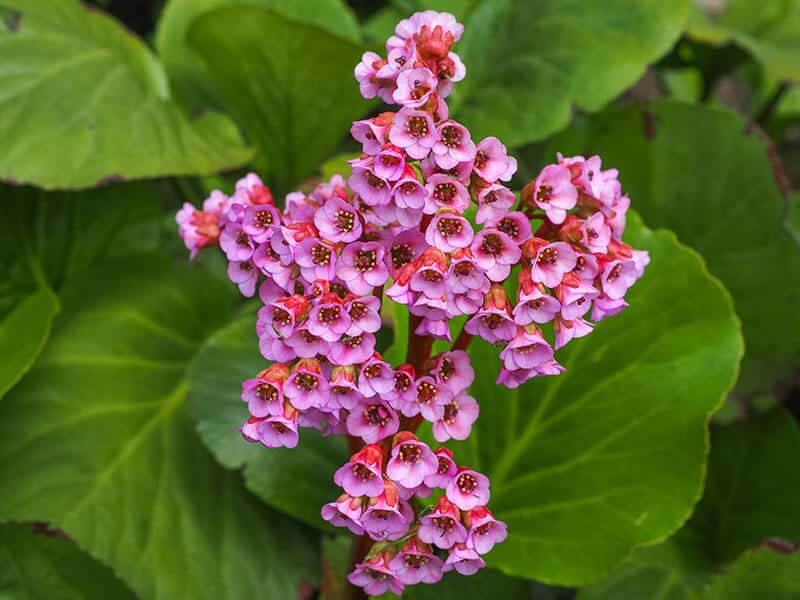
Bergenia or Saxifragas grows slowly and needs propagation approximately every three years. You can propagate the plant by division easily.
The plant isn’t picky about light exposure. But, the soil needs to be fast-draining, to prevent rotting and fungal diseases. An annual dose of mulch will induce foliage growth, and regular deadheading will help the plant remain attractive.
30. Black-Eyed Susan
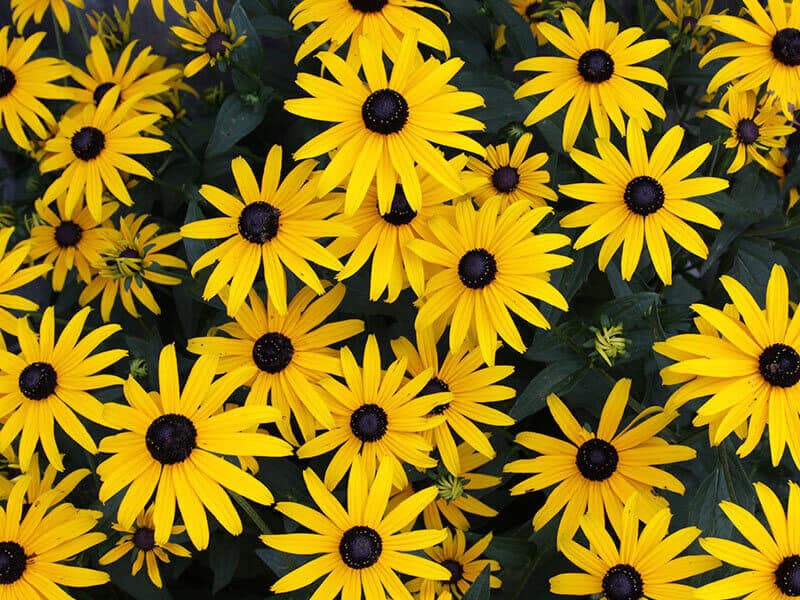
Black-Eyed Susan or Rudbeckia is one of the most popular flowers in the USA. It is easy to identify through the large and dark center surrounded by symmetrical petals. The blooming season lasts all summer, and bees and pollinators are attracted to the sweet nectar in the flowers.
Black-Eyed Susan is relatively easy to grow. You should never let the plant dry completely, so check the soil to see if it needs watering.
During irrigation, only water the plants in the base to prevent diseases.
31. Blanket Flower

Blanket flowers, or Gaillardia, belong to the Daisy family and are a colorful addition to flower beds. They are relatively easy to grow from seeds or seedlings. Most nurseries offer blanket flowers in red and yellow colors.
If you decide to grow them from seeds, keep them moist to induce germination. Transplant the seedlings in full sun, and don’t overwater your plants. Mature Blanket flowers are relatively drought tolerant.
32. Blazing Star
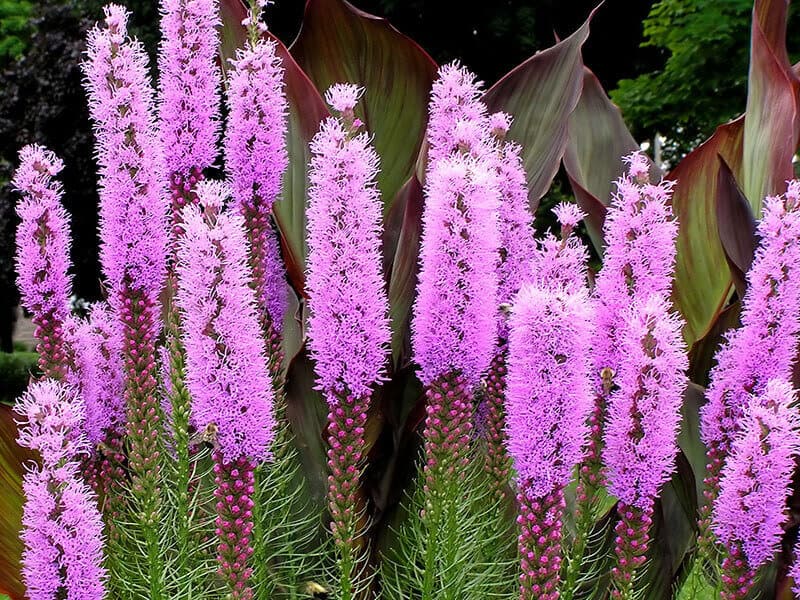
Blazing star or Gayfeather is a beautiful wildflower perennial. It is best known for its extended blooming season.
True Blazing star flowers are bright purple, but modern nurseries also offer pink and white varieties.
You can buy an established plant or start it from seeds. In the first case, expect your Blazing star to bloom in the first year. If you choose to grow it from seeds, your Blazing star will need a few years to get established.
33. Bleeding Heart

A Bleeding heart is one of the prettiest early spring bloomers. It features pink flowers in the shapes of hearts produced on arching stems. But, you can also find some cultivars with white or pale flowers and beautiful emerald leaves.
Growing a Bleeding heart isn’t difficult. Keep the soil moist and rich in organic matter. A shade or partial shade area will work great for the flowers.
34. Bluebell
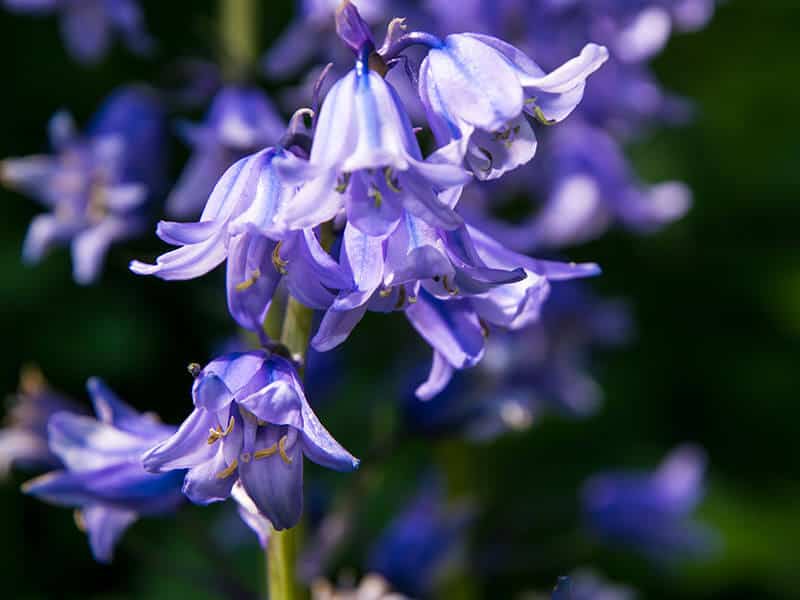
Bluebells are the perfect choice for growing under deciduous trees and in shade areas. They don’t mind deeper shade, and the lack of sunlight doesn’t affect their blooming capacity.
Your Bluebells will thrive in humus-rich and evenly moist soil. It should be fast-draining soil, but you should never let it dry out between waterings.
The easiest way to grow Bluebells (internal link keyword “How to grow Bluebells”) is from seedlings, but you will also have great success growing them from seeds.
35. Blue-Eyed Grass
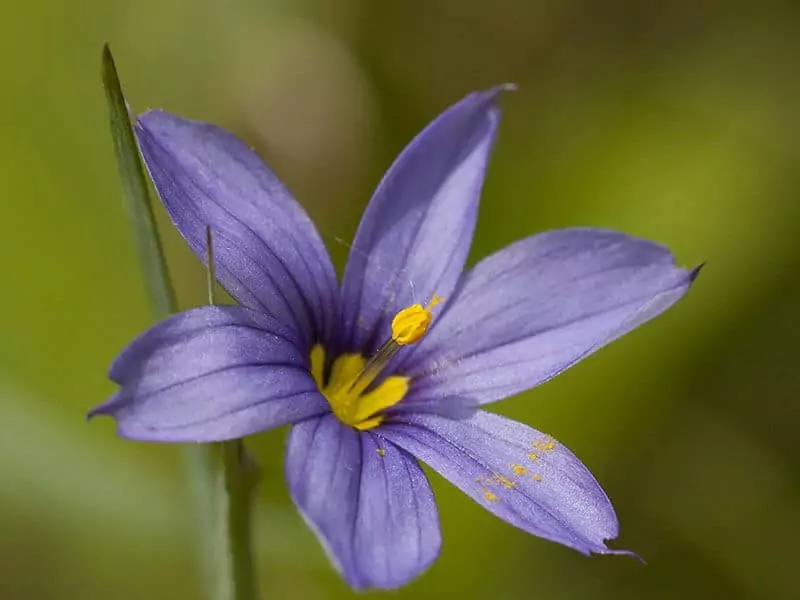
Blue-eyed grass is a common perennial herb that you can come across in California. The average height is about one foot, and the flower colors vary from deep purple to bluish purple and bright shade.
The grass is tolerant of sand and clay soil, so it is versatile. Next, this easy-care plant is tolerant of cold temperatures and drought. It adds a charming pop of color when you plant it in the garden borders.
36. Blue Star Flower
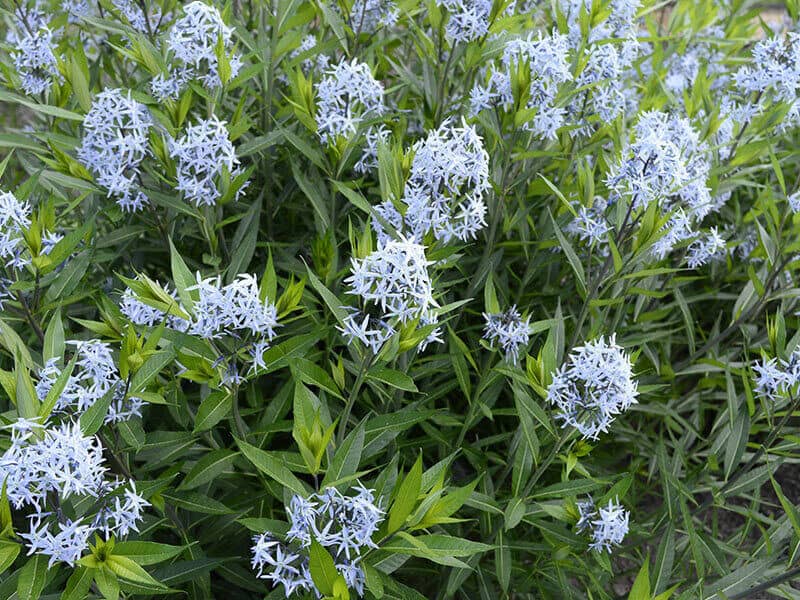
The Blue star flower is easy to grow from seeds. The process is lengthy but simple. You can start the seeds in fall, keep them protected during winter, and transplant them into garden soil in early spring.
However, developed Blue star flowers are available in modern nurseries for transplantation. If you choose that option, you can expect them to grow to their full potential in about two years.
The plant prefers a hot and humid climate with full sun exposure. Once your Blue star flower gets established it requires almost no care.
Amsonia is the scientific name of the plant.
37. Bouvardia
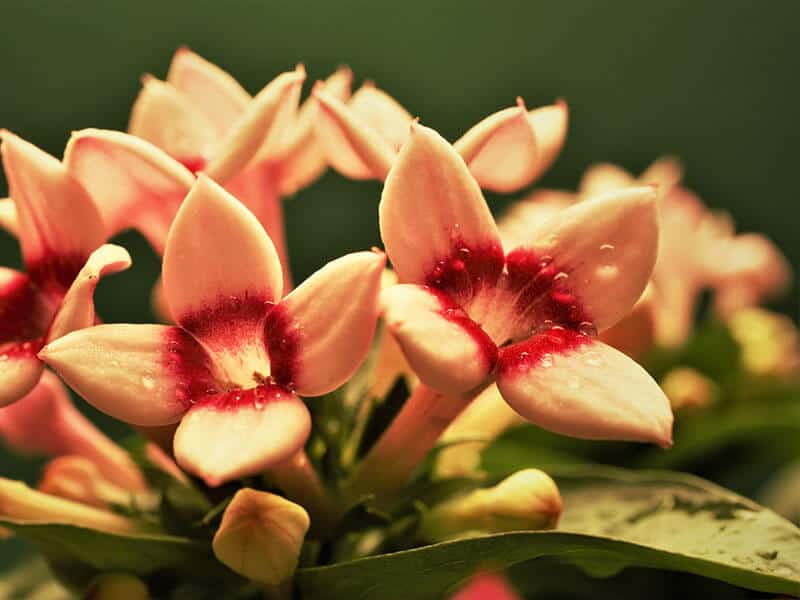
Bouvardia is an excellent choice if you need to attract pollinators and hummingbirds to your garden. It is an attractive perennial plant with a shrub-forming habit and pretty tubular flower clusters.
Bouvardia needs well-drained, rich soil with full sun exposure. It is also an easy plant to grow indoors. Also, allow the top two inches of soil to dry between waterings. Keep the Bouvardia in temperatures above 50 degrees Fahrenheit and sudden drafts to prevent foliage from dropping.
38. Buddleia
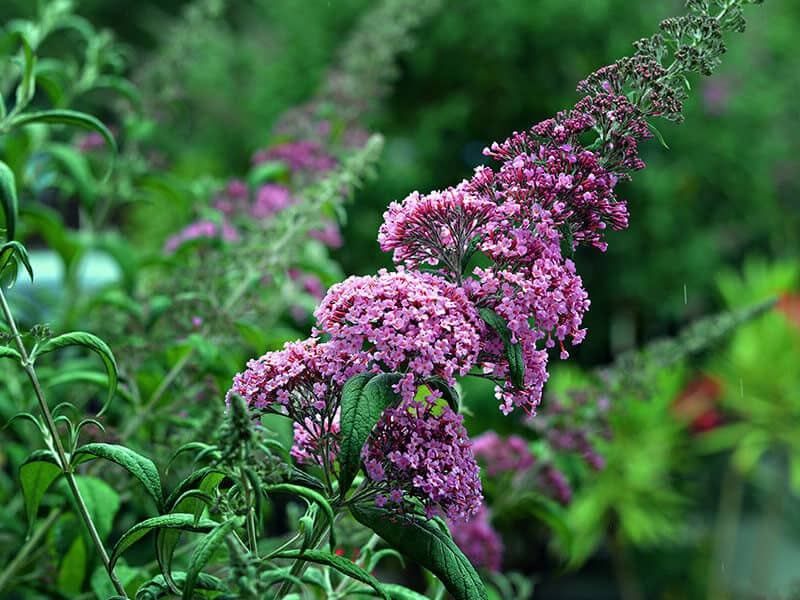
Buddleia or Butterfly bush is one of the most widely spread favorite flowering bushes. Overall, the bush is easy to care for and grows relatively fast in a sunny location and with well-draining soil.
You can choose between large and small Buddleia varieties (internal link keyword: “Buddleia varieties”) and a beautiful range of flower colors. Most common are purple flowers, but you can find pink, white, blue, and yellow Buddleia blooms.
The blooming season starts in late summer and lasts about six weeks.
39. Buttercup
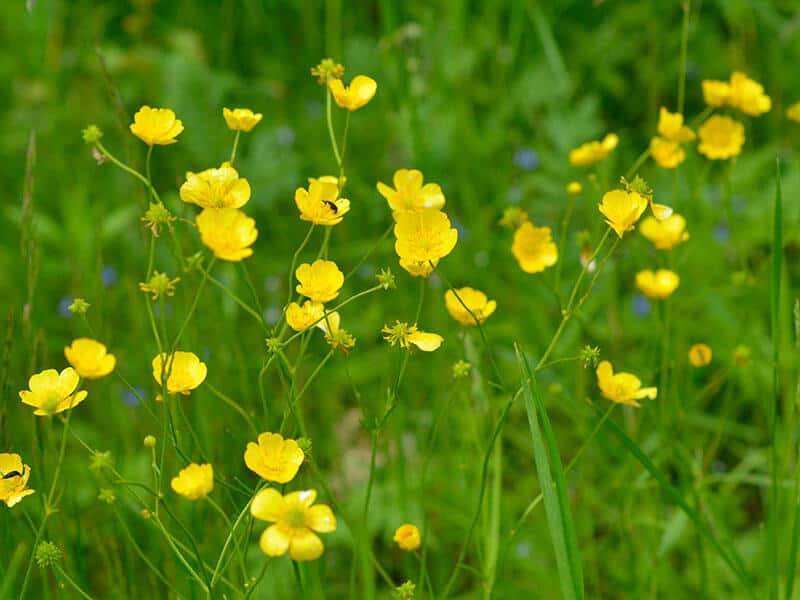
Buttercup flowers can be found all around the world.
Buttercup isn’t a difficult plant to grow. But, it is picky about soil type because it needs light soil with excellent drainage. The soil should be overly warm as well.
If you grow Buttercups in a tropical climate, don’t forget to mulch around the base. It will prevent the soil from getting too hot. Buttercups flowers come in red, white, orange, yellow, and green colors.
40. Calendula
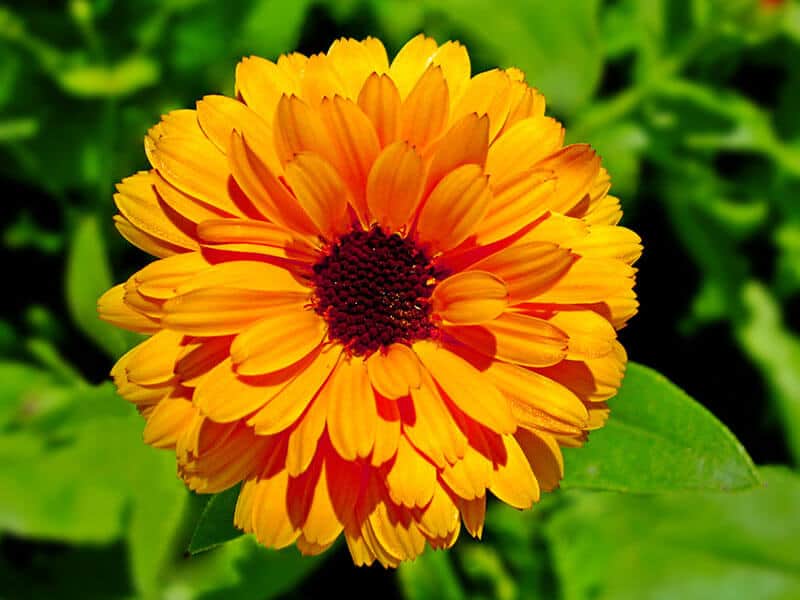
Calendula gives a warm and sunny character to your garden. It is easy to grow from seeds and needs about six weeks to grow to the desired size. The plant has a moderately sprawling habit, but it is far away from being considered invasive.
The best thing about Calendula is its abundance of yellow blooms! Even though they are short-living, you can deadhead the plant to ensure continuous blooms. Nowadays, you can find varieties of Calendula with apricot, orange, tawny red flowers, and even double petals.
They are great as an accent plant on garden borders.
41. California Poppy
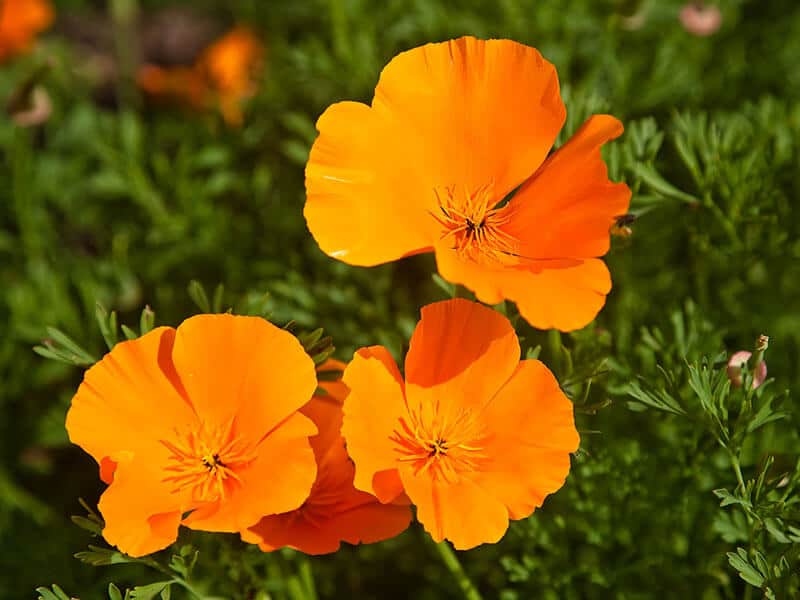
In the early summer, California poppies are at their best! The stunning rich bright flowers develop in sandy and well-draining soil. They don’t need long to mature, and you can choose between pink, white, orange, and bright yellow flowers.
Plant them where they will receive at least six hours of sunlight per day to ensure the best results. Without enough sunlight, your California poppies will look raggy and the flowers won’t be as beautiful as possible.
In addition, because of their excellent tolerance to drought, California poppies are a good choice for Xeriscape gardens and other garden types (internal link keyword “Types of gardens”) suitable for dry climates.
42. Calla Lily
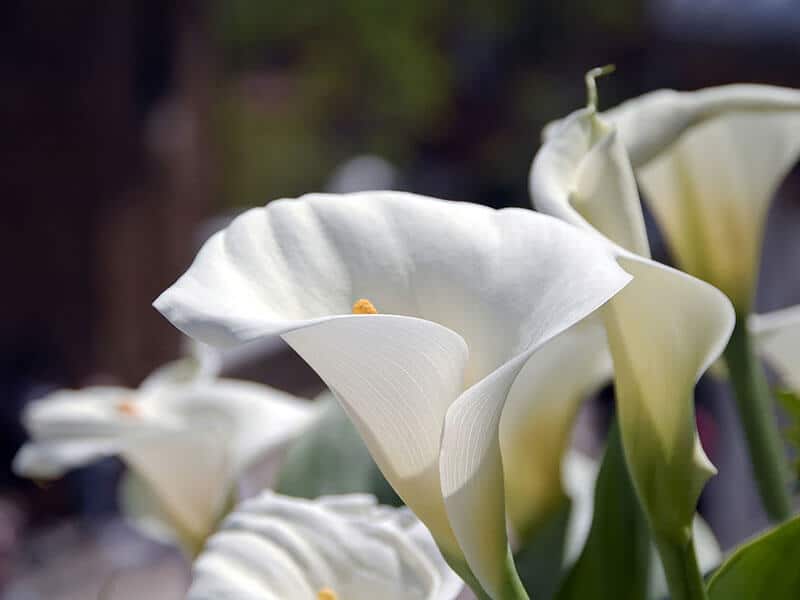
Calla lilies are wonderful plants, but surprisingly, they don’t need complex care to bloom. When planting Calla lilies, choose large and healthy rhizomes. Keep in mind that larger rhizomes will produce larger plants and richer flowers.
Choosing a location for Calla lilies is simple. If you live in a cool climate, choose the full sun. Plant them in partial shade in warm climates. Consistent moisture ensures glorious results!
43. Candytuft
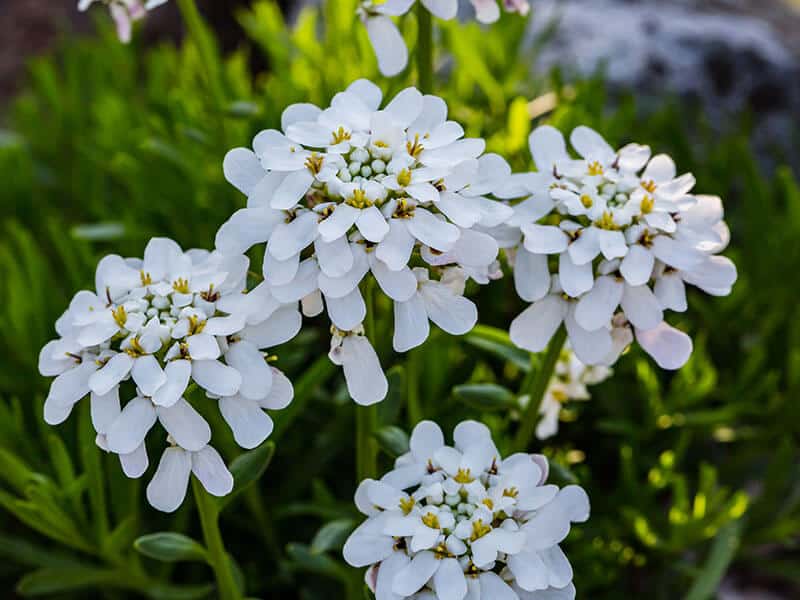
The beautiful Candytuft plant is native to Europe, but it grows in almost all USDA zones without issues. In the mature stage, Candytuft is between 12 and 18 inches tall.
The key to getting those lush blooms is to plant Candytuft in a full sun location with well-draining soil. Alkaline soil is preferable, but your Candytuft will grow well in neutral soil.
If the plant doesn’t bloom in early spring, it is because the soil is too damp or Candytuft doesn’t receive enough sunlight.
44. Canna Lily
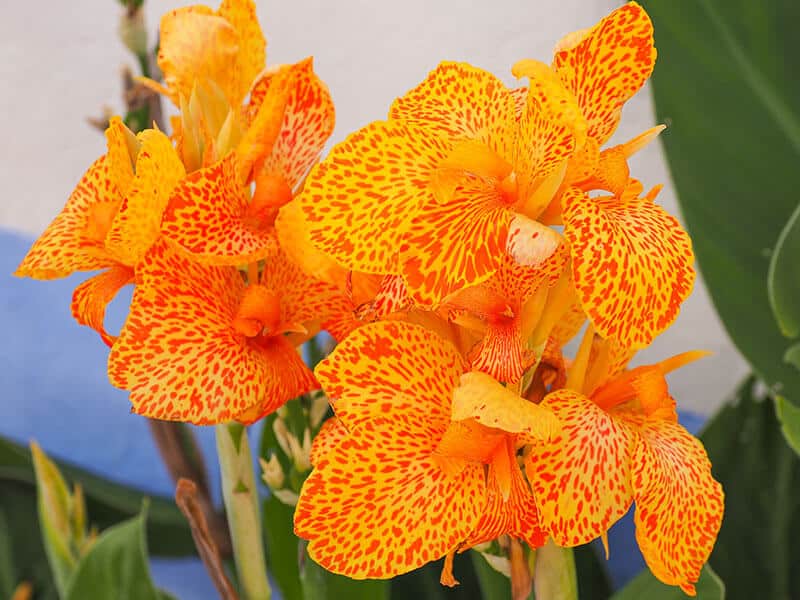
Canna lilies are ideal for warm climates. They like heat, and full sun location makes an excellent growing environment. Cannas aren’t particularly picky about soil. They will tolerate any neutral or slightly acidic soil.
In addition, well-draining soil and plenty of moisture are suitable for growing the most beautiful Canna lilies. They might survive in the shade, but the blooms won’t be very showy.
45. Cape Primrose

Cape Primrose is a relative of African violets. It will provide you with an abundance of flowers during the long blooming season. But, the soil needs to remain slightly moist and the plants need consistent, indirect sunlight.
There are numerous Cape Primrose hybrids with various size flowers and attractive foliage. Some nurseries sell dwarf Cape Primrose, and trailing varieties are also available.
46. Cardinal Flower
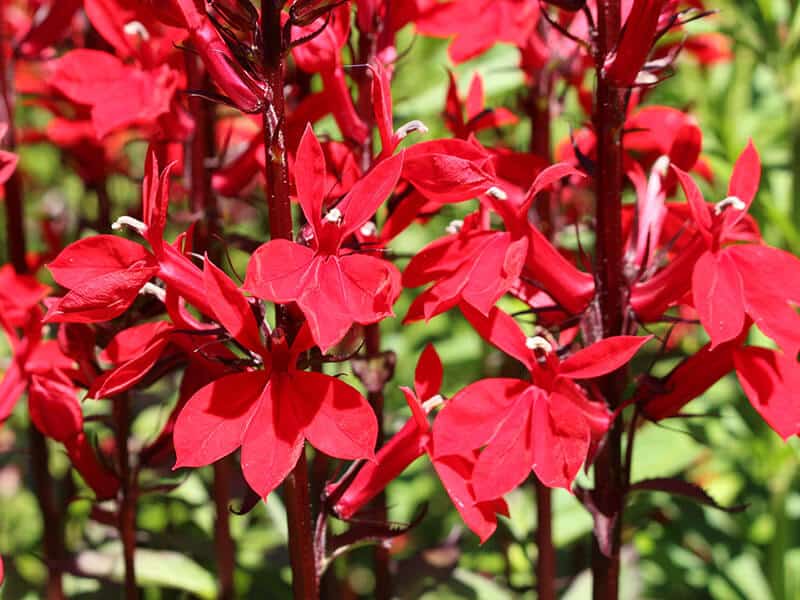
The Cardinal flower is a popular perennial which grows between one and six feet tall. The flowers are beautiful with low and upright petals. The plant got its name from the unique red shade of the blooms, which resembles the robes worn by Catholic cardinals.
Cardinal flowers is an attractive wildflower and blooms from May to October. It has moderate watering needs, and the plants tolerate excessive heat and cold.
47. Carnation
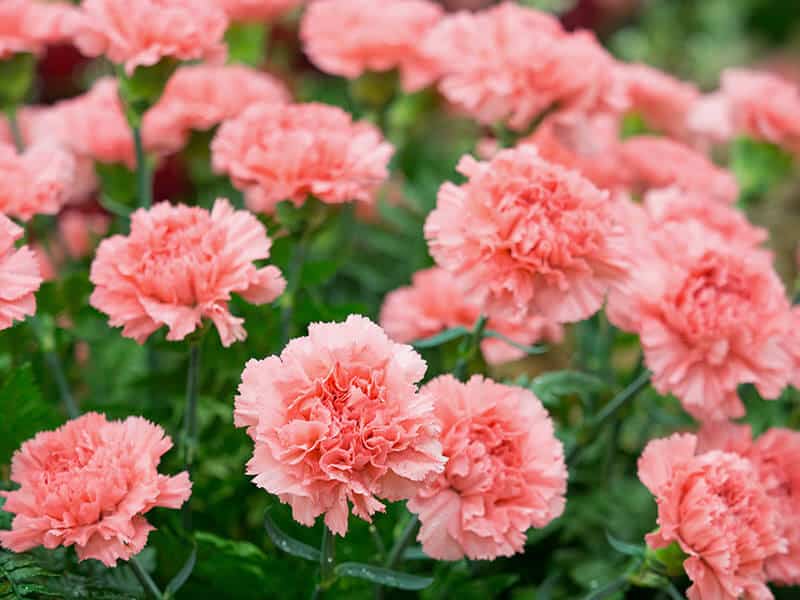
Carnations are available in an amazing color range. Some of the most popular colors are pink, red, scarlet, yellow, and white. In general, carnations symbolize purity and luck, but each flower color has more specific symbolism.
You can easily grace your garden with the beautiful Carnations. Ensure they get around four to six hours of sunlight and moderate moisture. Carnations grow best in fertile soil, with a slightly alkaline pH value.
48. Celosia
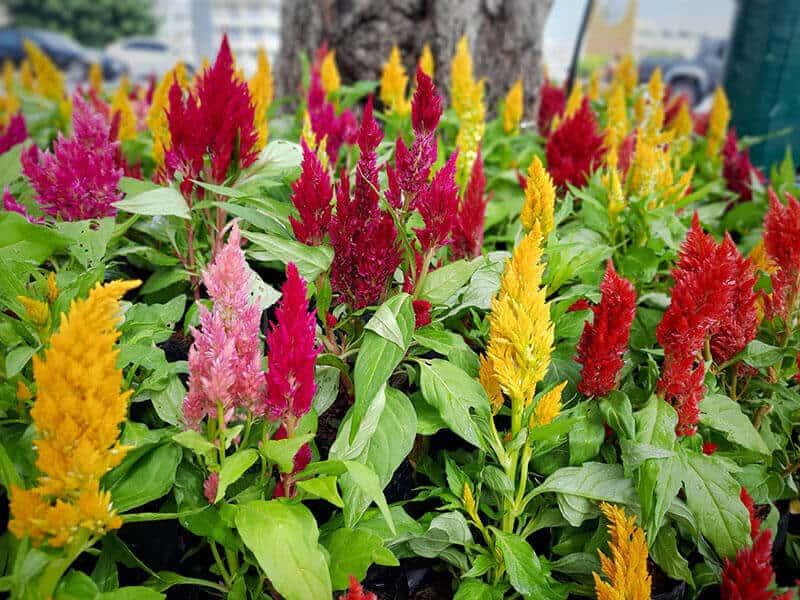
Celosia or Cock’s flower is a tender perennial, which adores summer sun and makes a beautiful cut flower. It also looks attractive when you dry it and can be used for various floral arrangements.
Celosia isn’t a fussy plant to grow. It needs six hours of sunlight per day and well-draining and rich soil. Taller varieties need staking, and you can use a pea trellis stake or a bamboo stake to support the plant.
49. Chrysanthemum
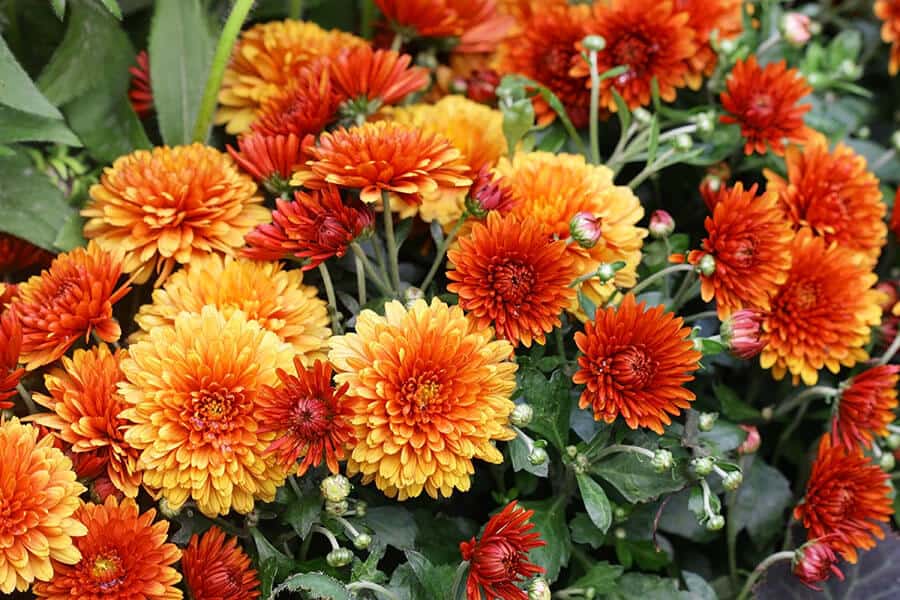
If you are looking for attractive fall-blooming plants, Chrysanthemums will definitely bring you joy! They are often called Belgian mums and are available in a huge range of colors, and all of them are relatively easy to grow.
Chrysanthemums grow best in well-draining soil nurtured with well-rotted manure. These lovely flowers prefer a sunny but protected spot and need staking for support. During winter, you have to lift the plants, cut them, and store them in a dry and protected spot without danger of frost.
50. Clarkia

On average, Clarkia grows between one and three feet tall. This wildflower is native to North America and features lovely pink or pink and white flowers. In most climates, Clarkia blooms in summer and fall, but in mild climates, blooms might appear in winter, too.
Clarkias are easy flowers to grow. Young plants need consistent moisture, but adult plants are drought-tolerant. Pick partial shade or full sun location for the plants.
51. Clematis
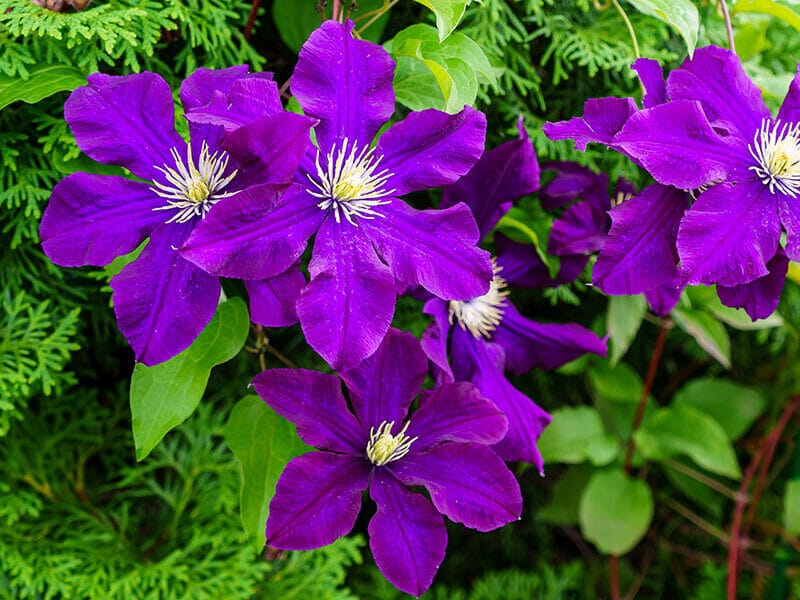
Pick a sunny location for your Clematis vine to ensure the best growth potential for the plant. Some Clematis cultivars may survive and bloom in the shade.
Clematis is also a great vine to grow in a pot, with compost-rich potting soil. In the garden, you can amend the soil with wood ash. Also, don’t forget to provide your Clematis with a supporting structure!
52. Clover
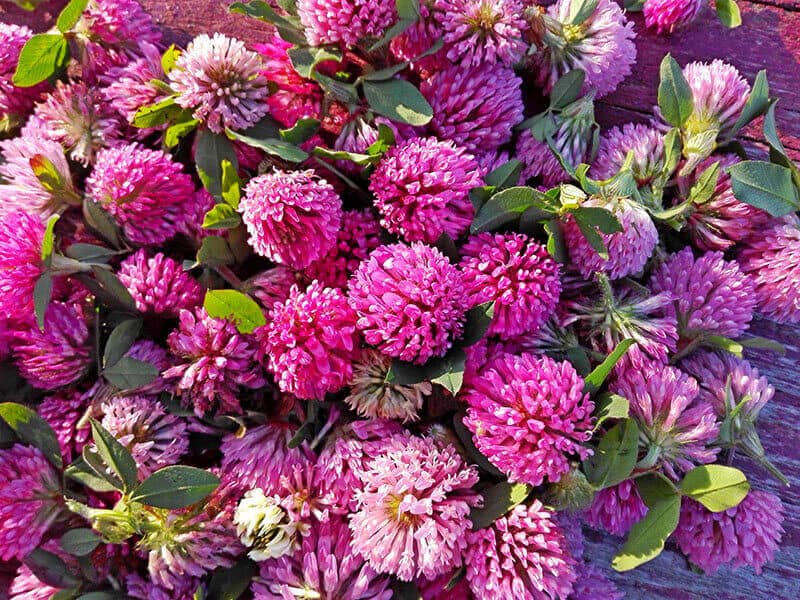
Clover is a short-living plant with small and fragrant blooms. Flowers are white, pink, red, or yellow and are commonly planted around the lawn. You can also grow them in the shade, to add a charming pop of color where other plants cannot bloom.
Clover is easy to grow from seeds, and seeds need only ten days to germinate.
53. Coneflower
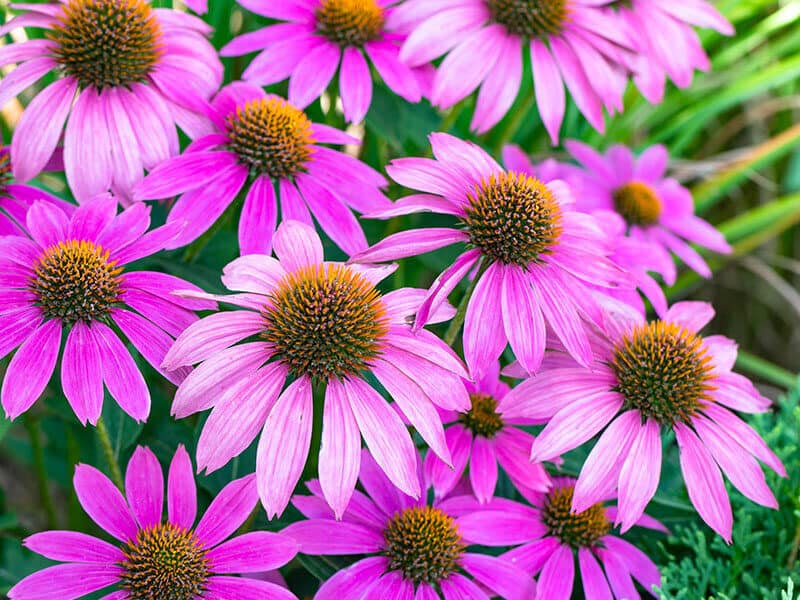
Coneflowers belong to the family of Daisies. They are bright and cheerful flowers, and one of the most beautiful purple flowers in Texas and beyond. Purple Coneflowers are the most common, but you can also find Coneflowers in other bright flower colors.
The plant is also known under the name Echinacea and is a great, deer-resistant plant. The exact growing conditions for Coneflowers depend on the exact cultivar you plant, but pay attention to proper spacing and give your plant around two years to establish and bloom.
54. Coral Bells
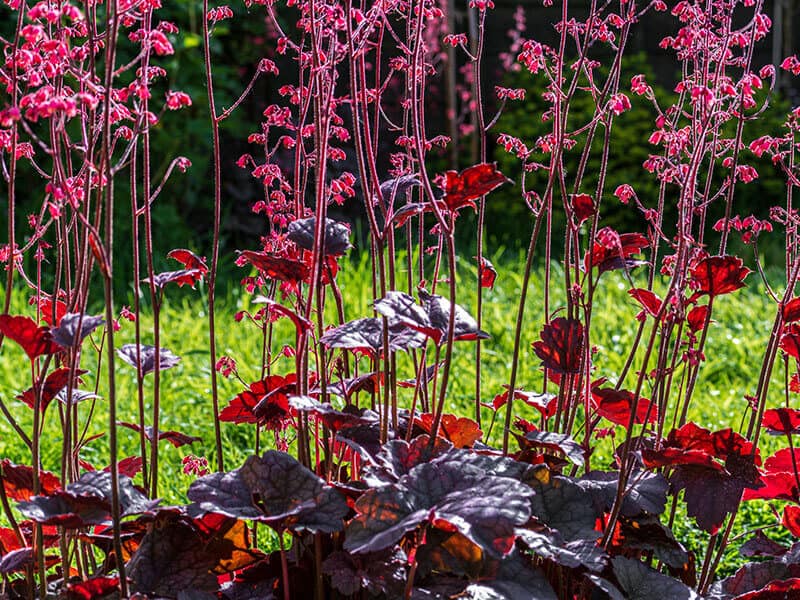
Even though the Coral bell plant is primarily grown for its attractive foliage, a few people know it for its tiny blooms. The leaves are large, brightly colored, variegated, and evergreen. That is why Coral bell is an excellent plant for adding year-round interest to your landscape.
You can combine them with other shade-loving plants to design an attractive landscape. Flowers are known to attract hummingbirds, which is always an additional plus!
55. Cotoneaster
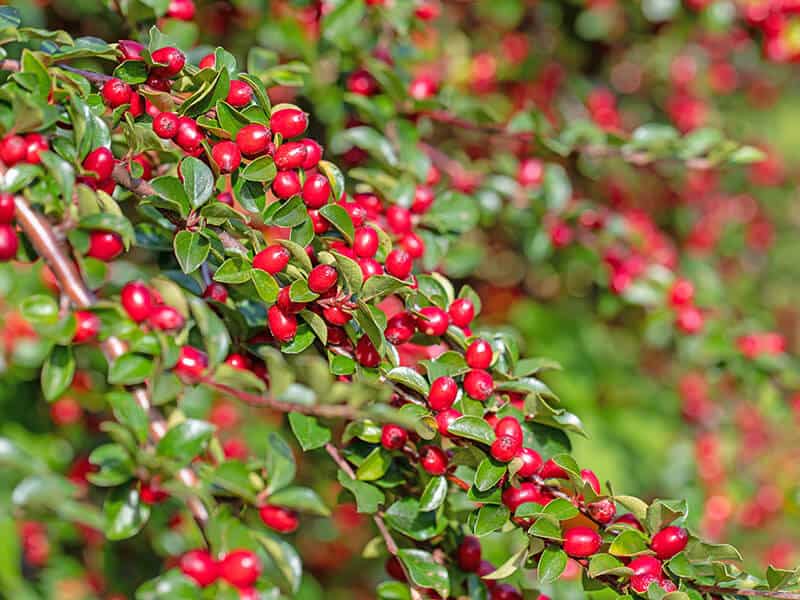
The best time to plant Cotoneaster is fall because the soil is warm and moist. Therefore, roots will establish before temperatures drop. Overall, Cotoneaster is low-maintenance.
Only water the plant during dry spells. In addition, fertilization is optional.
Weed control is important for Cotoneaster shrubs. You can mulch around the plant to suppress weeds.
56. Cranesbill Geranium
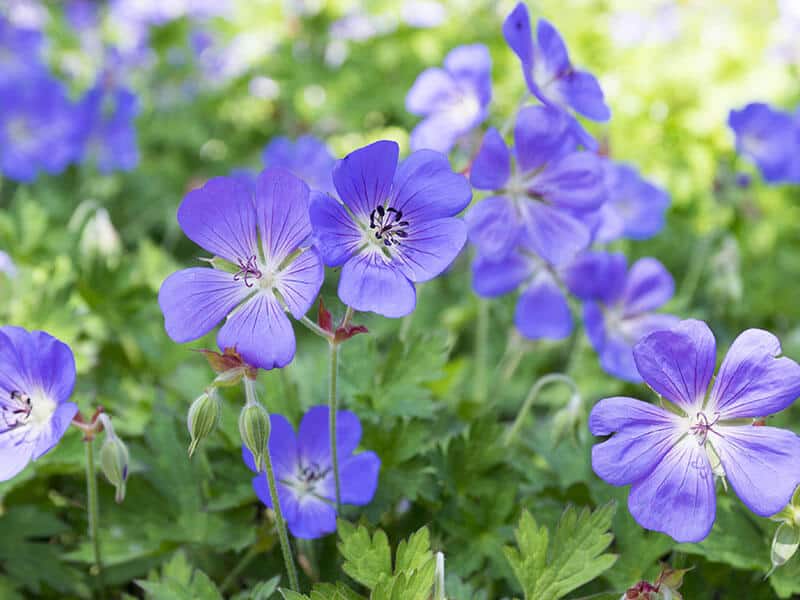
Cranesbill Geranium is often called Hardy or Cranesbill Geranium. Humus-rich and loamy soil with consistent moisture are good for the plant. You can plant Hardy Geranium (internal link keyword: “How to grow Geraniums”) in light shade.
There are various Cranesbill Geranium cultivars, but all varieties classify as taller and fast-growing shrubs. Their average yearly growth rate is between 12 and 20 inches per year.
57. Creeping Phlox
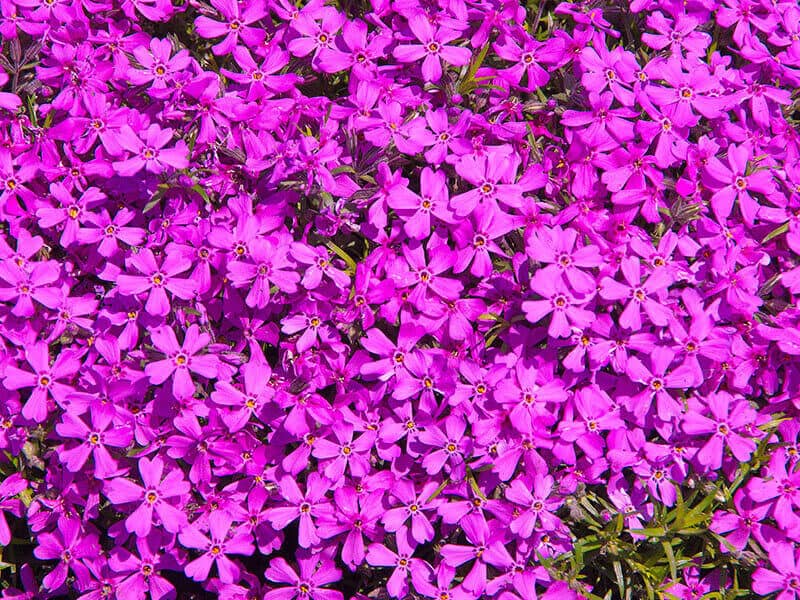
You don’t have to be a gardening expert to grow Creeping Phlox and enjoy the attractive appearance of this stunning cascading plant! The blooming season starts in spring, and Phlox develops lavender, purplish-bluish, red or yellow flowers.
You can grow Creeping Phlox in a container or the garden as one of the most beautiful flowering groundcovers.
Creeping Phlox is an easy-going and adaptable plant. It can tolerate a variety of soil types. Ideally, it needs a sunny location, moderate moisture, and excellent drainage.
58. Crocosmia
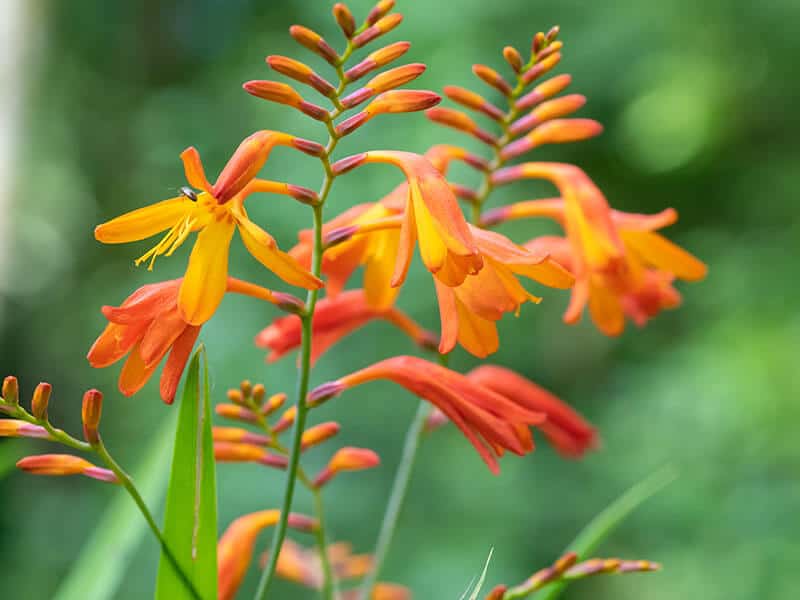
Crocosmia or Montbretia is a beautiful, exotic plant that develops attractive tubular flowers in bright shades of scarlet red, yellow, and orange color. The flowers appear in summer and remain fresh for five to eight weeks.
Despite its unusual appearance, Crocosmia has standard growing requirements. These include full sun location, protection from harsh winds, and rich soil. Watering your plant once a week is enough to keep it thriving.
59. Crocus
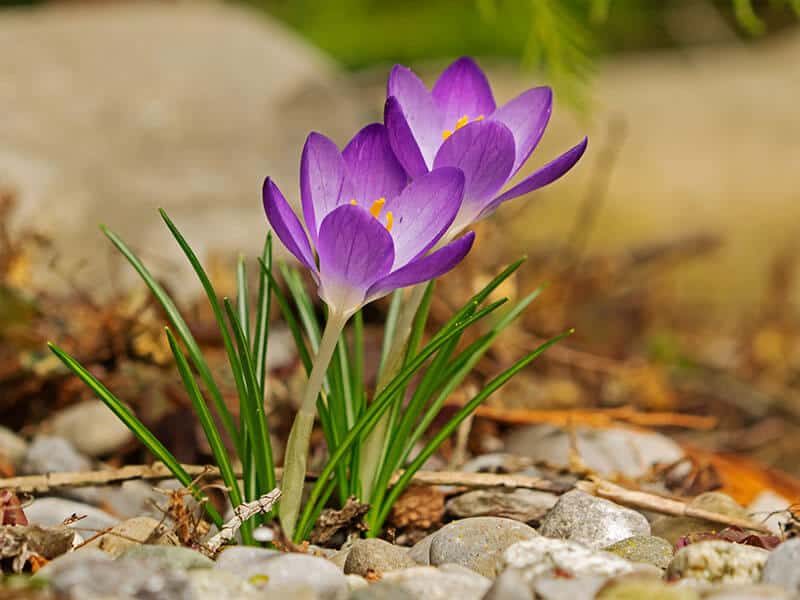
If you need something to announce the beginning of the spring brightly and colorfully, Crocus is your pick!
It belongs to the family of Iris and develops spectacular six-petalled flowers with colorful centers. Crocus need is a short plant, which rarely grows over six inches.
The plant can grow in full sun or partial shade locations and requires loose soil mixed with compost to grow. Crocus is attractive to mice, voles, and squirrels and your best chance to protect the plant from these pests is to add chicken wire.
60. Crown Imperial
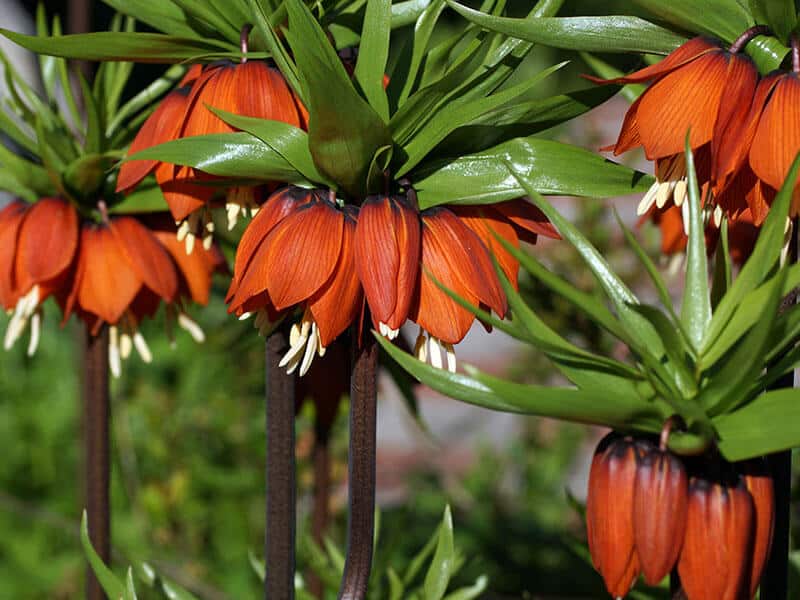
Crown Imperial is a popular bulbous plant that thrives on a gravel bed and needs at least six hours of sunlight per day. The plant is easy to start from divided bulb clumps, and can quickly become a focal point in your garden.
The plant is tall and reaches between three to four feet in average quality soil.
Crown Imperial is also attractive to wildlife and doesn’t have any toxic characteristics.
61. Cuckoo Flower
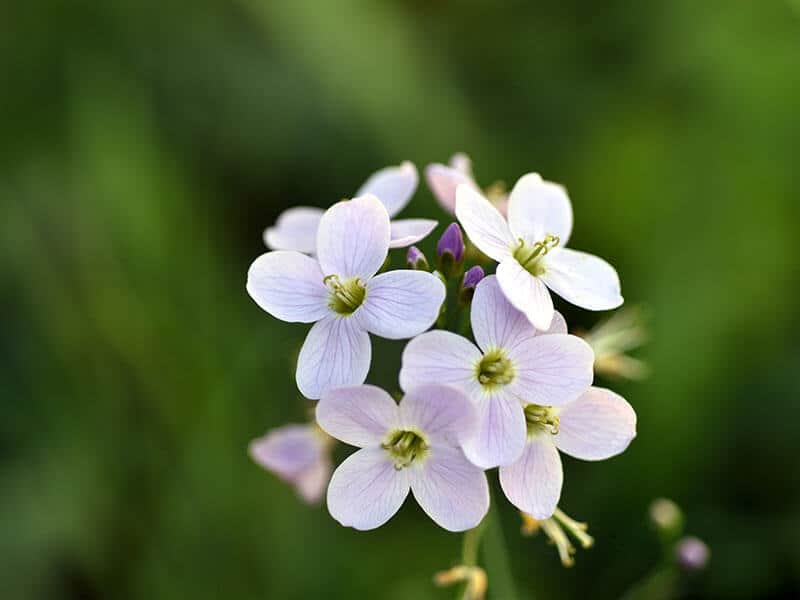
Cuckoo Flower or Cardamine pratensis appears in April but looks most beautiful during the blooming season in May and June.
The plant develops pinkish purple and pale flowers, which you can often see in wet meadows, forming an attractive flower carpet.
You can start it from seeds or by division, and the plant will adapt to most conditions in your garden.
62. Cyclamen
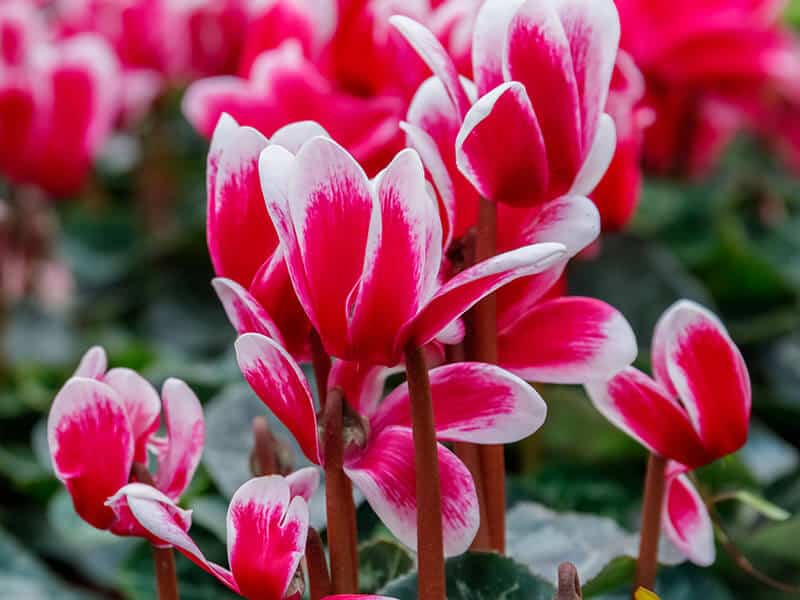
Cyclamens are cool-hardy plants that don’t mind growing in poor soil. They can also grow well in full or partial shade. The plants only respond poorly to waterlogged soil. If that is the case with your garden, grow Cyclamens in pots.
Plants are attractive for their blooms but also for their lovely flowers. There are quite a few Cyclamen varieties worth your consideration (internal link keyword “Types of Cyclamen”).
63. Daffodil
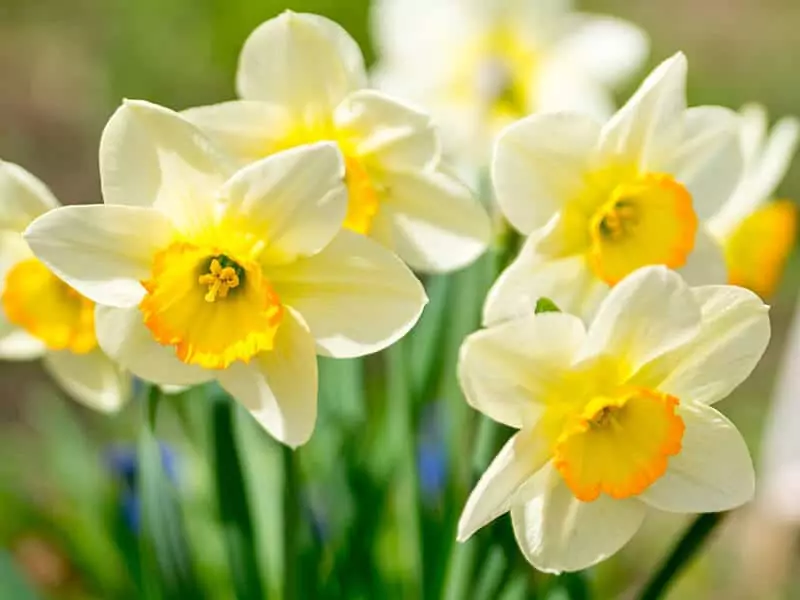
If you want to enjoy a burst of sunny color in spring, don’t miss the chance to plant Daffodils in the fall. They are hardy in zones three to eight and enjoy full sun or partial shade. Daffodils aren’t specifically picky about soil type, but good drainage is preferable.
These plants don’t like having wet feet, even though they enjoy a good deal of water. But, keep the soil on the drier side during the blooming season.
64. Dahlia
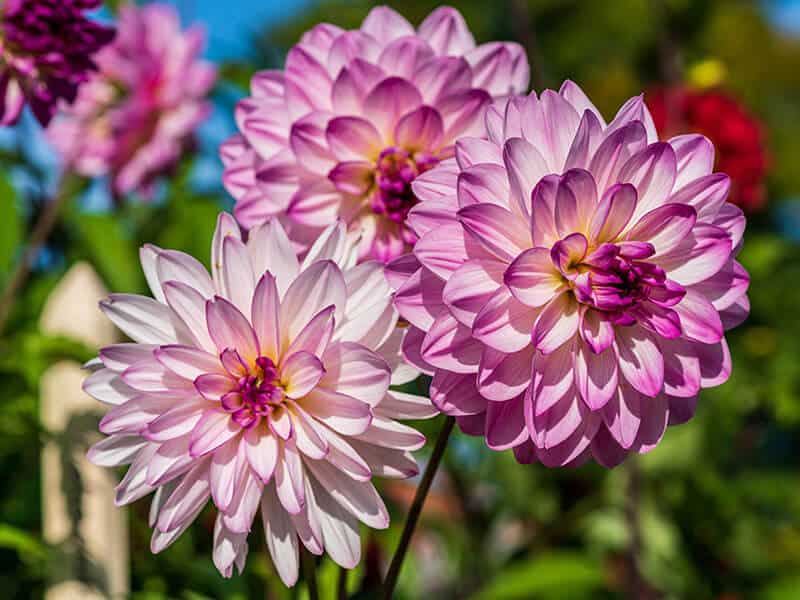
If you need gorgeous flowers to decorate your garden or patio from midsummer through autumn, pick Dahlias. They are available in a wide range of colors, and different sizes. But, most varieties won’t grow more than five feet tall.
Dahlias bloom the best in mid-July and plant around eight weeks before that. The soil should be slightly warm, and you can amend it with low-nitrogen fertilizer for best results. Be careful not to overfertilize, because it can burn the roots.
65. Daphne
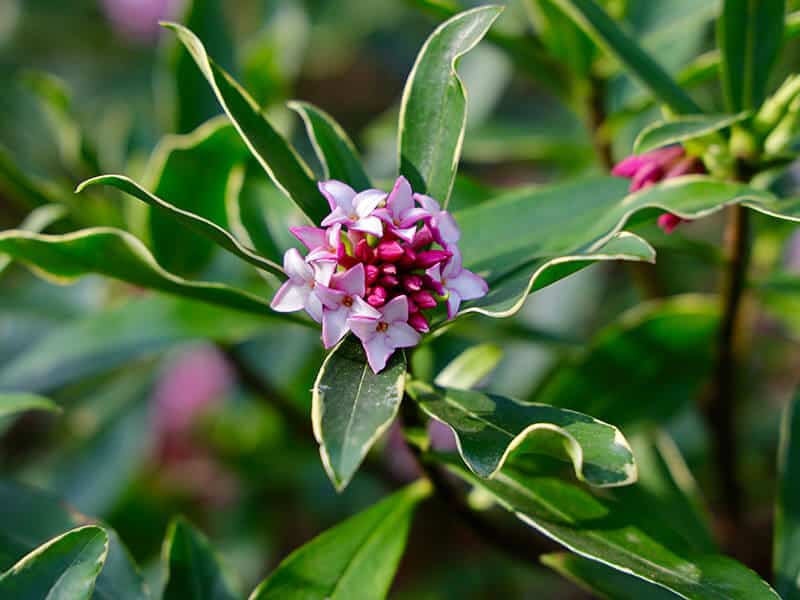
Daphne needs well-draining and slightly acidic soil. You can also add compost to boost nutrient value.
During summer, keep the soil moist, and a layer of mulch to help the soil retain moisture. Daphne grows relatively slowly, so it needs around seven years to reach maturity.
66. Day Lily
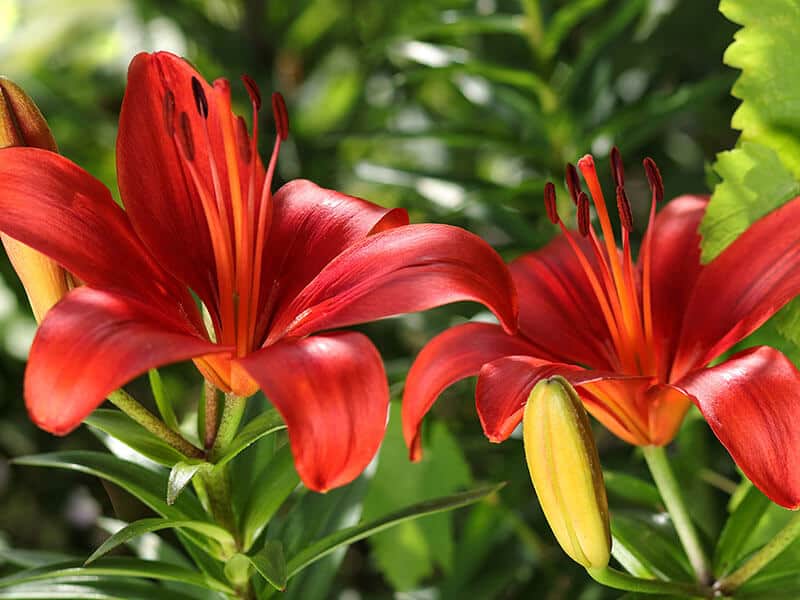
Day Lily or Hemerocallis need six or eight hours of sunlight to thrive. Keep the soil moist, but not soggy, and plant your flowers in early spring.
The lovely flowers need constant watering, and fertilization is necessary only if the soil is of poor quality. Otherwise, your Day Lilies will grow perfectly fine without it.
Deadhead spent flowers and remove seed pods, to keep the plant looking tidy and induce re-blooming.
67. Delphinium
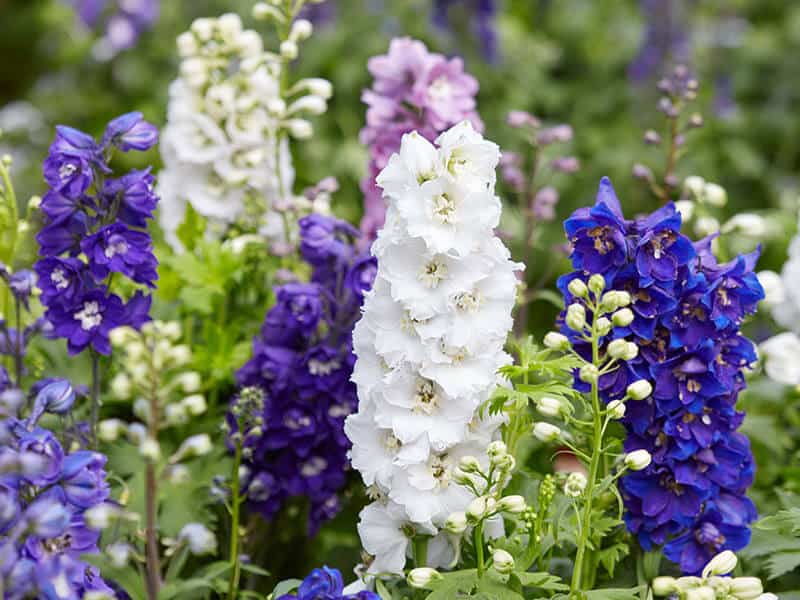
Dramatic Delphiniums with their bright flowers on three feet tall stems are a great addition to every garden! With little effort, you can grow the most wonderful Delphiniums ever.
They need moist but fast-draining soil. A full sun location is preferable, but you might get away with partial shade in warmer climates. The juvenile plants are susceptible to slugs, so keep them protected and fertilize them with high-potassium fertilizer.
68. Desert Rose
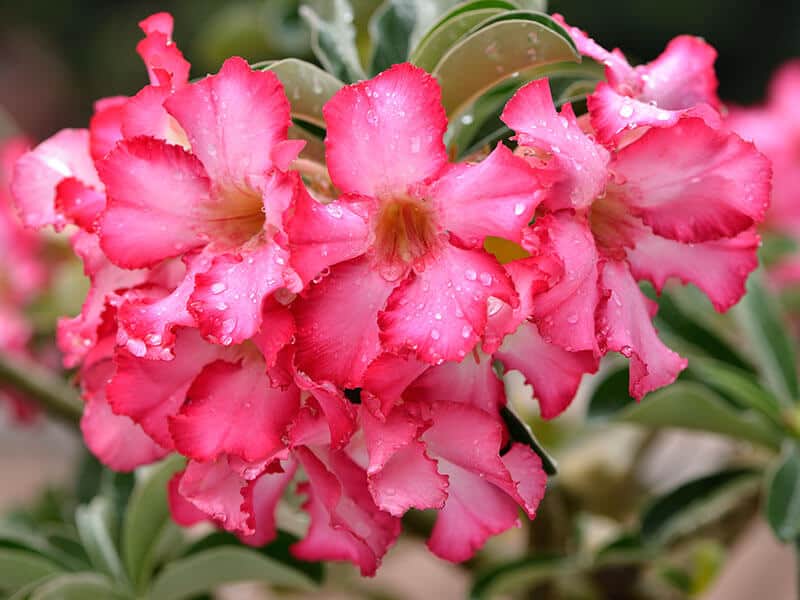
Desert Rose is a perfect plant for newbies because it doesn’t require complex care. It is a great outdoor plant for zones ten and 11, and gardeners living outside these zones can grow Desert Rose indoors.
Desert Rose cannot survive temperatures below 40 degrees Fahrenheit and too moist soil. The soil needs to be kept moderately moist in spring and summer, and dry during fall and winter. Fertilization once a month during the growing season is beneficial, as well.
69. Dianella
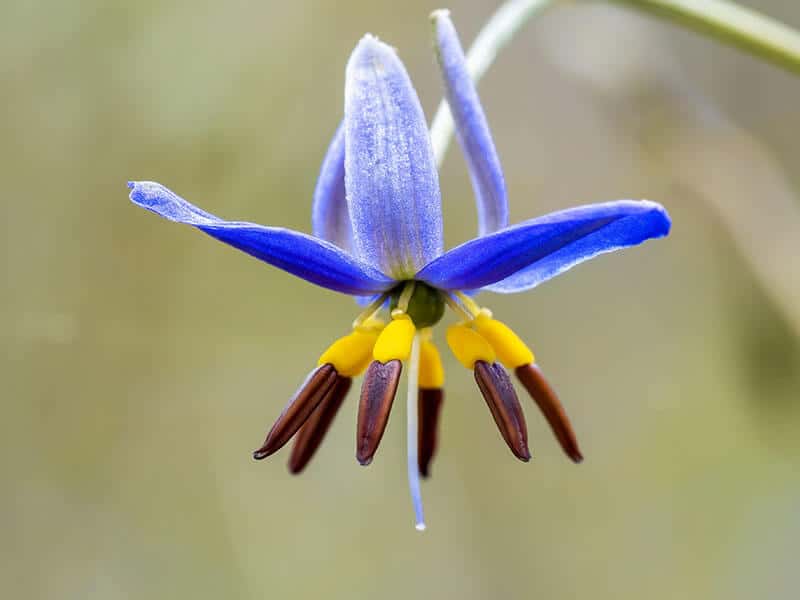
Dianella or Flax Lily is a graceful plant, which grows excellently under tall trees. It is also a deer-resistant plant that tolerates salty and windy conditions.
Dianella is loved because of the attractive flowers and beautiful berries. There are a lot of Dianella cultivars (internal link keyword “Types of Flax Lily”) to choose from, and variegated varieties are especially beautiful.
70. Dianthus
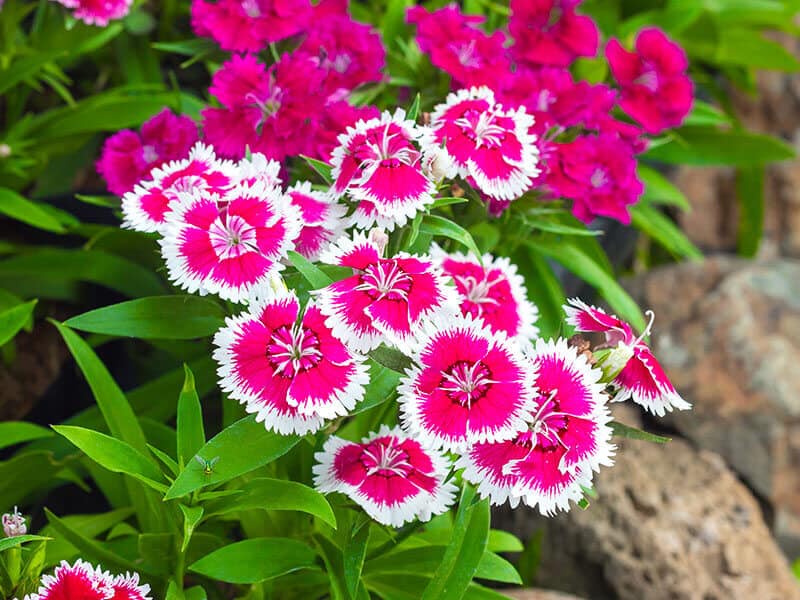
Dianthus flowers are often called Pinks because of their bright-colored blooms. They belong to the Carnation family and the flowers emit a potent aroma with a pinch of cinnamon.
Dianthus needs at least six hours of sunlight per day. They thrive in well-draining, fertile, and alkaline soil.
Most people grow them in pots or on the garden borders.
71. Diascia
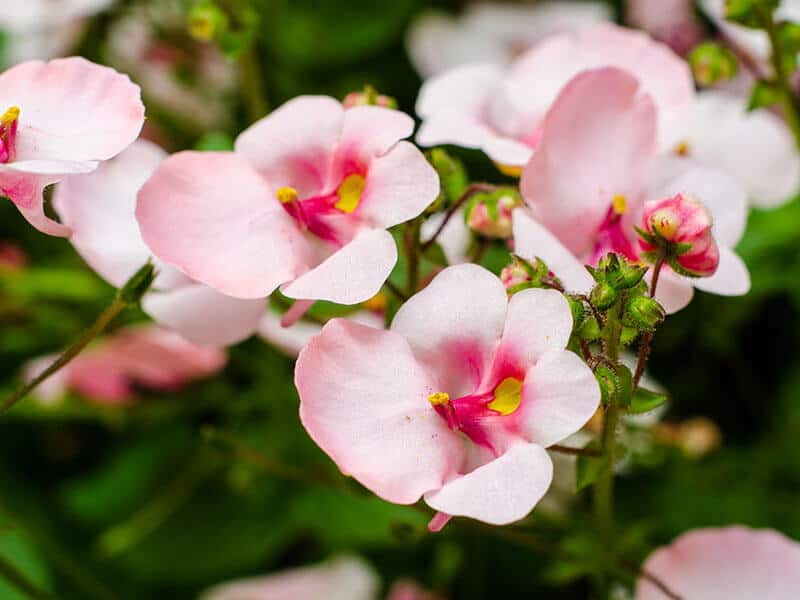
Colorful Diascia flowers are often used for potted displays and adored from July through November. They prefer full sun exposure and well-draining soil.
Diascia or Twin spur isn’t picky about soil pH. It can survive in neutral, alkaline, or acidic soil and even go through mild winters without damage. But, if the plant is exposed to too cold temperatures, it might not survive.
72. Dichondra
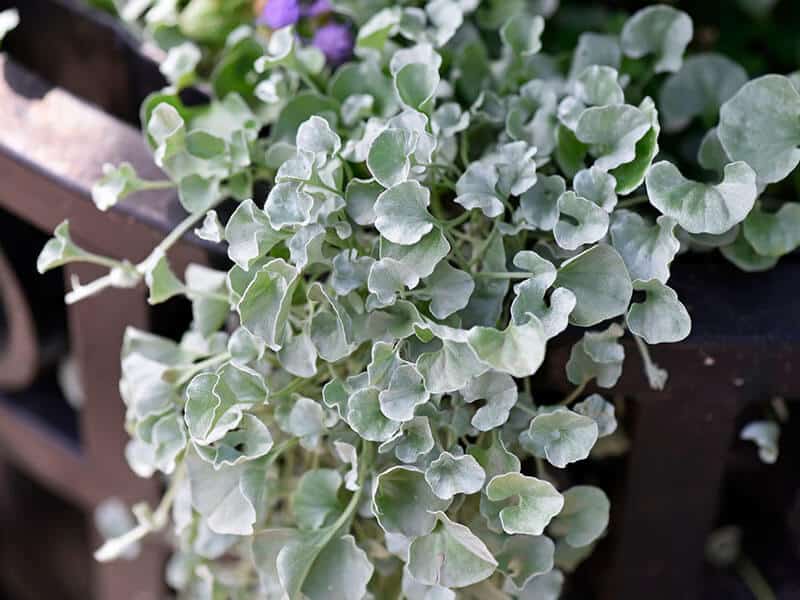
Dichondra is an easy plant to start from seeds. All you have to do is scatter seeds on the soil, lightly press the seed in the soil, and water them. The seeds should be placed shallow in the soil so the sunlight can induce germination.
Your plant needs a lot of sunlight to develop lush foliage and large flowers. It may survive in partial shade, but the flowers will be smaller.
73. Dietes
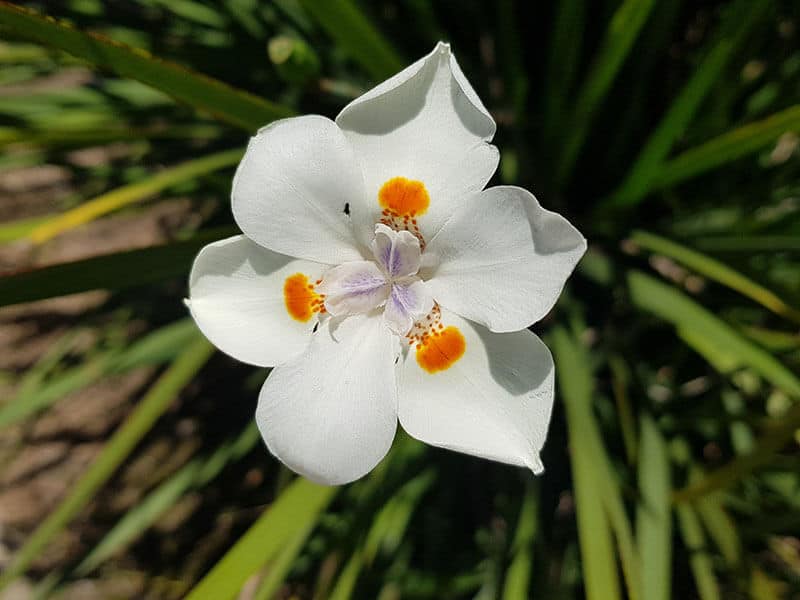
Dietes or Wild Iris is one of the best plants for boggy areas. The key to having your Dietes thriving is to keep your plant well-watered. If the watering is sufficient, Dietes can grow in sandy soil too. You can also grow Dietes indoors as an attractive houseplant.
Don’t forget to cut the plant back in late winter to induce new growth. It will also help the plant remain good-looking.
74. Dutch Iris
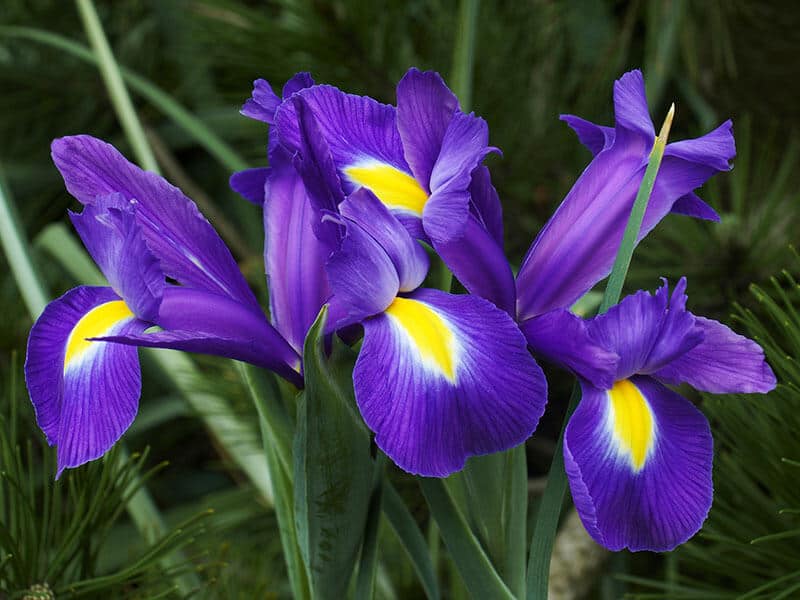
Dutch Iris is a bulbous plant, so it looks best when you plant it in a group. You will achieve the best effect if you plant approximately a dozen Dutch Iris bulbs per square foot of garden soil.
Space them about four inches apart.
Dutch Iris is dormant in the summer, so you should keep the soil dry. Don’t forget to remove spent flowers to help the plant start new growth.
You can see this video to know more:
75. Echium
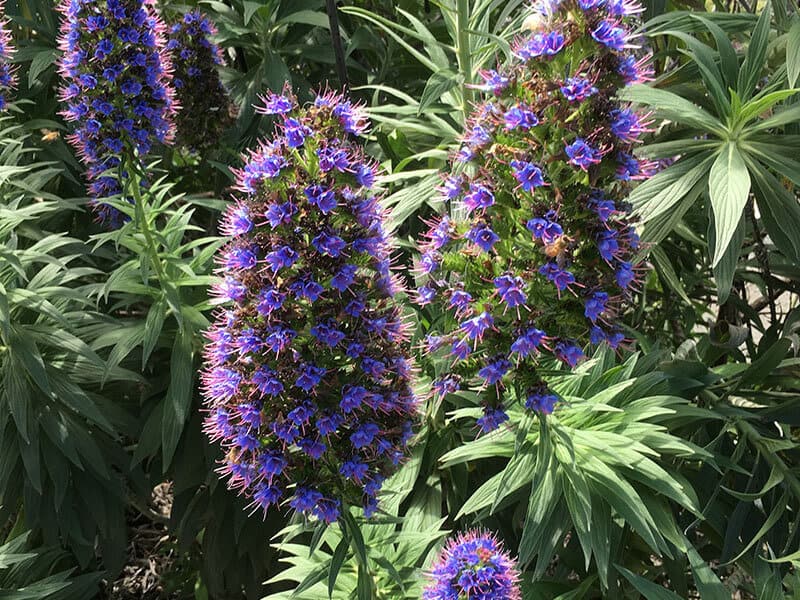
Echiums feature hairy stems and leaves as well as beautiful blooms with nectar. If you want to attract pollinators to your garden, Echiums are great plants to choose from.
Echium cultivars come in a wide range of sizes, so you can choose between tiny varieties, or plant gigantic ones as a focal point in your garden. Most of them can survive wet winters, but the soil needs to be well-draining. In addition, the plant needs as much sunlight as you can provide to it.
76. Erica
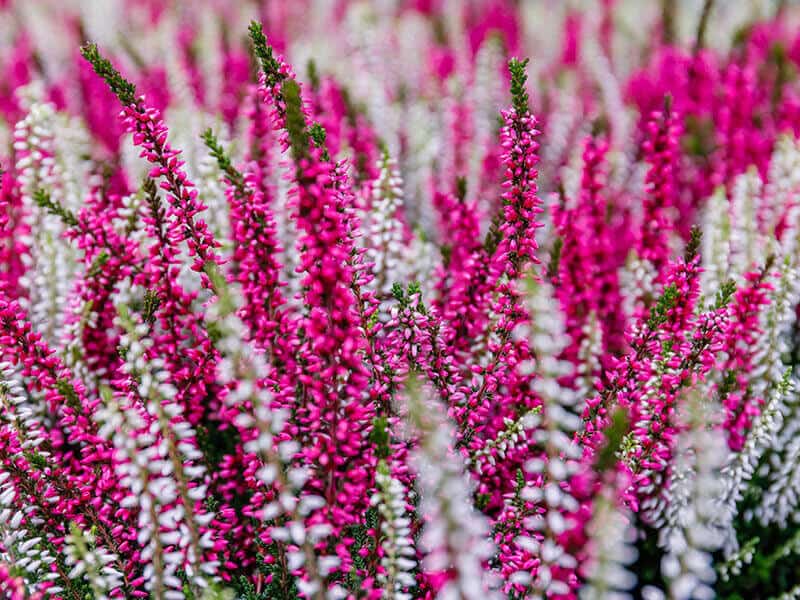
Erica Heather is a charming, short, and evergreen shrub with pink, purple, white, or red flowers. All cultivars need acidic soil to thrive, but some cultivars may grow in neutral soil.
You can grow them on garden borders, in pots, and rock gardens. Don’t forget to cut the plants back to the ground after the blooming season. It will prevent the plant from looking leggy and woody in the next season.
77. Erigeron
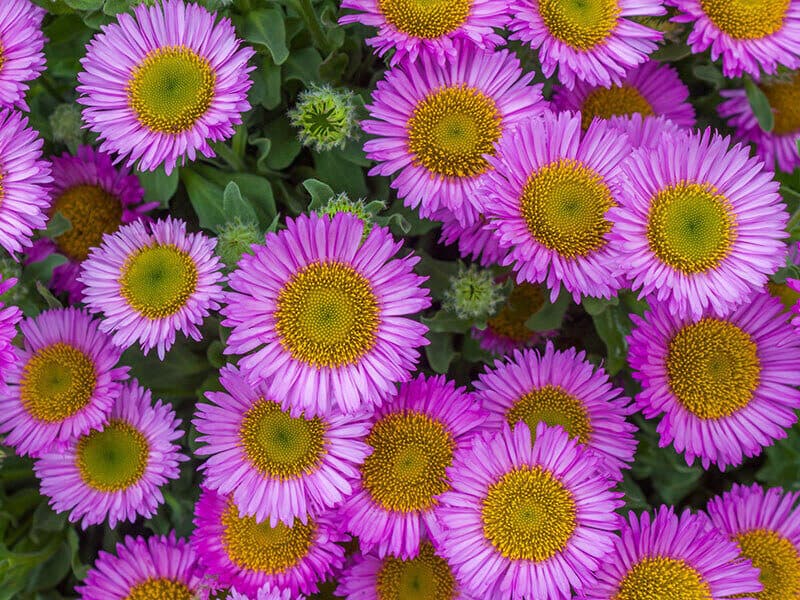
Don’t overlook Erigeron because of its small flower. The plant is a tough and beautiful perennial that doesn’t require much effort to transform your garden. You can plant Erigeron in borders, crevices, and rock gardens to ensure a long-lasting burst of flowers.
There are several Erigeron cultivars, and the most attractive are the varieties with white flowers. They turn pink as they age and remain good-looking for quite a long time.
Plant Erigeron in a sunny position and well-draining soil.
78. Eustoma
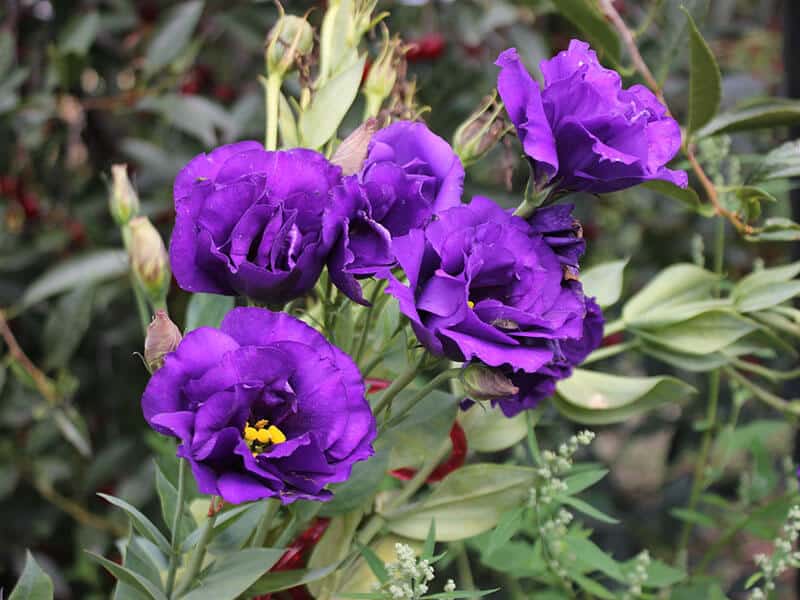
Eustoma or Lisianthus loves warmth, sunlight, and moisture. But, keep in mind that overwatering may kill the plant. Too cold or too warm temperatures are also dangerous. Watering is the most important for keeping your Eustoma flower happy.
If the soil is well-draining, keep it consistently moist to help the plant develop. You can propagate it in early spring from cuttings. Adding rooting hormone is beneficial and will speed up the establishing process!
79. Evening Primrose
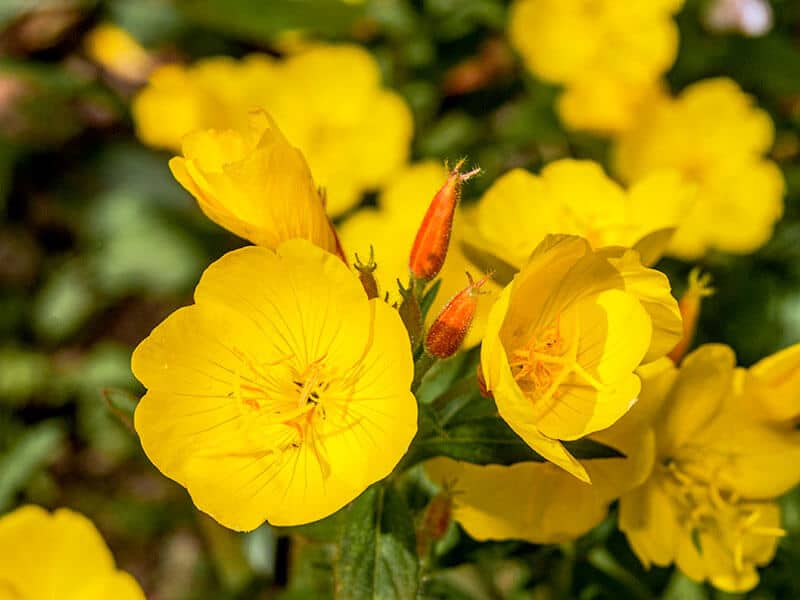
With its bright yellow blooms, Evening Primrose is one of the brilliant yellow flowers which can instantly improve your mood. In most cases, people grow Evening Primrose from seeds. You can collect seeds from live plants or buy them at great prices in the local nursery.
Evening Primrose needs a sunny location and moist soil to grow. You can boost the growth when you amend the soil with organic matter.
80. Everlasting Daisy

Everlasting Daisies are low-maintenance plant which doesn’t require presowing treatment. Sow the seeds in a sunny area and keep the soil moist for the next ten days. Then, germination should happen.
Everlasting Daisy spreads and doesn’t need fertilization. Remember to keep the soil dry during the blooming season. It will keep your flowers looking attractive for longer.
81. Euphorbia Cyathophor
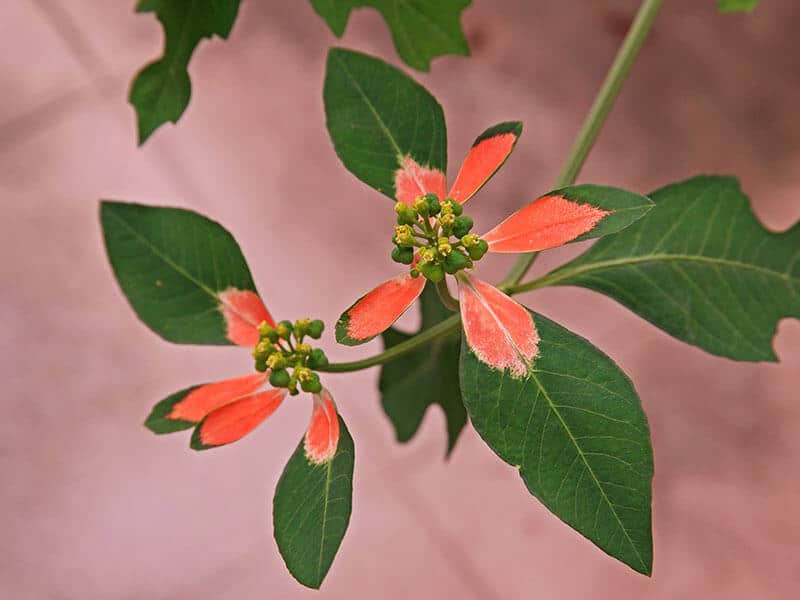
Euphorbia Cyathophor is known under several names, for example, Summer Pointsettia. It is an unusual plant, native to North America.
If you are interested in growing Euphorbia Cyathophor, ensure the plant gets a lot of space for growing. On average, it can reach three or four feet. Remember to keep the gloves on when working with Summer Poinsettia to protect the skin from milky sap.
82. Flannel Flower
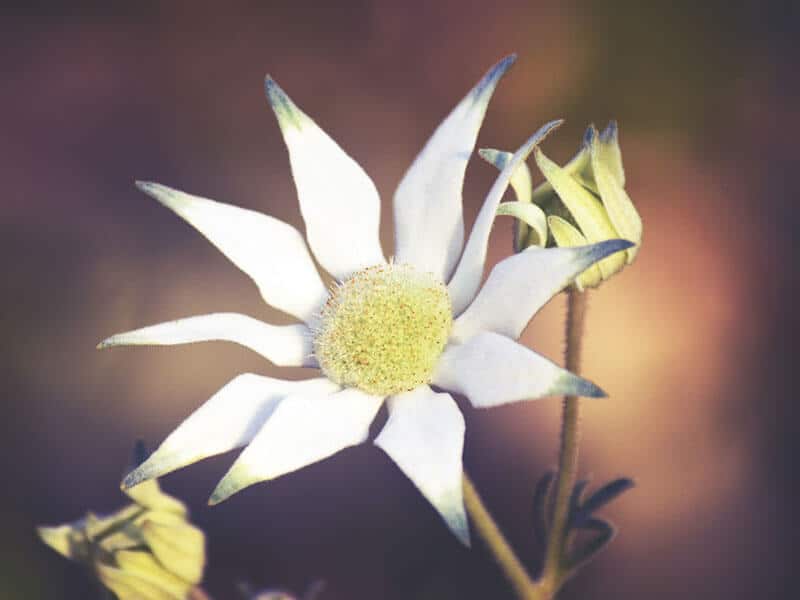
Flannel flowers are native to Australia and are highly popular because of their soft and velvety texture. The flower is attractive in gardens and bouquets with its unusual silvery foliage and white flowers.
The flannel flower is easy to grow in most conditions, except for tropical ones. The plant needs well-draining soil and prefers sandy soil in full sun.
After the blooming season, you can lightly prune your Flannel flowers to induce a bushier appearance.
83. Flax Flower
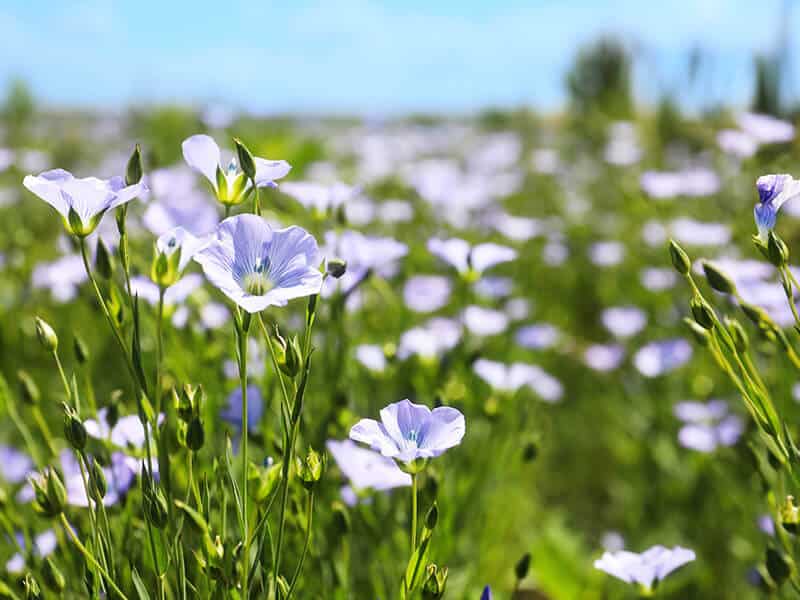
Flax flower or Linseed features pretty purple blooms and is easy to grow in the garden. The plant is versatile and has several great uses in the kitchen, for example, flaxseed oil.
Plant Flax flowers early in the spring in a sunny location. The ideal soil is sandy and well-draining. If you want to speed up the process, start the seeds indoors. Ideally, start them six weeks before the last frost.
After the seedlings appear, transplant them to larger pots or in the garden.
84. Forget Me Not
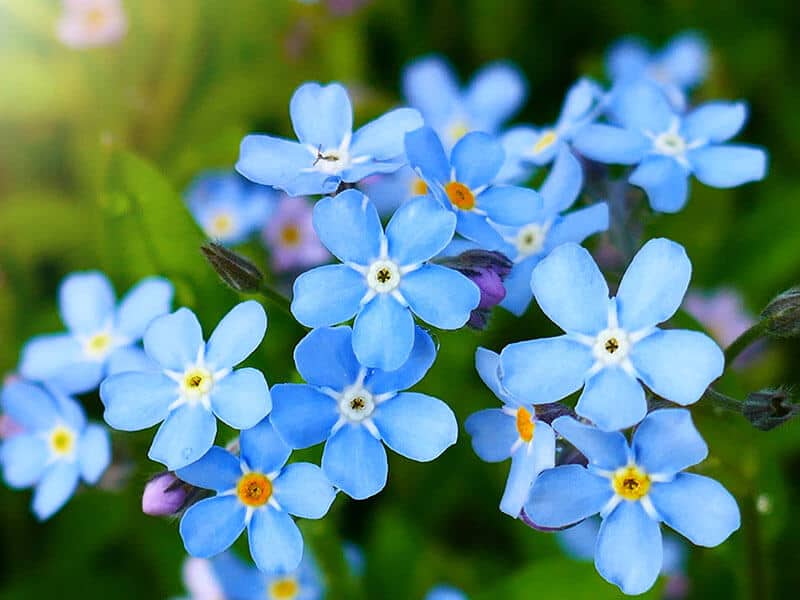
Forget me not, or Mycositis flowers are charming small blooms, native to Europe and commonly found in woodlands. They thrive in fertile soil and partial shade. You can also enrich the soil with organic matter to boost the nutrient level.
Forget me not flowers are ideal for relatively cool weather, and they will suffer in hot climates. Because these charming flowers are susceptible to pests and diseases, remove dead and damaged leaves to prevent the disease from spreading.
85. Forsythia
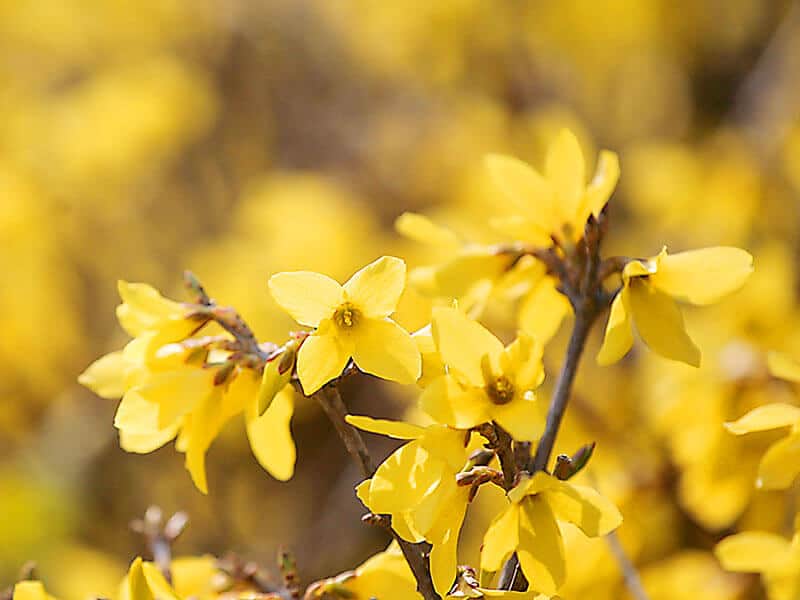
The beautiful flowering shrub Forsythia belongs to the olive family. The popular nickname of this deciduous shrub is Golden bells because of the lovely yellow blooms.
The blooming season starts early in the spring, and the plant is attractive almost year-round. In the fall, some Forsythia varieties develop purple, red, or green foliage.
Moist, fertile, fast-draining soil and direct sunlight are ideal growing conditions for Forsythia.
86. Foxglove
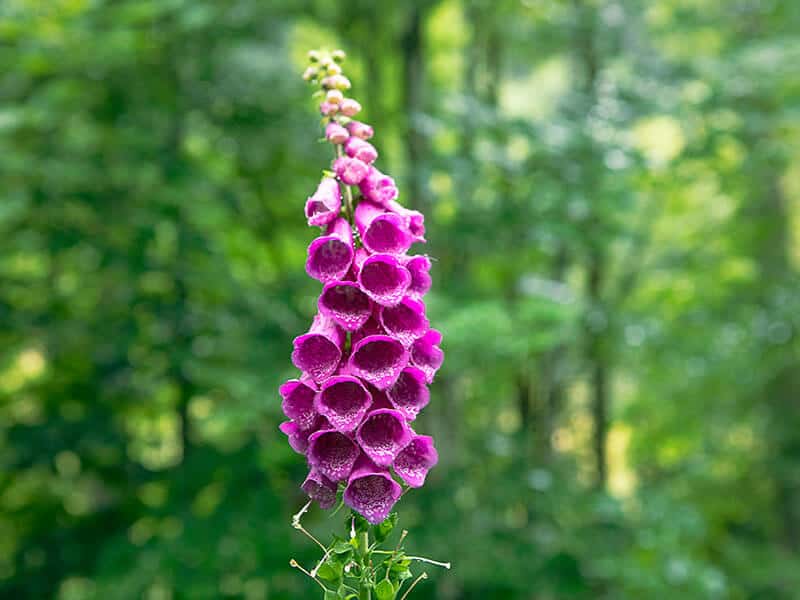
With its tubular flowers, Foxglove or Digitalis is a wonderful way to add a dramatic effect to your garden. In most nurseries, you can find biennial Foxglove varieties which flower in the second year.
Foxglove plants are perfect for flower beds, and they can grow up to five feet tall. But, you have to provide them with organically rich soil. Even though Foxglove flowers are sun-lovers, they need protection against harsh afternoon sunlight.
87. Frangipani
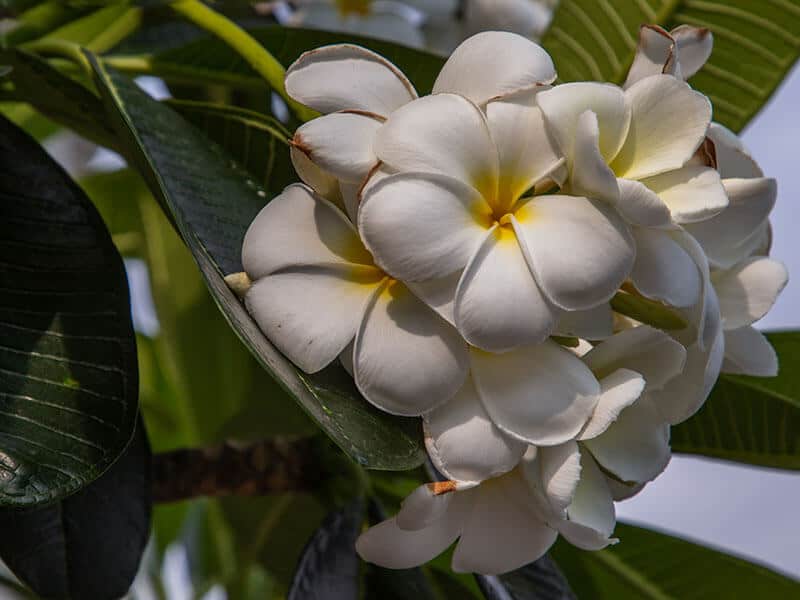
Frangipani is a large, deciduous plant with attractive deep-green foliage. It is suitable for tropical or subtropical climates and requires full sun and a sheltered location.
Frangipani’s blooming season depends on the region from December through April.
Overall, Frangipani or Plumeria is a low-maintenance plant. It needs more water in the summer. When the plant is without leaves, you should restrict watering. Fertilization is optional, but beneficial in late spring.
88. Freesia
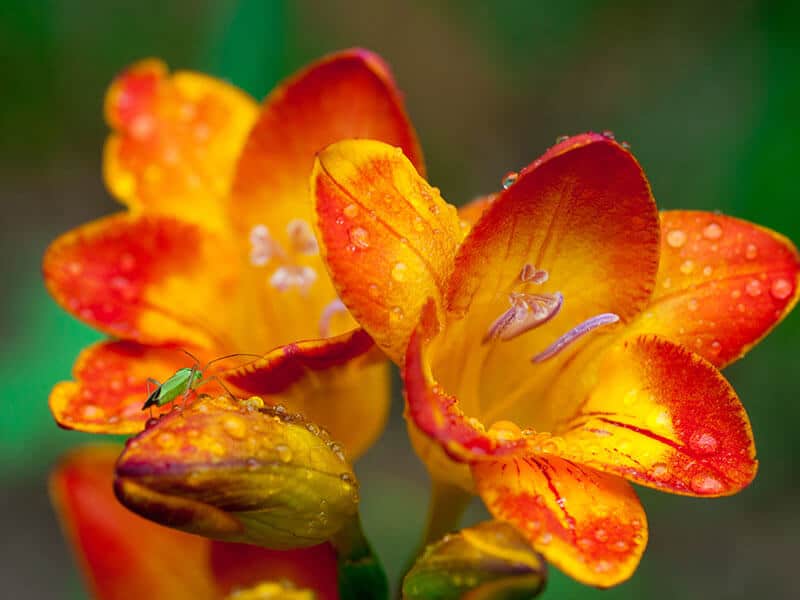
Freesias are popular cut flowers because of their exotic, colorful appearance and spicy fragrance. The flowers appear on top of long and narrow stems.
You can choose between purple, yellow, orange, mauve and white flowers. A warm, sheltered location with plenty of sunlight is ideal for Freesias. You can also use high-potassium fertilizer to help the plant produce the most beautiful flowers.
Keep the soil loose and well-draining to prevent root issues.
89. French Marigold
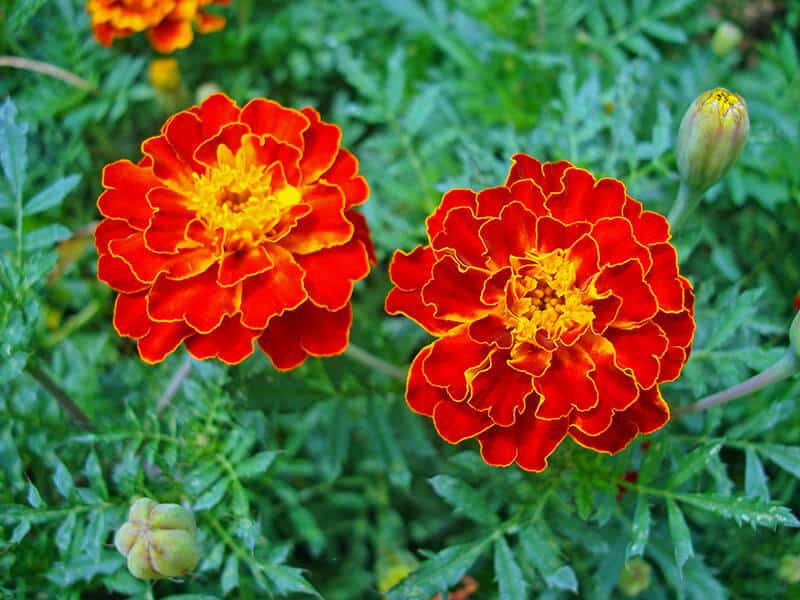
You can start growing French Marigolds from seeds from bedding plants. Both ways are good, but the latter will provide a splash of color to your landscape sooner!
Flowers are known under the name Tagetes and are popular as cut flowers. French Marigolds are easy to grow. They need several hours of sunlight per day and regular dead-heading to bloom.
90. Fuschia
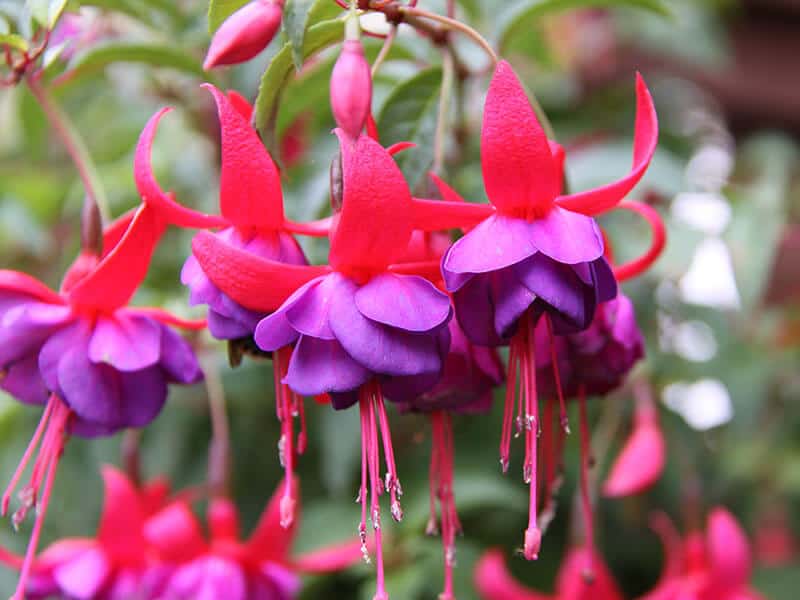
Fuschia is a striking plant with its vividly colored, bell-shaped flowers. Even though people love Fuschia for their flowers, some varieties also have attractive golden or variegated foliage, often tickled with red or purple.
Fuschia is called Lady’s Eardrop plant and grows as a shrub. When taking care of Fuschia, provide the plant with plenty of sunlight, feed them in the growing season and remove spent flowers. Pruning time is in the spring, and you can pinch the stems to boost flower production.
91. Gardenia
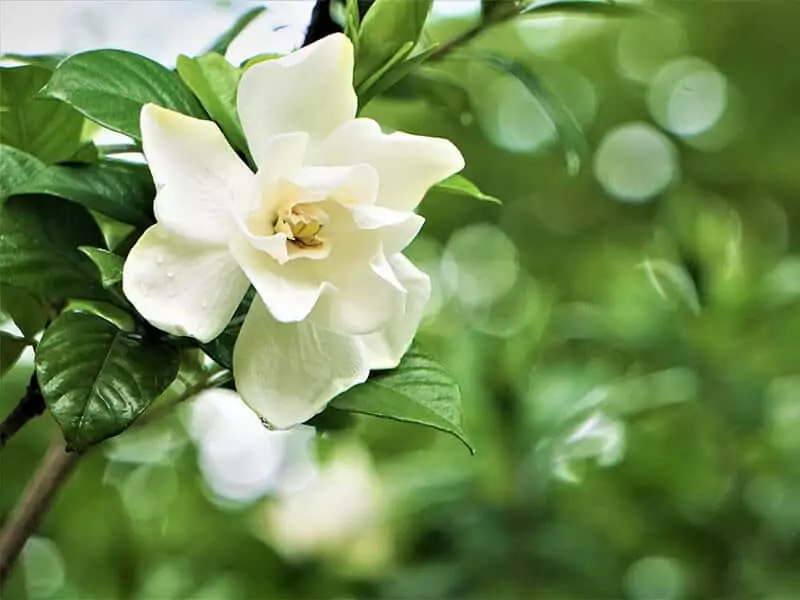
Gardenia or Jasminoides plant is easily recognizable by its large and showy blooms. Flowers are creamy-white and stand against deep green foliage as a contrast!
Gardenia is a sub-tropical plant, which can be a bit fussy. The ideal location for Gardenia depends on the climate. For example, in warm climates, Gardenia grows best in partial shade, but in cold ones, it needs a lot of sunlight to survive.
The soil needs to be moist but not soggy, which is tricky to accomplish. Adding an inch thick layer of mulch will help keep the soil moist and at consistent temperatures.
92. Gaura
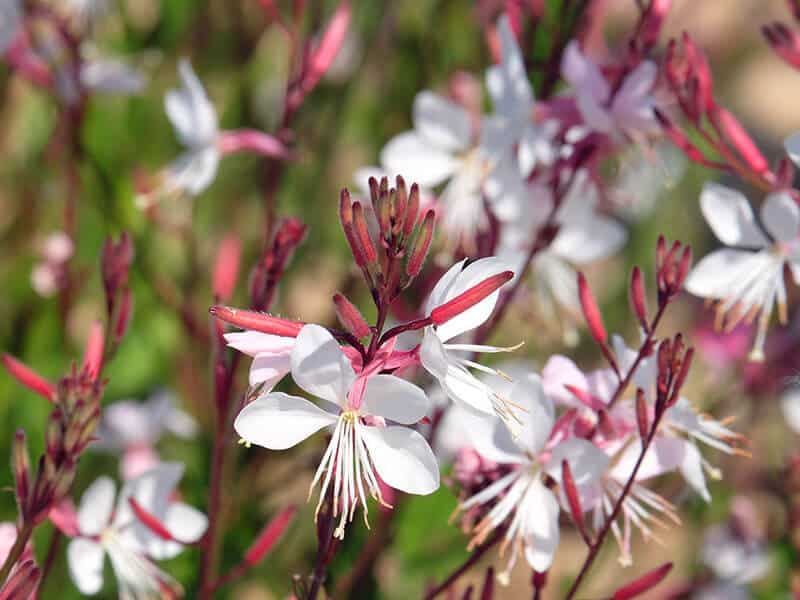
Gaura flowers or Whirling Butterflies is a mid-size shrub with delicate, bushy foliage and lovely flowers. The blooming season starts in summer and lasts until the end of fall.
Gaura is an excellent plant for informal and cottage gardens, for adding delicate colors to flower beds. You can also choose Gaura for garden borders, and it doesn’t get taller than 24 inches.
Whirling Butterflies need moist soil, and pH value isn’t particularly important. As long as the plant receives several hours of sunlight and isn’t exposed to too much water, your Gaura will thrive.
93. Gerbera
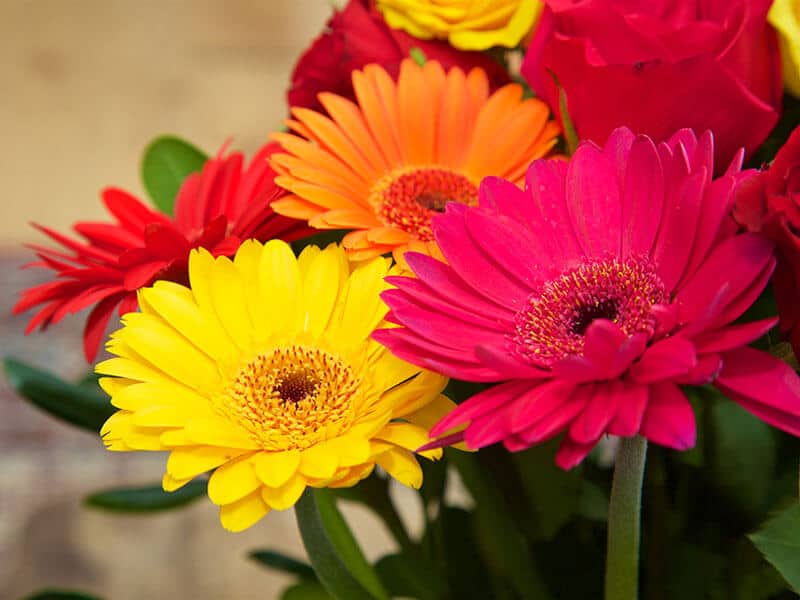
There are only a few flowers that are as popular and beautiful as Gerberas. They are available in multiple colors and are loved in gardens and flower arrangements. Surprisingly, you can also grow Gerbera to add color to your home as a slightly fuzzy houseplant.
Buy healthy Gerbera plants from plant centers and nurseries and grow them in full sun. Save the seeds for the next season!
94. Gladiolus
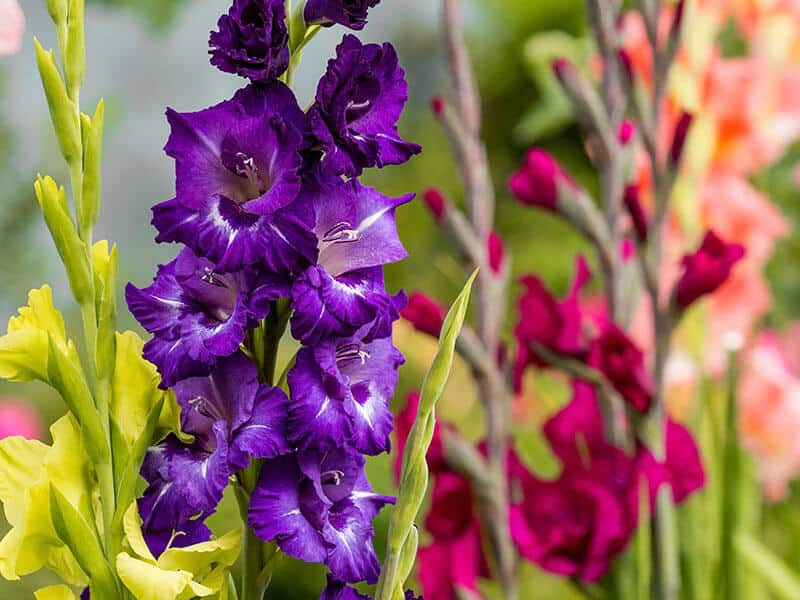
Gladiolus are popular bulb plants, people grow for attractive flower arrangements and bouquets. Plant the bulbs in the spring, and choose a spot with a lot of sunlight. If you grow Gladiolus in partial or full shade, the plant will grow, but the colors won’t be bright and beautiful.
The soil should be well-draining, slightly sandy. If you have clay soil in your garden, grow Gladiolus in raised beds, because they won’t survive.
95. Goldenrod
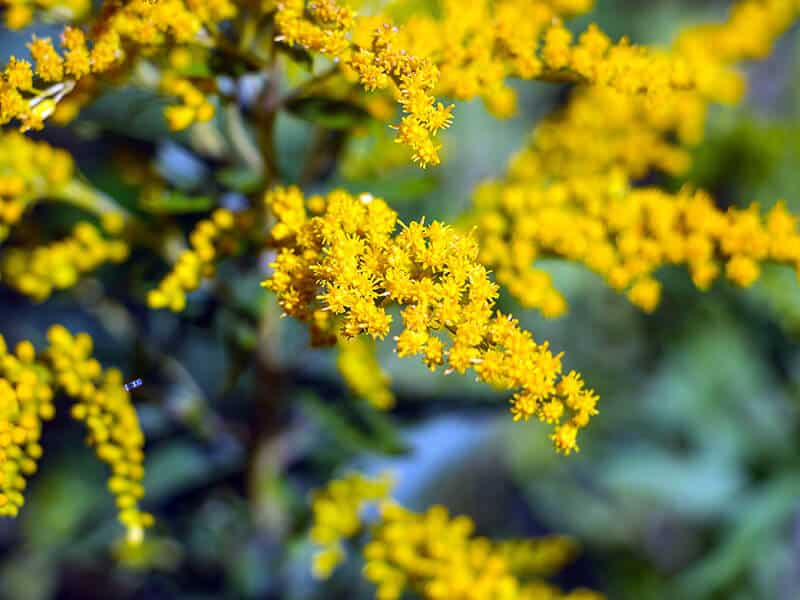
Goldenrod or Solidago grows in sunny meadows and open spaces. The plant develops sunny yellow, conical flowers, which look great on garden borders.
Every spring, you can divide the plant and deadhead to prevent self-seeding. Goldenrod is easy to plant to care for, and you don’t need to water or fertilize the plant. It will thrive on neglect.
However, if the soil isn’t well-draining, your Goldenrod may suffer from powdery mildew.
96. Grape Hyacinth
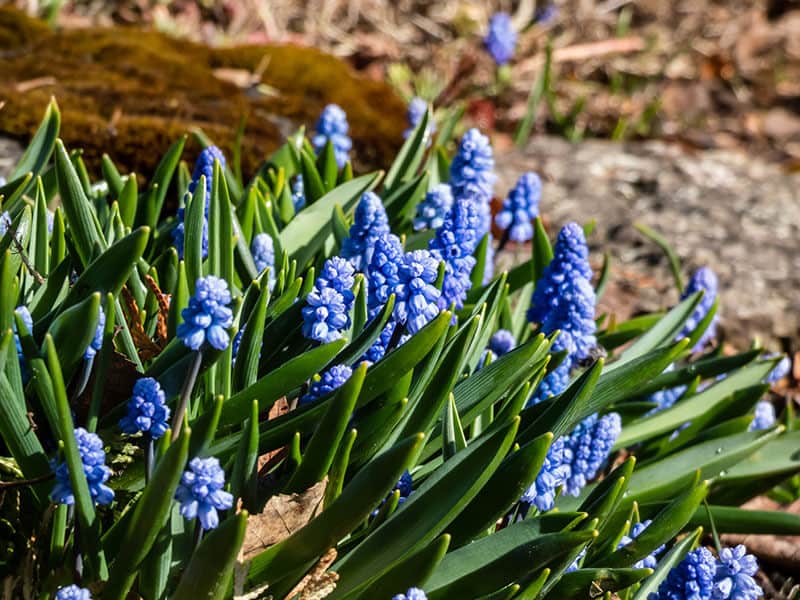
Grape Hyacinth is a small, but attractive spring bulb. It is known under the name Muscari and is common in cottage gardens and other types of informal gardens. Even though Grape Hyacinth produces small flowers, they can instantly transform any landscape.
Keep the soil moist and feed the plants regularly with bulb fertilizer to get the best results!
97. Hebe
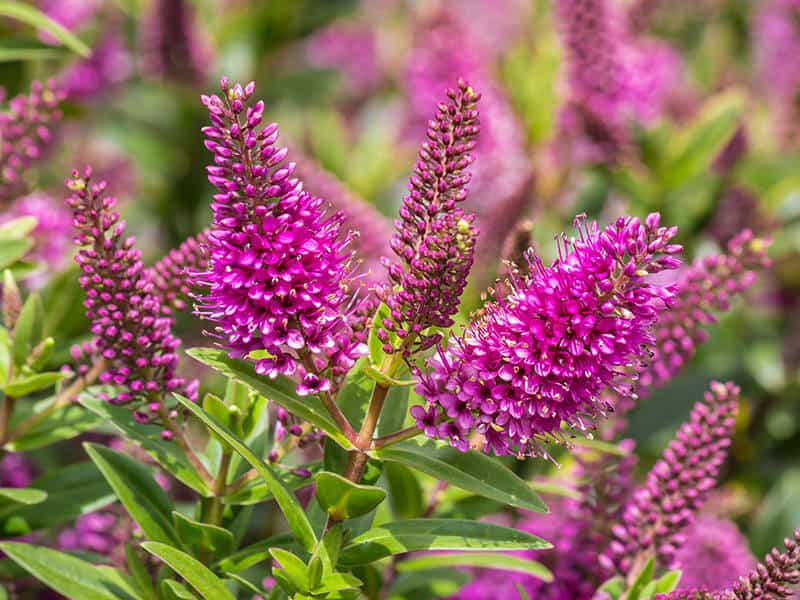
Hebe is an easy-going, evergreen shrub available in various sizes and shapes. You can also plant them as hedge borders or a low-growing ground cover.
Hebes are popular flowers because their flowers remain fresh for a long time. You can choose between pink, blue or white Hebe.
Hebes don’t need rich soil or complex care. The flowers tolerate harsh conditions, including drought and poor soil. However, they need protection from harsh winds.
98. Helenium
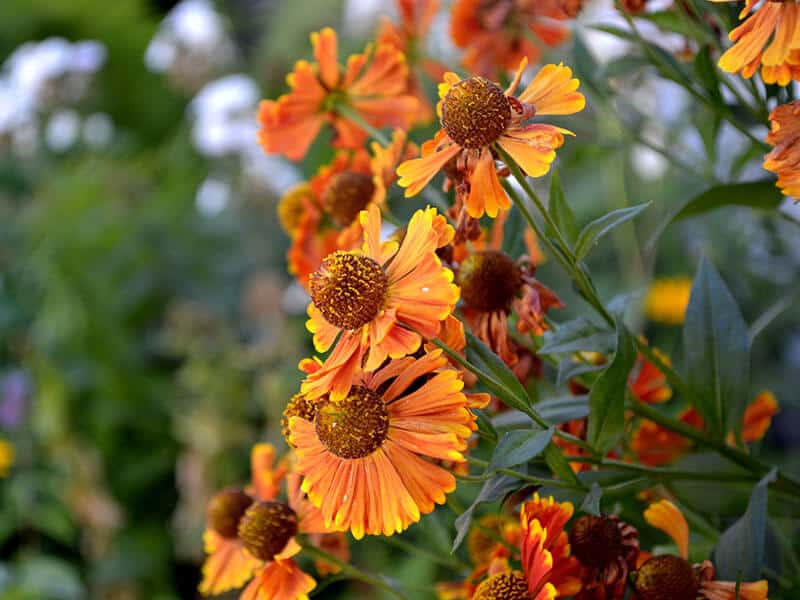
Helenium or Sneezeweed is an excellent choice if you need taller plants with attractive daisy-like blooms. Be prepared to stake tall varieties and to remove spent flowers, if you want to induce reblooming.
Overall, Helenium is a low-maintenance plant. All it requires is regular watering.
Also, every few years, you’ll need to divide Helenium clumps.
99. Heliotrope
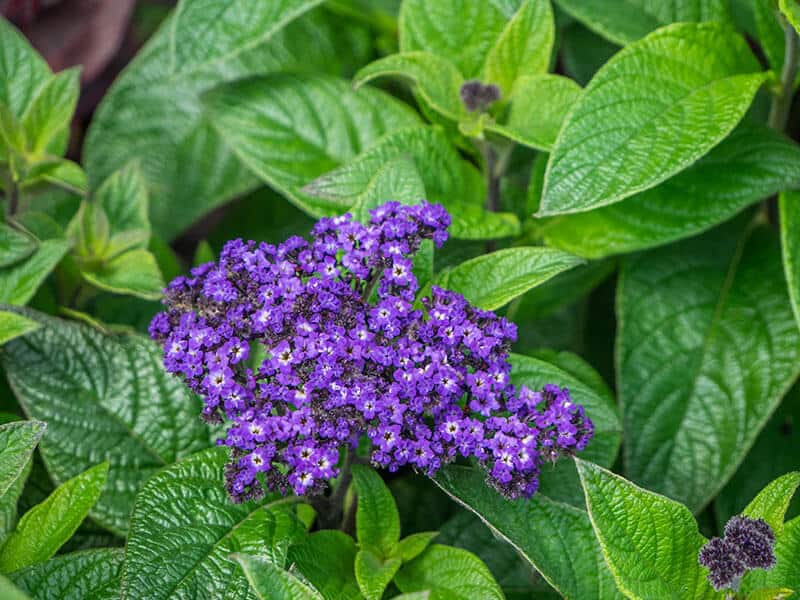
Heliotrope or the popular Cherry Pie Plant belongs to the Borage family. It is a tender, shrubby plant that produces an abundance of compact, small, and heavily fragrant blooms. Flowers are usually purple, blue, or white and look like a smaller version of Hydrangea.
You can start Heliotrope from seeds or cuttings. Ideal conditions are full sun spot, well-draining, and organically rich soil.
100. Hellebore
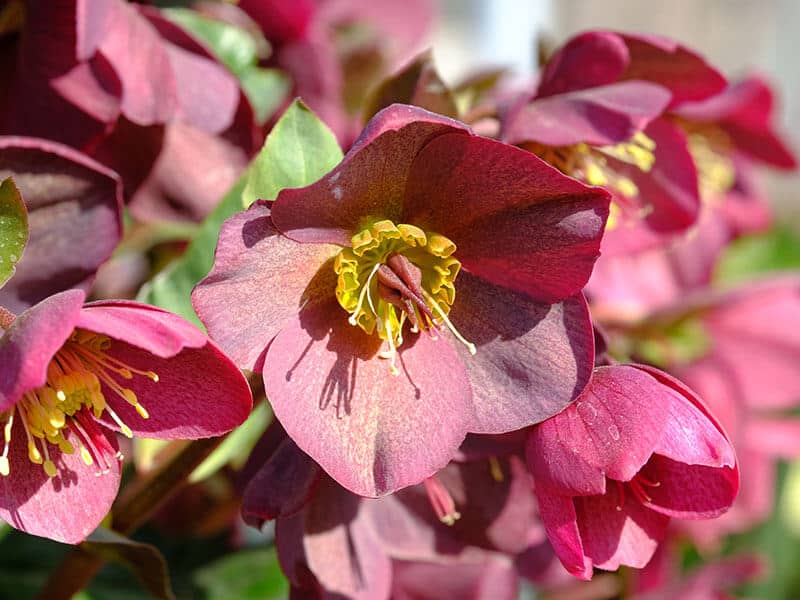
The undemanding Hellebore produces large and showy flowers which look attractive from January to May. People also refer to them as Winter roses.
Hellebores are easy to start from established plants. You can plant them any time of the year, as long as the soil isn’t frosted. Keep in mind that Hellebores don’t like moving, so pick a permanent spot for them. The location should be full sun or partial shade for the best blooms.
101. Hibiscus
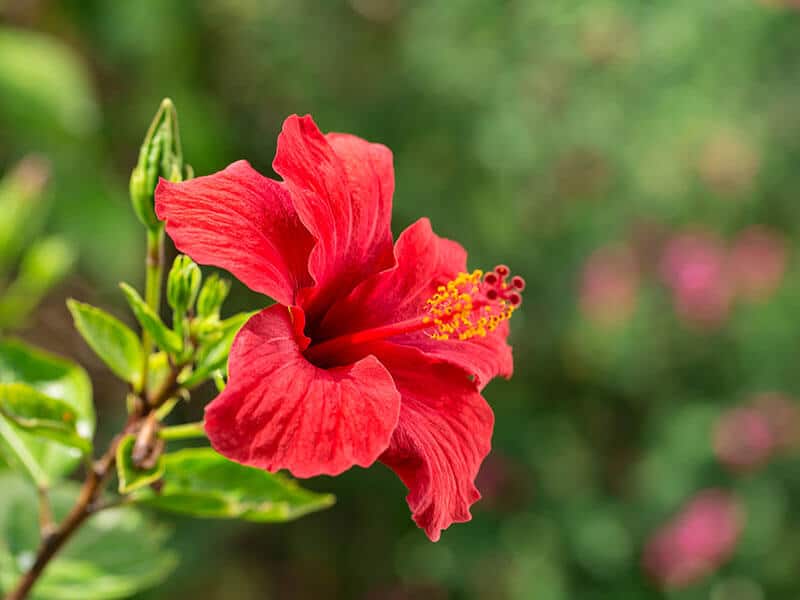
Hibiscus develops exotic flowers in the shape of trumpets. The color range is amazing because there are so many types of Hibiscus to choose from for your garden.
Hibiscus is hardy in zones from five to 11 and you can grow it indoors as a houseplant. The primary Hibiscus requirements are a lot of sunlight, soil with excellent drainage with slightly acidic pH, and consistent moisture.
102. Hollyhock
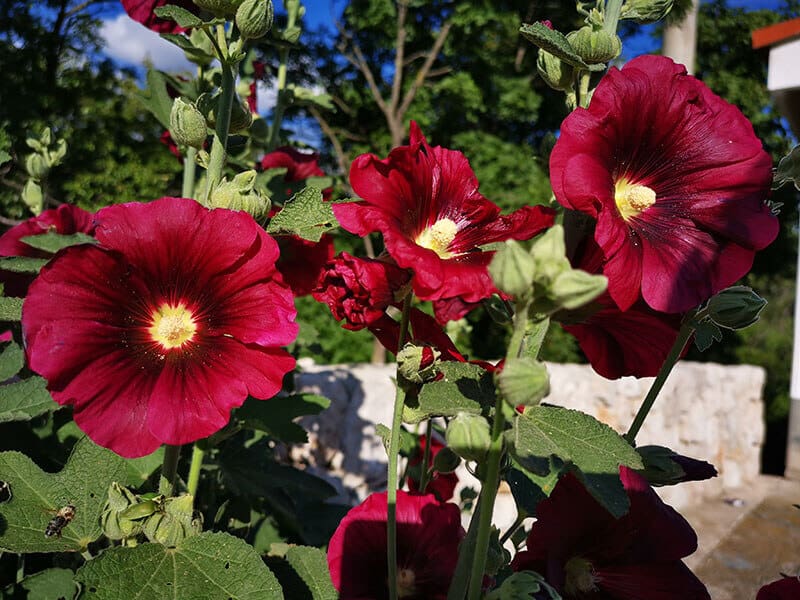
Hollyhock is a common flower in the cottage and informal gardens. It blooms in the middle of the summer with an abundance of colorful flowers. Most varieties are short-living perennials or biennials and require staking and dead-heading to look attractive.
If you want to witness blooming in the first year, start Hollyhock early in the year. Plant them as soon as the last frost passes or start seeds indoors in the winter.
103. Honesty
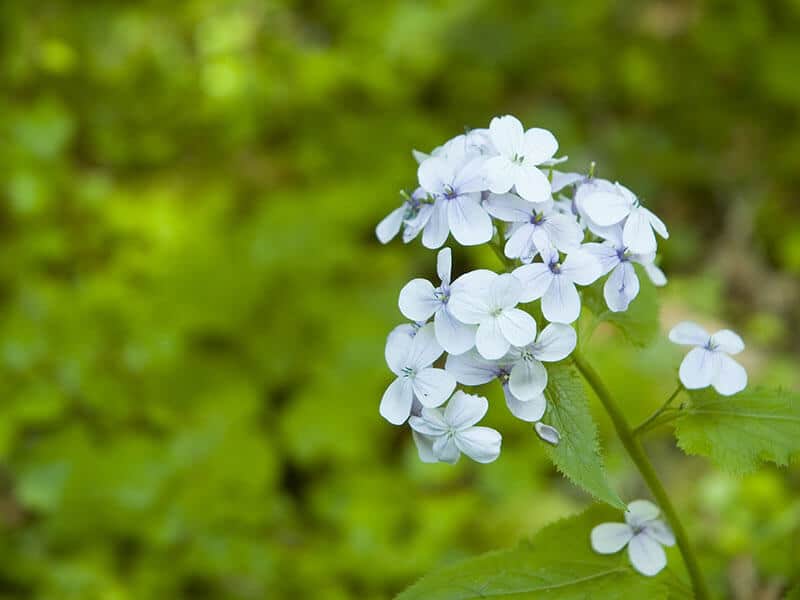
Honesty is a low-maintenance biennial that rarely blooms in the first year after planting. You might know the plant under other names, such as Lunaria, Silver, or Money plant.
The clusters of purple flowers usually appear in spring and are often used in bouquets. The plant is drought-tolerant and needs moist and rich soil to thrive.
104. Honeysuckle
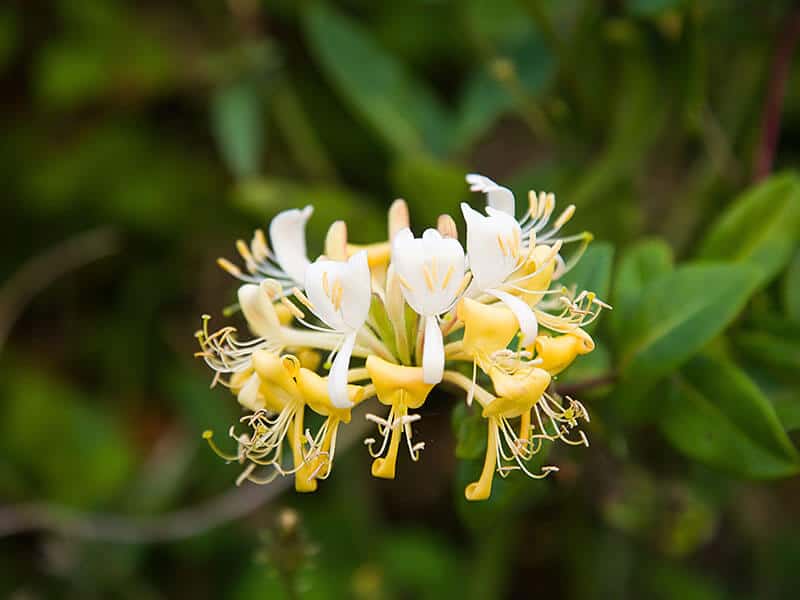
Honeysuckle or Lonicera is an all-time gardener’s favorite climbing vine, great for fences and walls. The vine grows in dappled shade or full sun and tolerates the majority of soil types.
In addition, Honeysuckle needs moist and well-draining soil. Don’t forget to provide a sturdy supporting structure to help the plant climb up. Water Honeysuckle thoroughly during dry periods, and add general-purpose fertilizer in the growing season.
105. Hosta
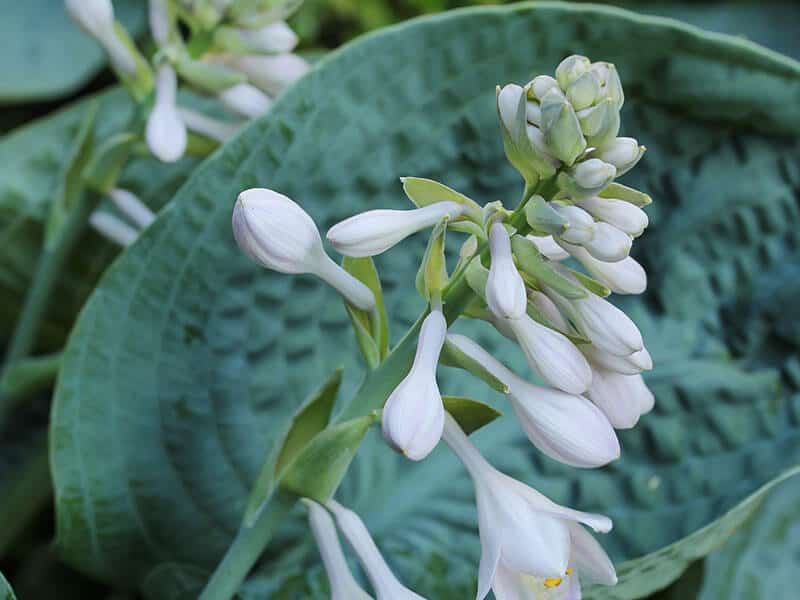
Gardeners choose Hostas or Plantain lilies for their attractive large blue leaves. Hostas need humus-rich soil with steady moisture. When it comes to lighting conditions, Hostas are adaptable. You can grow them in full sun, full shade, but they will thrive in partial shade.
You can add a slow-release fertilizer in the spring to make the foliage lusher and flowers striking.
106. Hydrangea

Hydrangea or Hortensia is a popular variety for the garden, but also for balconies, for added privacy. There are several beautiful varieties of Hydrangeas, and all feature striking flowers.
Growing Hydrangea in a garden is simpler because growing them in pots requires huge containers and a lot of space. These shrubby plants prefer partial shade and excellent drainage.
107. Iceland Poppy
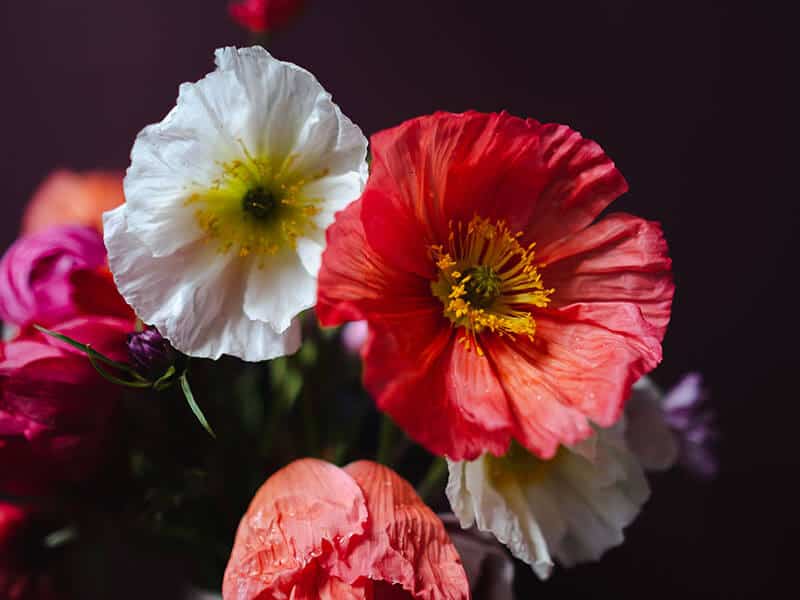
Charming Iceland poppy blooms in late spring and ensures a display of showy blooms and delicate foliage. The flowers last long, especially if you plant Iceland poppies in the right spot.
Most commonly, flowers are orange and attract common pollinators, birds, and butterflies.
Iceland poppy or Papaver nudicaule should be planted in the fall, in a permanent location. Light soil and full sun exposure are beneficial for lovely Iceland Poppies!
108. Ice Plant
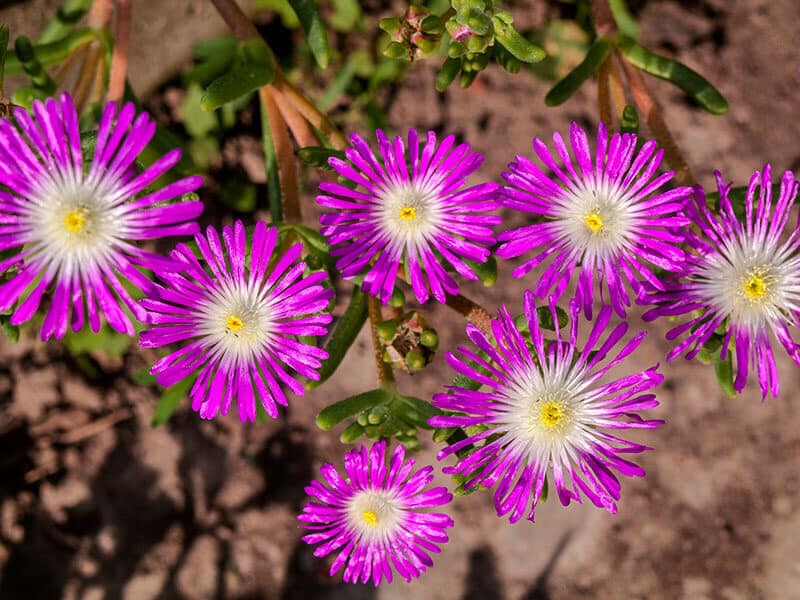
If you want colorful flowers to provide nectar for common pollinators, consider an Ice plant or Delosperma for your garden.
The plant is native to Africa and nowadays is available in numerous cultivars with an attractive color scheme, including magenta, purple, pink, yellow, red, orange, bicolor, etc.
Delosperma needs a sunny location and loose soil. It will grow best in sandy or gravelly soil.
109. Impatiens
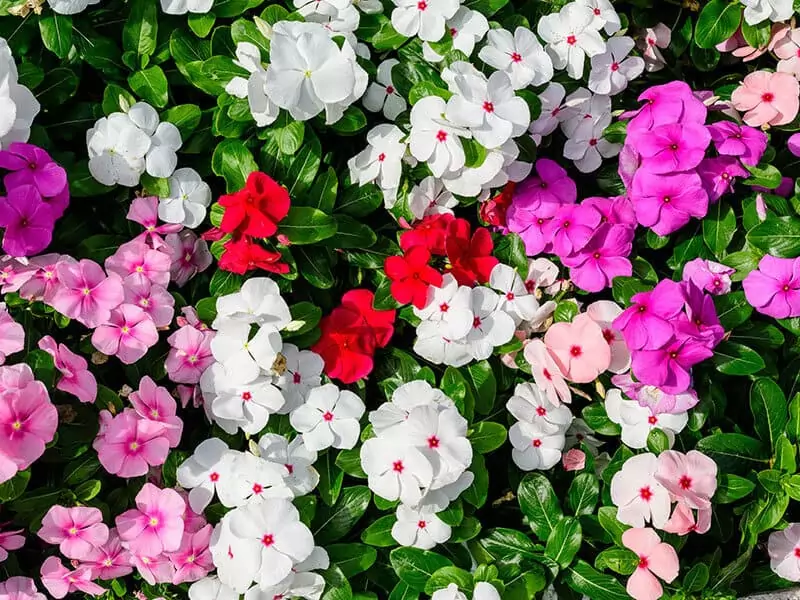
Impatiens are somewhat fuzzy plants, especially if you want to grow them from seeds. Once you sow seeds, ensure they are in a warm environment and exposed to sunlight to boost your chances for germination.
If the soil temperature is consistent, you will notice seedlings in the next seven days, and you transplant them to the pot or garden. Pick a semi-shade location and moist and airy soil for your plants.
110. Ipomoea Alba
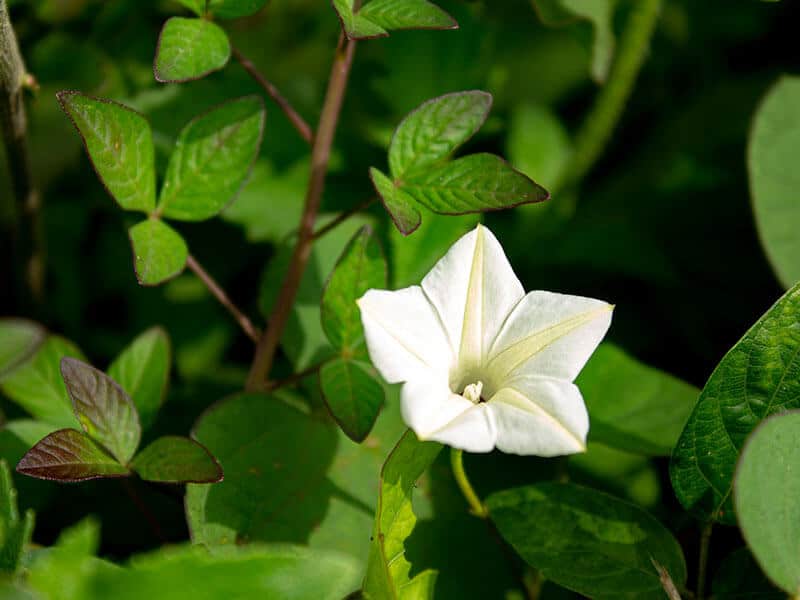
Ipomoea alba, or Moonflower Vine, is famous for its sweet-scented, pure white flowers. Interestingly, the flowers open in the evening and close with the first rays of the morning sun.
The blooming season starts in the midsummer and lasts until the end of fall. The growing conditions for Ipomoea alba are simple – sunny location, average soil with fast drainage.
The plant is suitable for beginners and rarely suffers from pests and diseases.
111. Ipomoea
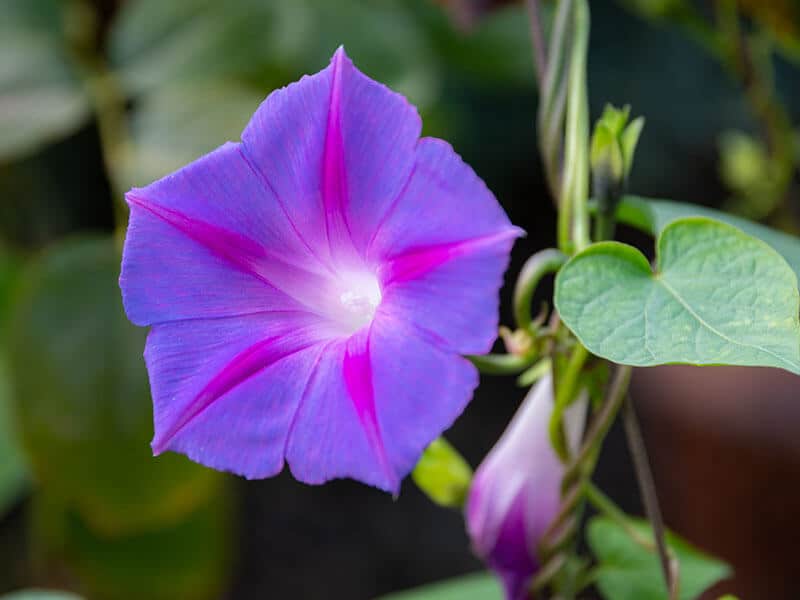
The Ipomoea plant features stunning bluish-purple flowers which appear on fast-growing stems and vines. The flowers are known under the name Morning glory.
It is a relatively easy vine to grow in a sunny, sheltered location. You can grow Ipomoea in containers or indoors, in the apartment or conservatory.
112. Iris
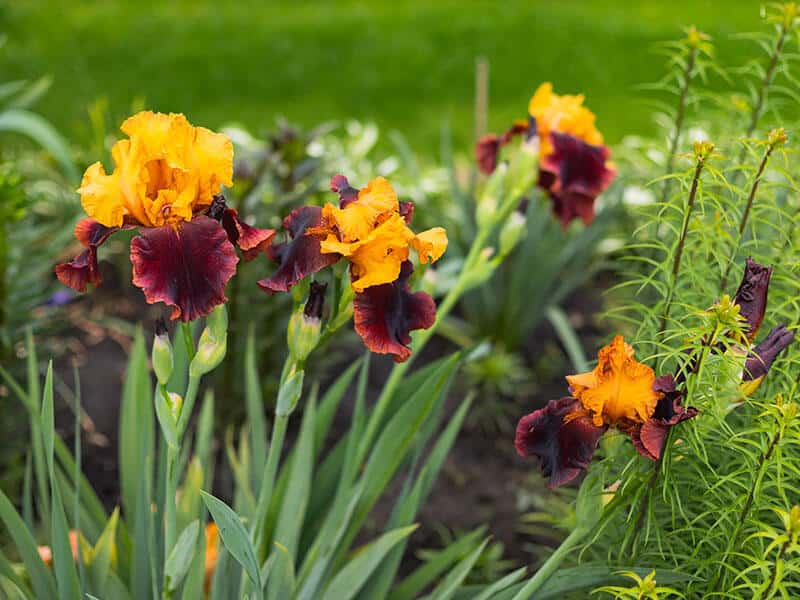
Iridaceae, shortly Iris, belongs to the same family as Gladiolus. There are so many known varieties of Iris, and Bearded Iris is one of the most common.
The plant develops large clusters of orange-red flowers with a sweet and spicy fragrance.
113. Ixia
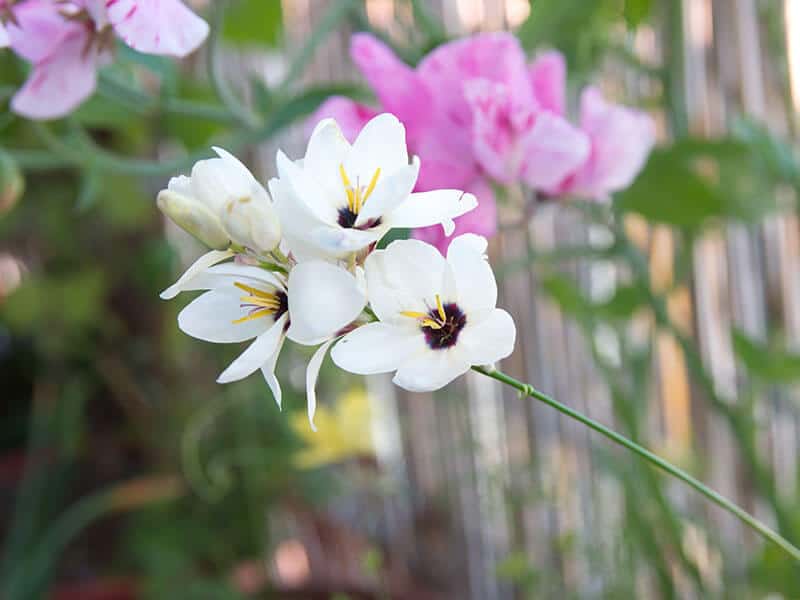
Ixia is a bulbous plant that thrives in full sun or partial shade. This exotic plant is often called African Corn Lily or Wand flower. The plant loves warm and dry climates and grows well in containers or garden borders.
The wonderful flowers disperse light and charming aroma during the blooming season. If you plant them in fall, expect the first flowers to appear in early spring.
114. Ixora
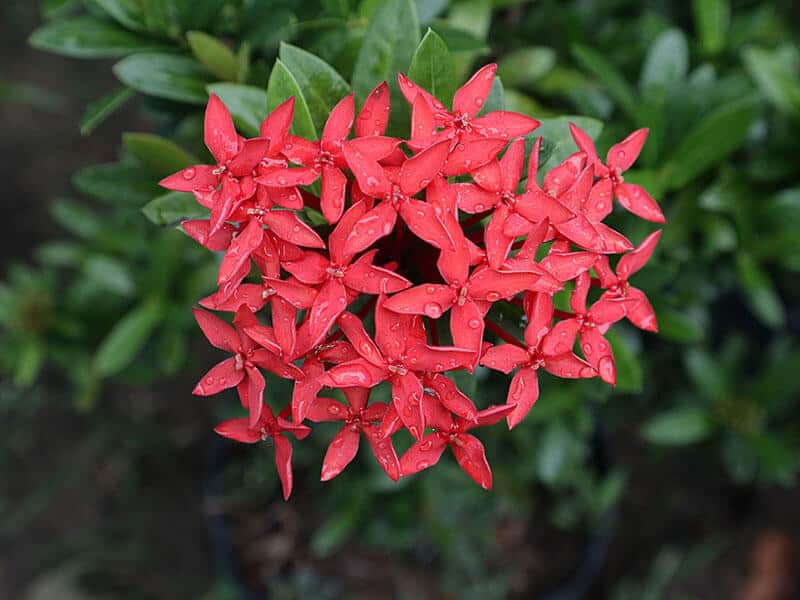
Ixora or West Indian Jasmine needs at least six hours of sunlight, but it might tolerate partial shade. In summer, Ixora produces dense clusters of bright flowers, most commonly in red, yellow, orange, pink, and white colors.
The plant works well as a hedge because of the dense branching pattern.
115. Jaborosa
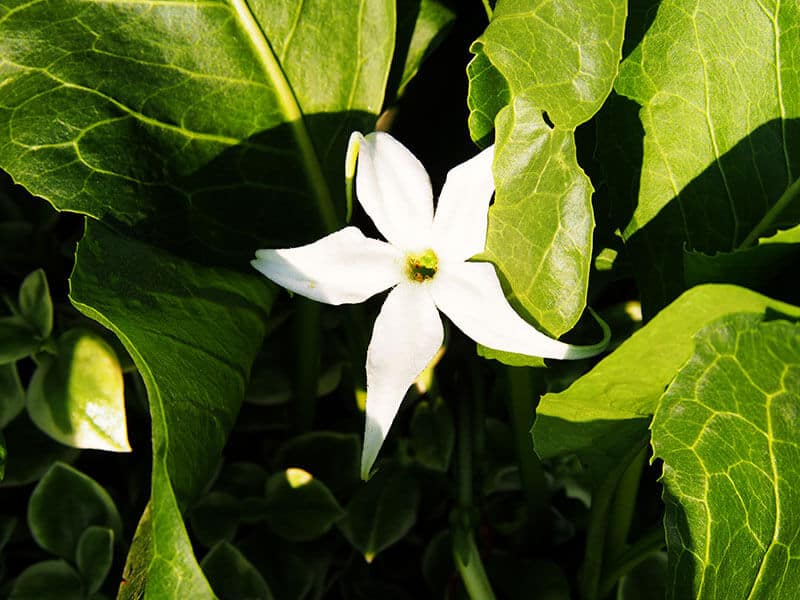
Traditionally, beautiful Jaborosa flowers are used for perfume and dye production. This exotic perennial is native to Brazil and grows well in full sun locations and warm climates.
It is sensitive to overwatering, so airy soil is a must. Jaborosa is also called Springblossom.
116. Jacob’s Ladder
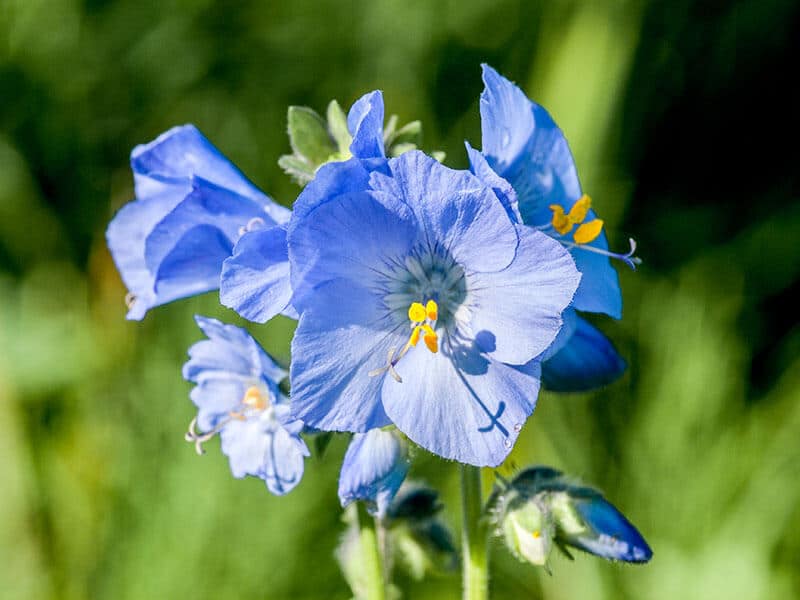
There are two varieties of Jacob’s Ladder. One is often found as a wildflower and has become an endangered species, and the other one Polemonium is suitable for growing in home gardens.
The plant is grown for interesting green foliage, which grows in the form of the pinata. But it also blooms with upright purplish flowers, which make a nice contrast with green leaves.
117. Jasmine
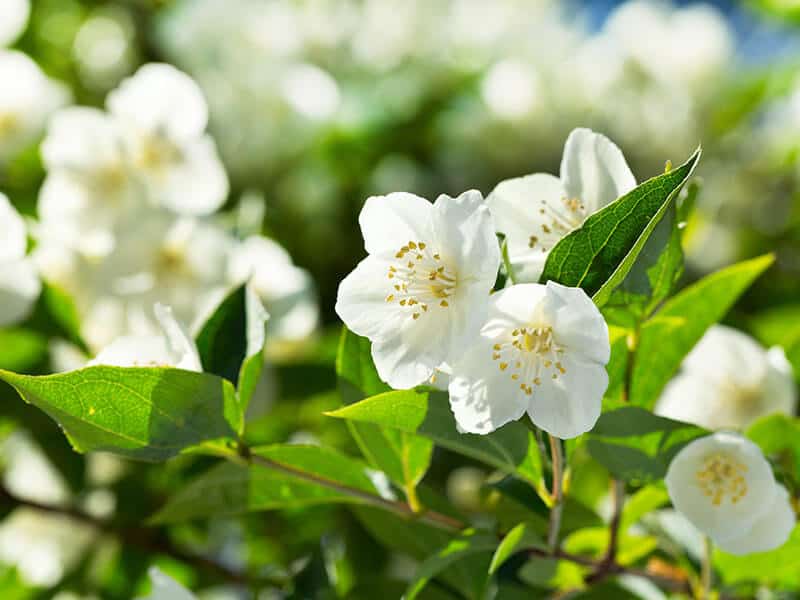
Tropical Jasmine flowers need warm temperatures and sunlight to develop their attractive and fragrant blooms. However, the exact location for your Jasmine depends on the variety. Summer bloomers prefer more sunlight, compared to winter-blooming Jasmine.
You should water the plant once a week or adjust the watering schedule based on the outside conditions.
118. Jonquil
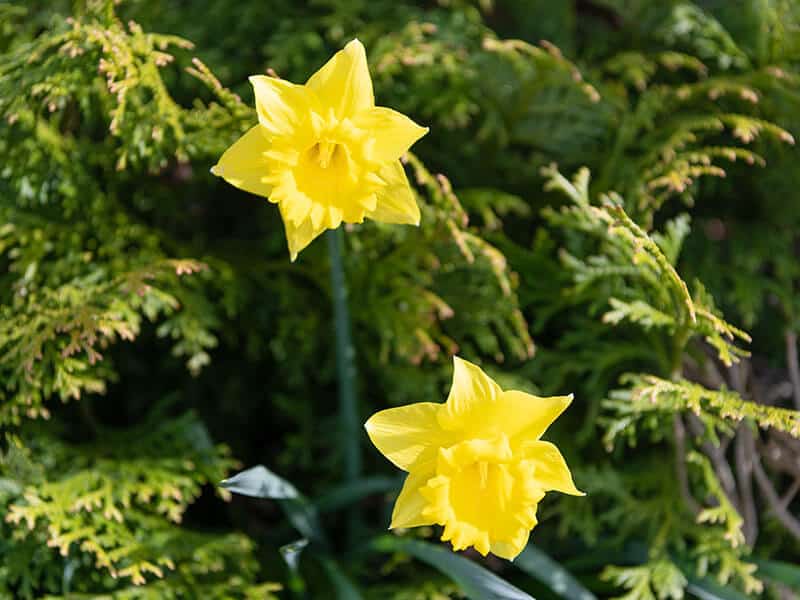
Jonquils or Narcissus are popular garden perennials that grow from underground bulbs. The flowers are popular as cut flowers and disperse beautiful aroma. Jonquils are also called Daffodils, and the most common cultivars have yellow blooms.
Jonquils aren’t picky about the soil type. Drainage is recommended, and optimal sun exposure includes several hours of sunlight. If you have poor soil in your garden, enrich it with compost for better results.
119. Kaffir Lily
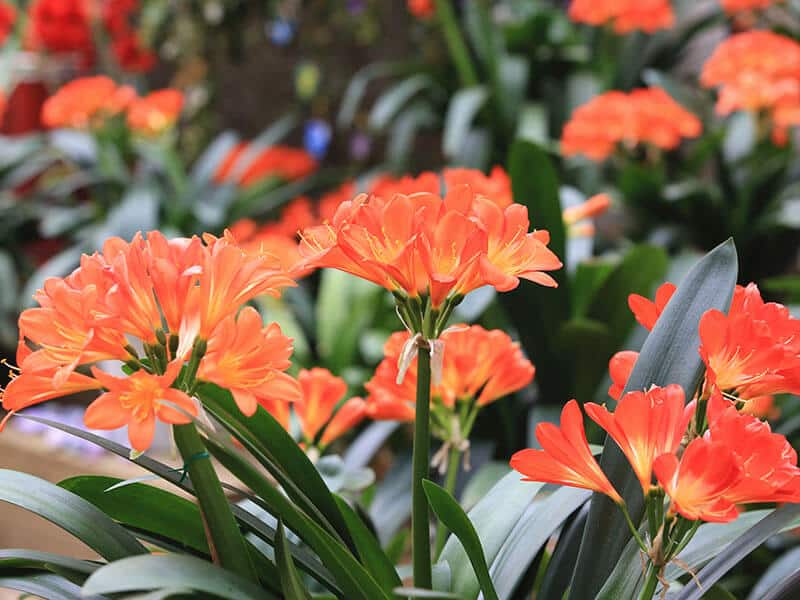
Kaffir Lily is an exotic plant, native to South Africa, best known for its stunning coral-orange flowers. It has been popular around the world as a houseplant. But, if you live in a warm climate, you can grow it in your garden and enjoy the plant’s striking appearance.
Clivia miniata is the scientific name of the plant. Provide the plant with a semi-shaded spot, excellent drainage, and consistent moisture during late winter and early spring.
120. Kalmia
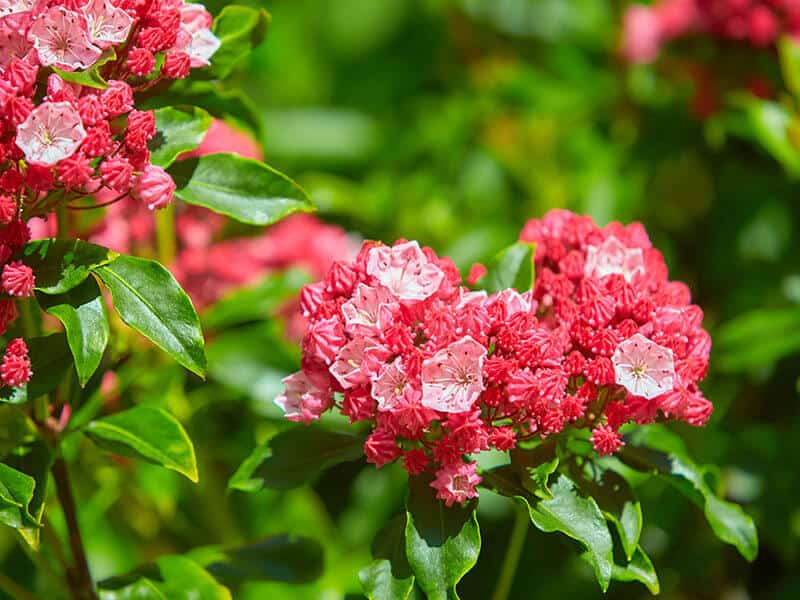
Kalmia isn’t a difficult plant to grow, but it needs high-quality soil, rich in nutrients to grow. The soil needs to be slightly acidic, and the shrub is drought-tolerant.
The abundance of pretty blossoms appears in May and lasts until the end of June or July. Kalmia has a slow growth rate, but it is cold-hardy, and it provides year-round interest in your garden.
121. Kangaroo Paw

The Kangaroo paw is an Australian native. The flowers look like Amaryllis and have a velvety appearance.
Mature plants can grow between two and ten feet in sandy and moist soil. Six hours of sunlight per day are a minimum to grow.
122. Kniphofia
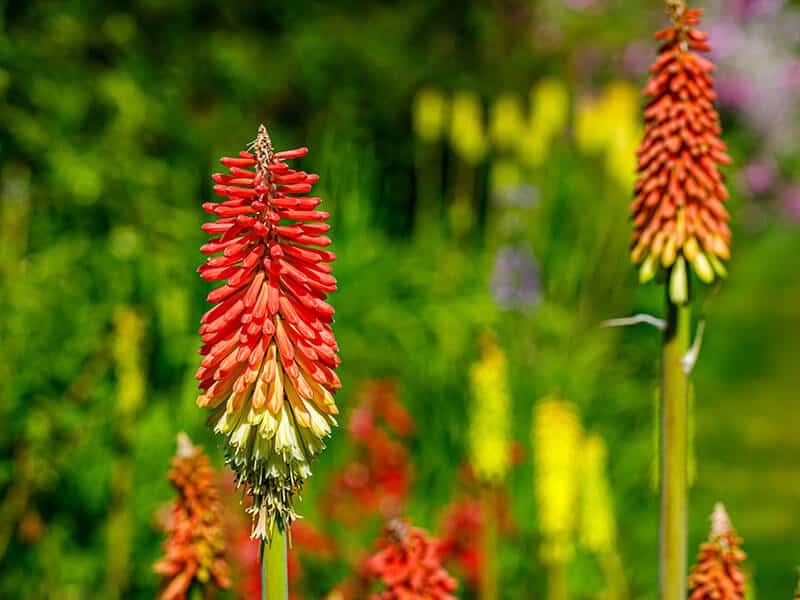
Kniphofia is native to Africa summer-rainfall regions. Therefore, to ensure the normal plant health, keep it well-watered in the summer and dry during the winter.
Light, well-draining soil, and partial sunlight are the best conditions for Kniphofia. The common name for the plant is the Red hot poker plant.
123. Kolkwitzia
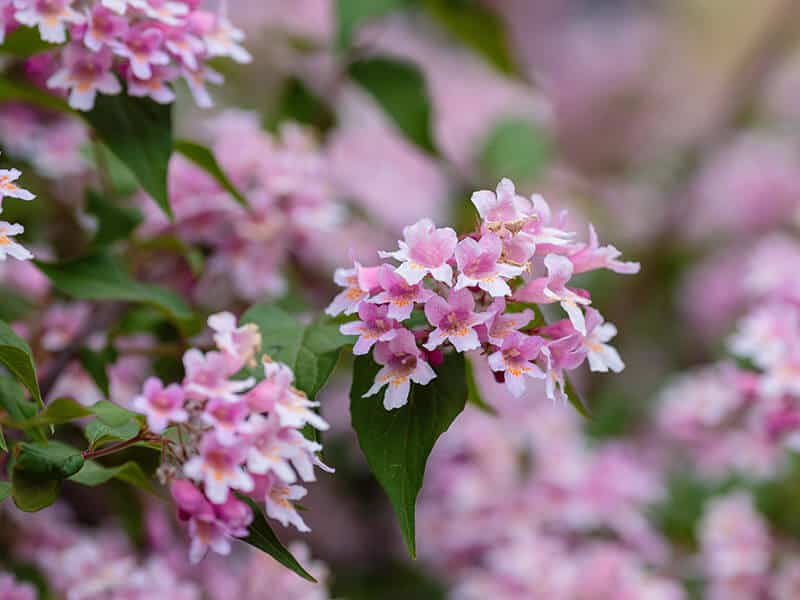
Kolkwitzia, or Beauty bush, belongs to the family of Caprifoliaceae. It grows best in sandy soil with a slightly acidic pH balance. The best location for Kolkwitzia is in full sun, but the plant can tolerate afternoon shade.
You can grow Kolkwitzia in garden borders and flower beds, mixed with low-maintenance flowers.
It is better suited for cottage and informal garden types.
124. Lantana
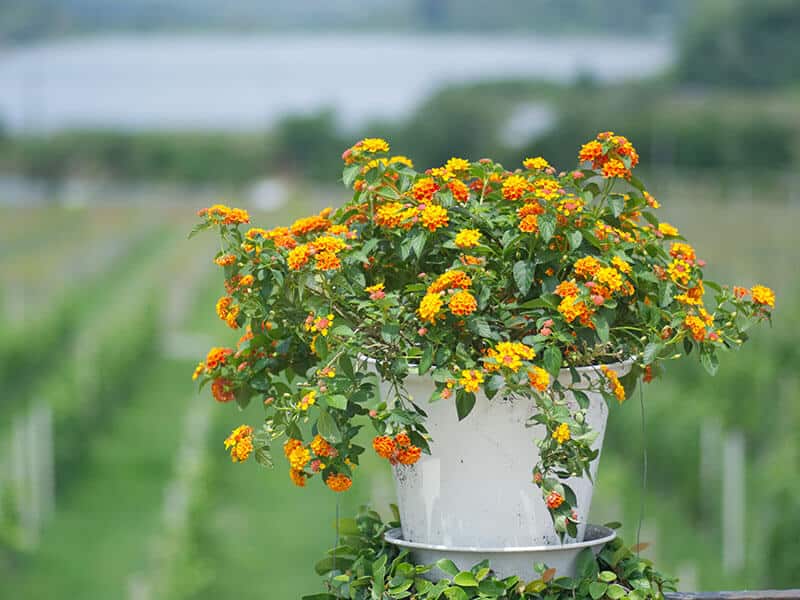
If you want to add long-lasting colorful interest to your garden, pick bright blooms of Lantana flowers. The plant is also called Shrub Verbena and has been loved because of the extended blooming time.
Lantana varieties offer a beautiful color scheme of bright and vivid colors, which attract hummingbirds and butterflies. Young plants need frequent watering, but mature Lantana flowers are drought-tolerant and low-maintenance.
125. Lavatera
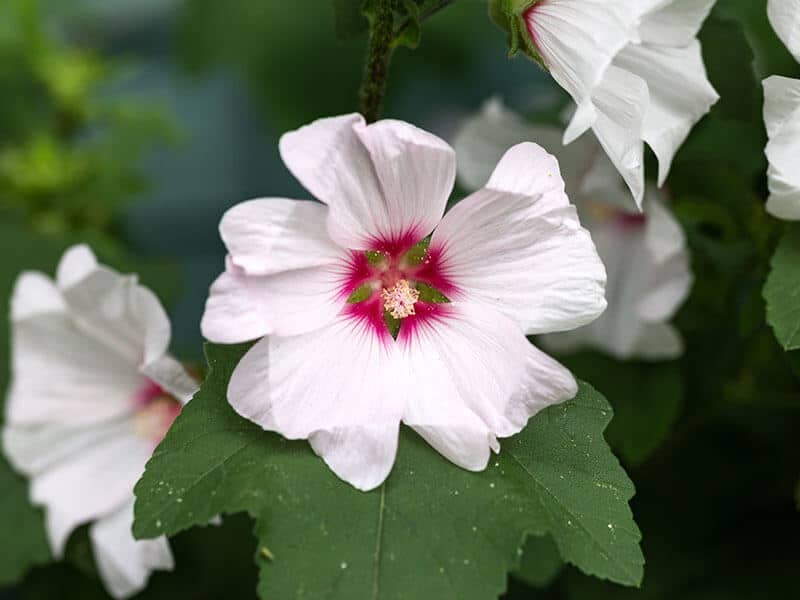
The Lavatera or Mallow plant develops large and gentle flowers in pastel shades of pink. But, you can also find varieties with white flowers.
Blooms attract pollinators to your garden, and the plants are great for filling in gaps in your garden or stunning pot displays. The blooming season is three months long, and the plant needs sunlight, well-draining soil, and protection from harsh winds to thrive.
126. Lavender
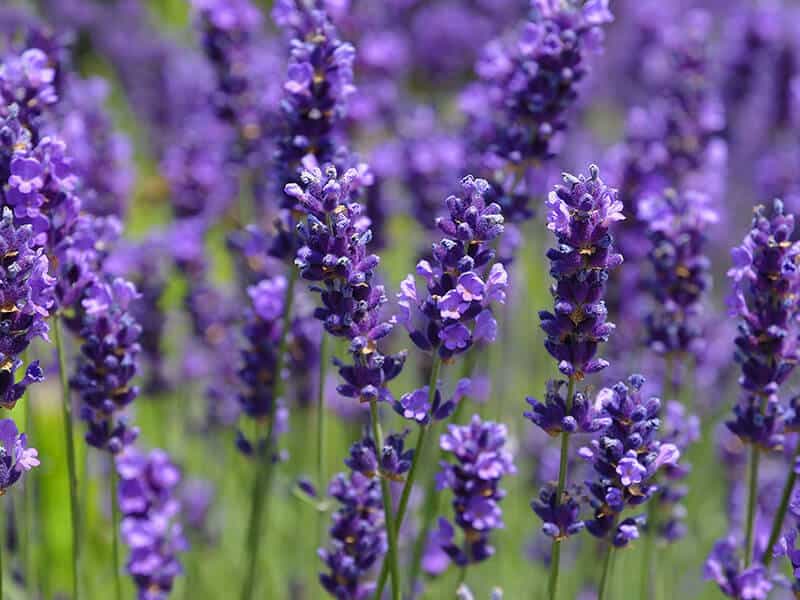
Lavender or Lavandula is one of the most popular plants for the garden, well known for its captivating fragrance and lovely appearance. The plant also attracts the most common pollinators to your garden and works perfectly as cut flowers.
Lavender isn’t tricky to grow. The soil can be average, and the plant can grow in full sun or partial shade.
You can see this video to know more:
127. Lilac
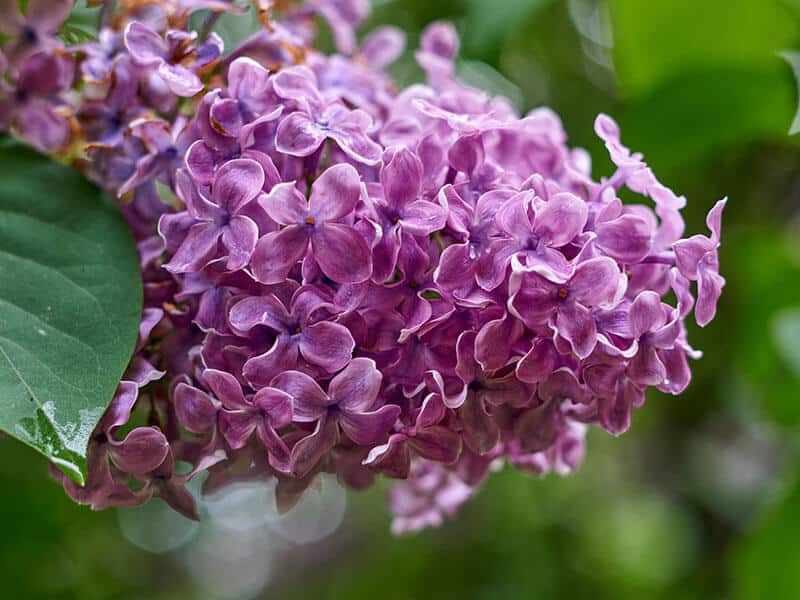
If you are looking for a classic garden shrub, pick Lilac or Syringa vulgaris. You can choose from numerous varieties with single, double, pink, purple, or white flowers. Most varieties are low-maintenance and disperse captivating aromas.
Neutral or alkaline soil is suitable for Lilac, and full sun locations. Don’t forget to prune the plant after the flowering season to prevent it from looking leggy next year.
128. Lily
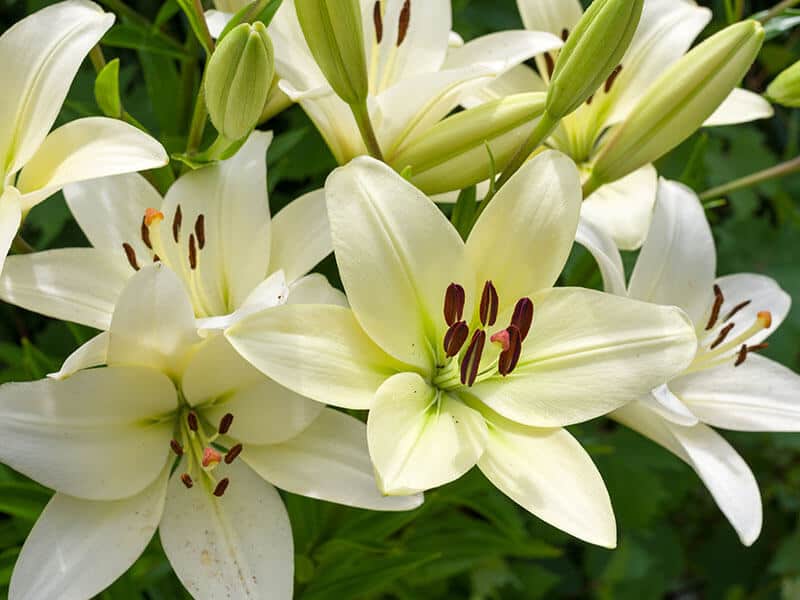
Lilies are adored for their pretty color and summer scent, and their popularity isn’t decreasing for decades now. These bulbs are great for flower beds, raised beds, and containers. Most common varieties have pink or white flowers and similar growing conditions.
Those include neutral or alkaline soil, full sun, or dappled shade.
129. Lily of the Valley
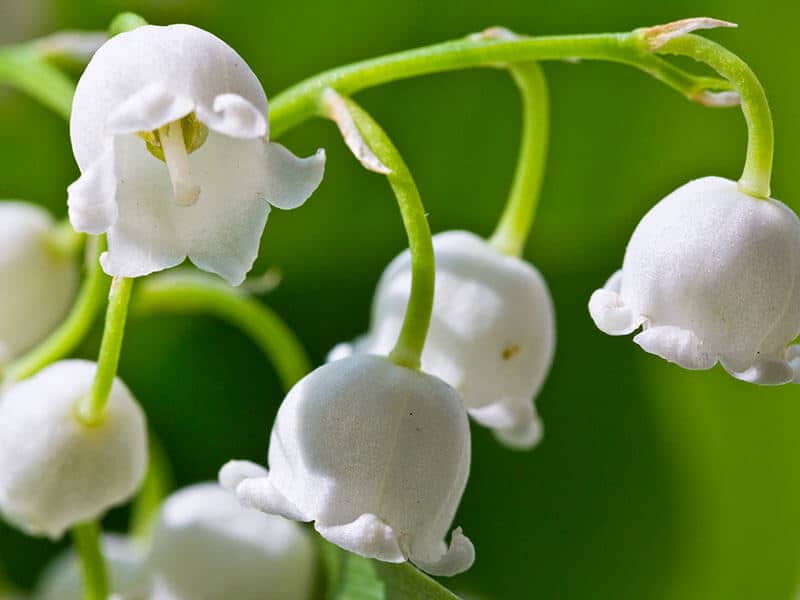
Popular wildflower, Lily of the Valley, develops small, bell-shaped, pure white or pink flowers. It is one of the prettiest, low-growing flowering plants you can grow without special effort in your garden.
Partial shade is ideal for Lily of the Valley. Also, be cautious, the plant is known to be an aggressive spreader and doesn’t need much to overpower the entire garden.
130. Linaria

Linaria belongs to the Snapdragon family and looks the most attractive from May to September. The plant needs sand-based soil and is excellent as an underplant for roses and taller shrubs.
In general, Linaria is easy to grow, but it is sensitive to overwatering. Keep the plant well-watered, but ensure excellent drainage to prevent root rot. For Linaria, deadheading is beneficial and the removal of dead foliage.
131. Lobelia
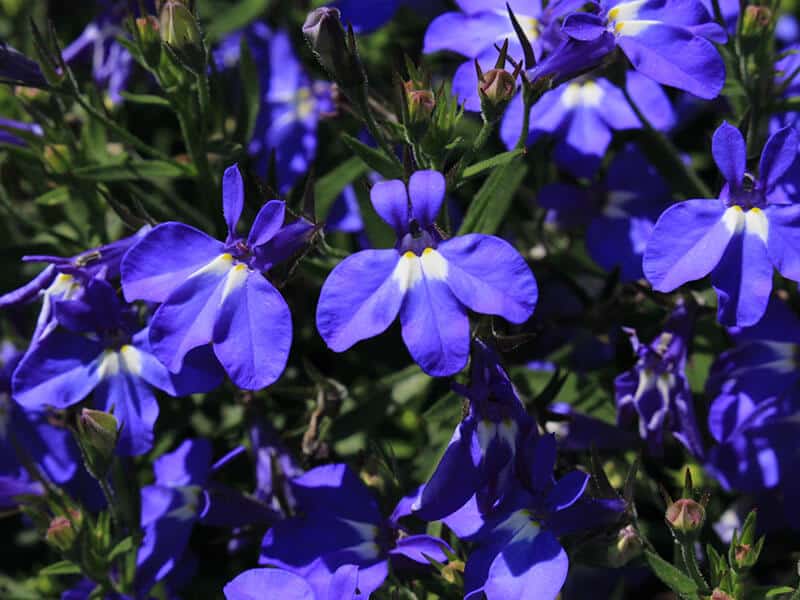
Lobelia is the striking blue plant that looks best as a bedding plant, in containers or hanging baskets. There are several annual, biennial, and perennial varieties of Lobelias, which grow in various growing conditions.
Most need reliably moist soil, full sun, or partial shade. Don’t forget to mulch in the winter to protect the roots from freezing.
132. Lotus
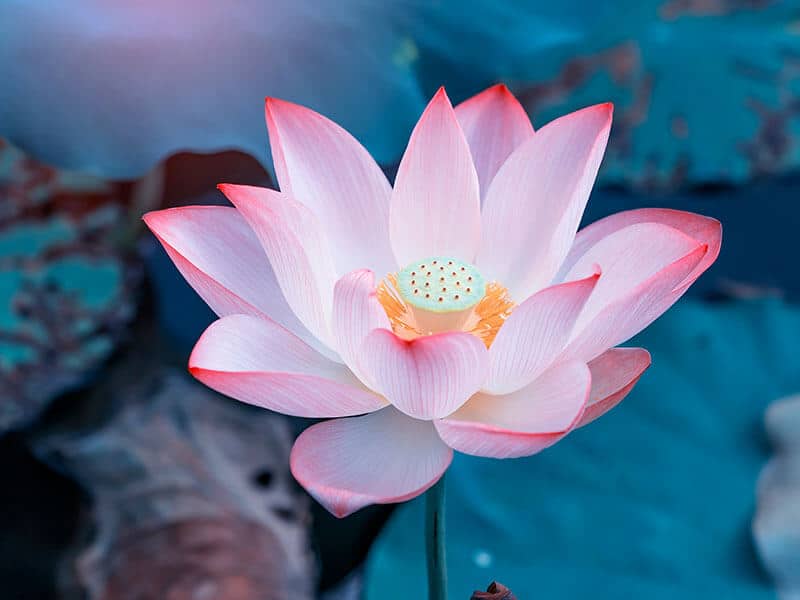
Beautiful Lotus flowers are available in white, yellow, lavender, pink and blue color. They start blooming early in the summer and look attractive until the end of the season. Lotus or Nelumbo nucifera is one of the most attractive aquatic plants! It is also the national flower in India.
You have the best chances of growing Lotus in a watertight container.
133. Love in the Mist
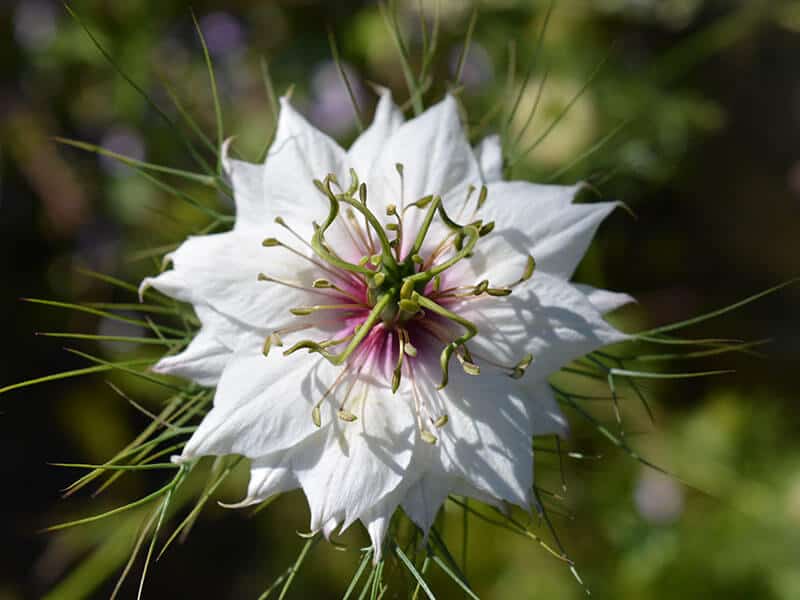
Love in the Mist or Nigella is a retro plant that starts blooming in the spring. It is easy to grow in all types of soil and conditions. However, the Love in the Mist doesn’t respond well to transplantation. Upon planting, pick a permanent location.
Also, the plant is better suited for cooler temperatures than warmer climates.
134. Lupin
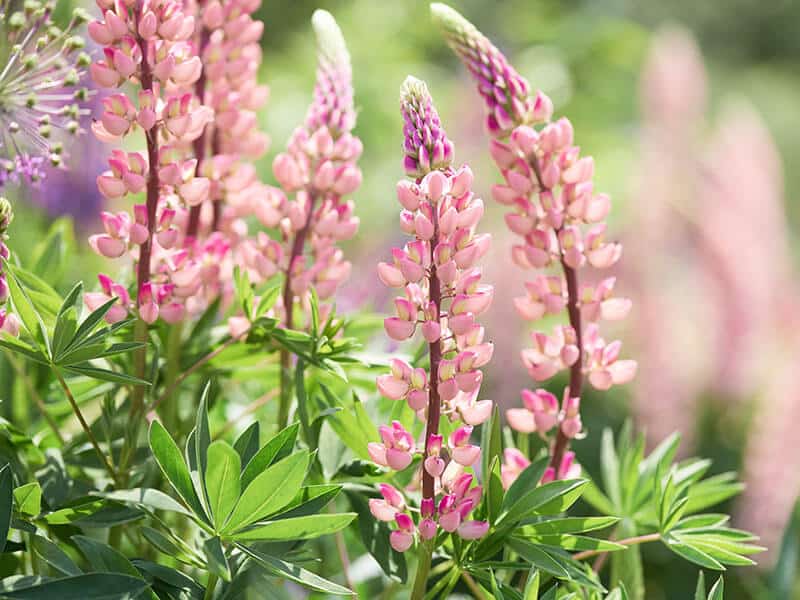
All you have to do if you want to grow Lupin flowers is plant seeds or established plants in a sunny area and well-draining soil. These lovely plants are tall and spiky and add pleasing color and texture to flower beds.
The plant needs average soil and balances nitrogen levels in the ground. Therefore, you can plant it in the vegetable garden to improve the soil quality for your crops.
135. Magnolia
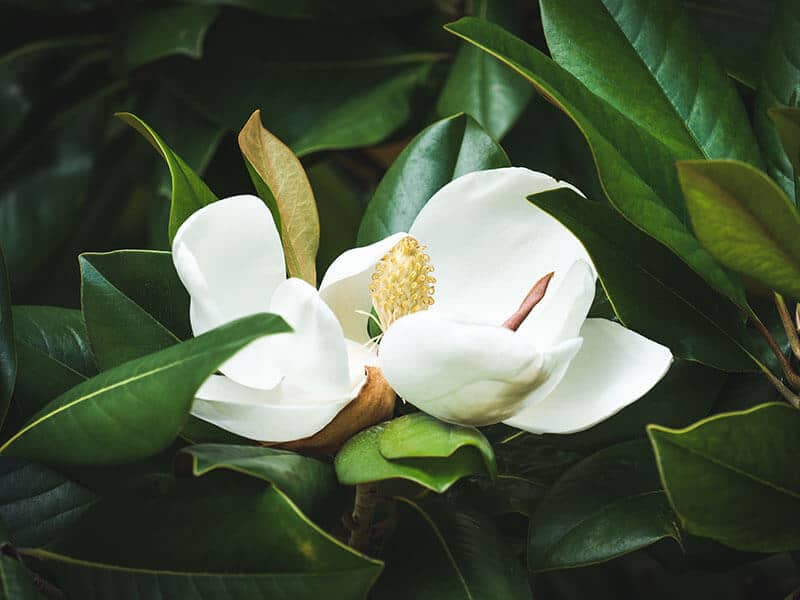
Magnolia is a glamorous shrub with tubular flowers in attractive colors such as white, pink, purple, and yellow. Most beautiful Magnolia varieties (internal link keyword “Types of Magnolia”) develop fragrant flowers.
Neutral or acidic soil is great for Magnolias. But, if the garden soil is poor, you can pick dwarf Magnolia cultivars and grow them in pots.
136. Maltese Cross
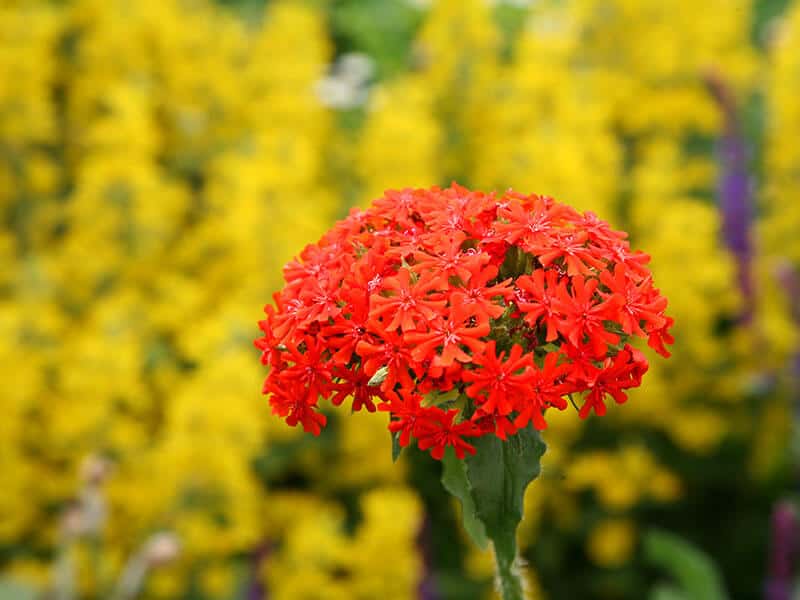
Maltese cross flowers have several names – Bristol plant, Jerusalem cross, and the scientific name is Lychnis chalcedonica. Most common cultivars have scarlet red flowers, but better-supplied nurseries may offer you ones with white or pink blooms.
The plant needs acidic, evenly moist soil and full sun exposure. Mature plants spread about 1.5 feet and grow up to four feet tall.
137. Mandevilla
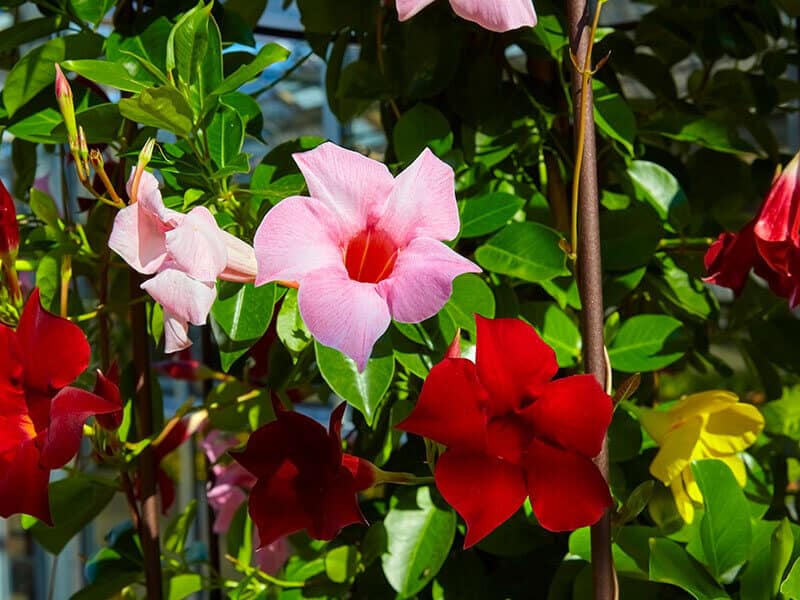
Mandevilla or Chilean Jasmine is a lovely tropical vine that attracts hummingbirds and beneficial insects. In warmer zones, people grow Mandevilla as a perennial. But, if you live in a cold region, grow Mandevilla as an annual plant, or bring it indoors for protection.
Blooming season starts in late summer. But, if you grow it indoors, Mandevilla rarely blooms. A sheltered position in full sun is remarkable for this tropical vine.
138. Marguerite Daisy
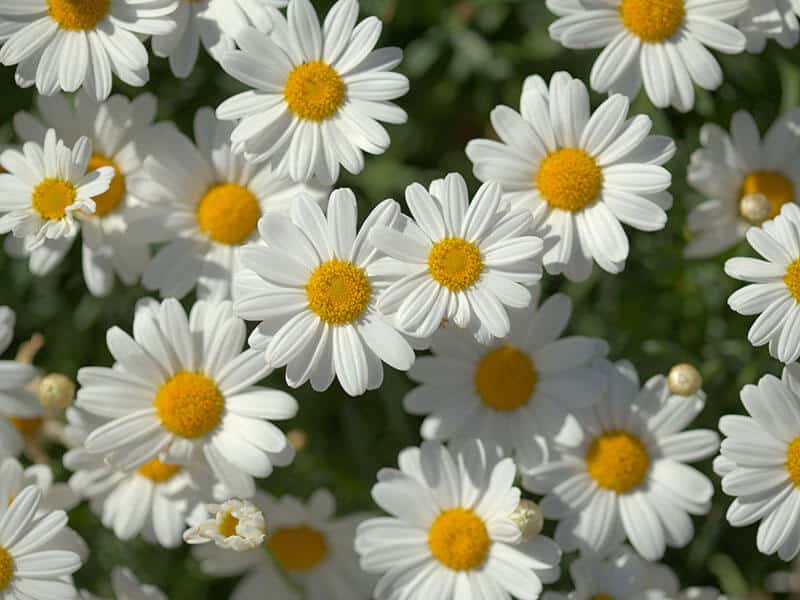
Marguerite Daisy or Argyranthemum are versatile plants. You can grow them for cut flowers, for added color in garden borders, flower beds, or containers, and as houseplants.
These flowers look like true Daisies and grow up to three feet in height. Established flowers are low-maintenance and have a long blooming time.
Water them once a week and provide them with six hours of sunlight per day.
139. Matthiola
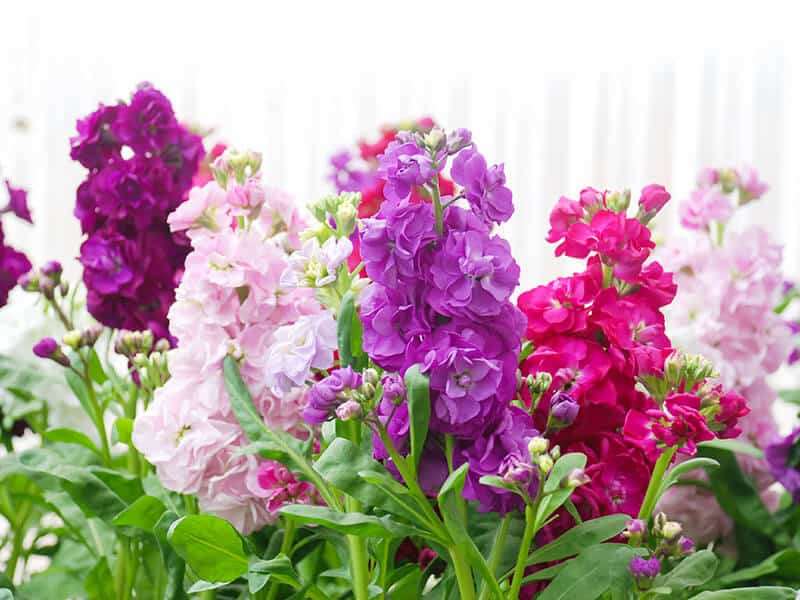
Matthiola is a lovely bushy plant that doesn’t grow taller than 12 inches. Flowers appear in the shades of purple, blue, white, and red, and spread pleasant science.
The plant is easy to grow in zones from two to ten and is also known by Stock flower name.
140. Mayflower
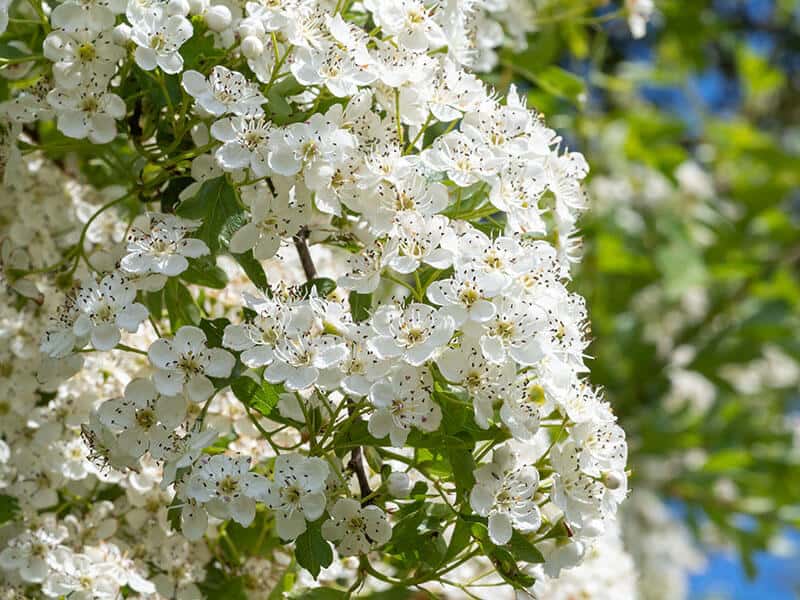
Mayflower is a famous herald of spring and one of the easiest plants to grow. Choose humus-rich soil with consistent moisture and excellent drainage. The plant provides a stunning display of pink and white flowers with a captivating aroma.
Mayflowers are important for early emerging pollinators because they provide essential nectar.
141. Mimosa
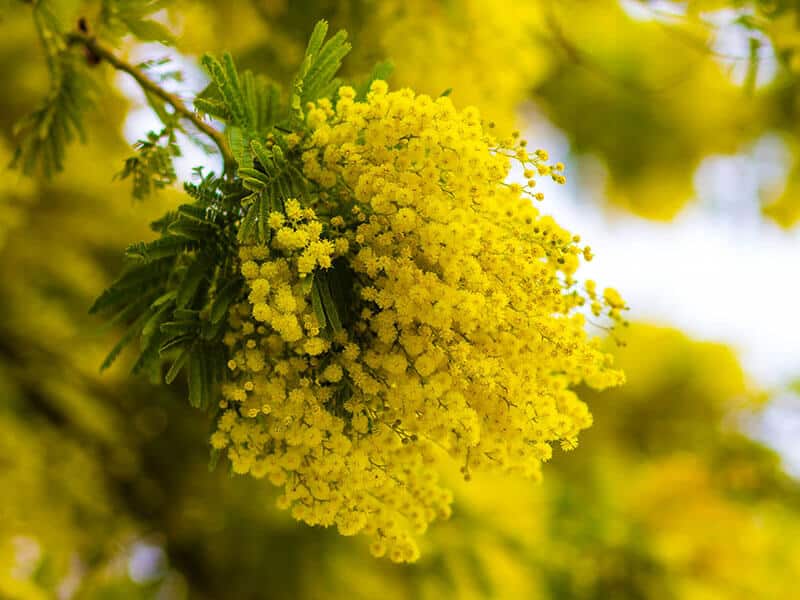
The ideal time to plant Mimosa is spring. It is a beautiful winter-flowering shrub and develops spectacular yellow flowers.
Mimosa grows best in full sun and sandy soil with excellent drainage. In the ideal conditions, Mimosa can grow up to 30 feet. But in most cases, it remains shorter than 20 feet.
You have to prune the plant to maintain a tidy appearance.
142. Mina Lobata
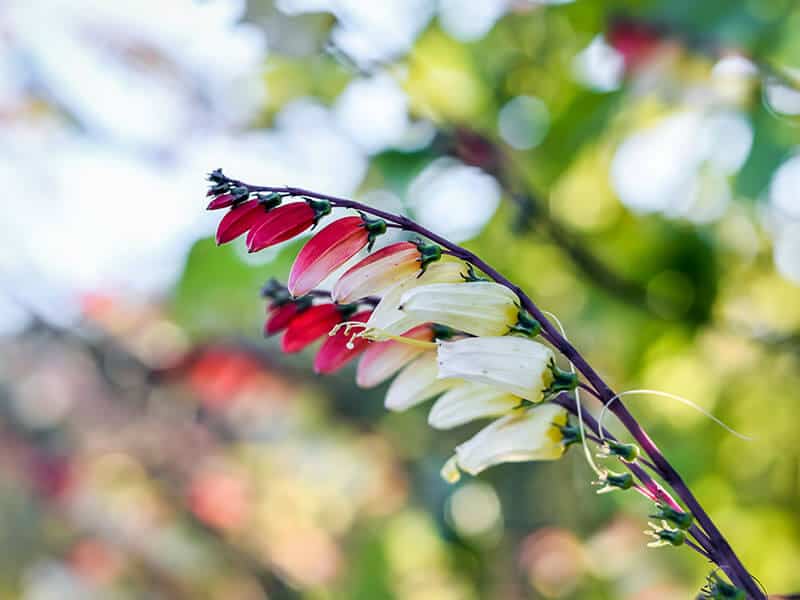
Mina Lobata, or the Spanish flag, is a popular vine with eye-catching flowers. In zones ten and 11, Mina Lobata is a hardy perennial and an easy vine to grow. Outside these zones, people grow it as an annual.
In proper conditions, Mina Lobata is a fast grower. In one season, the vine can grow between six and ten feet!
It is most beautiful in midsummer when attractive flowers appear. The vine dies with the first frost.
143. Nasturtiums
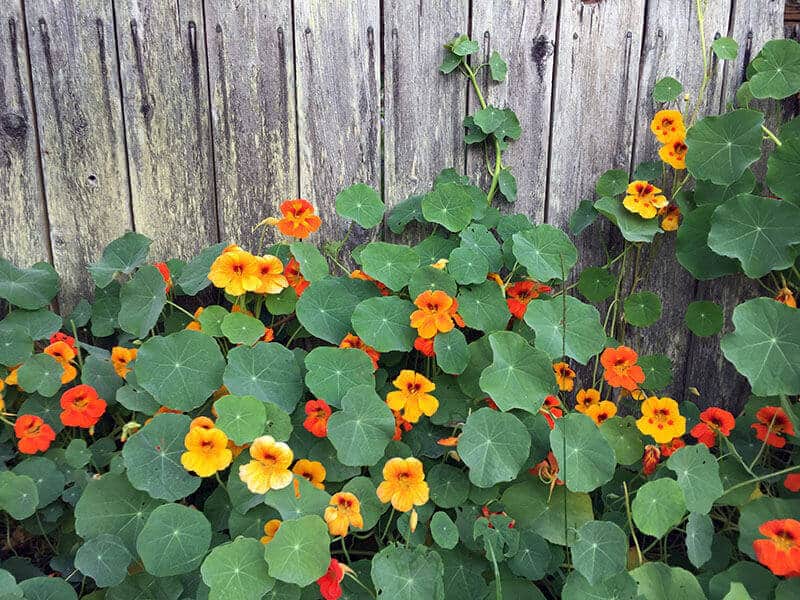
Nasturtium or Tropaeolum grows quickly and is a perfect colorful addition to your garden. The plant features dark, blue-green foliage, a bushy growth rate, and vivid blooms. Orange, yellow, and red flowers are more common, but you can also find pastel flowers in white and salmon pink.
Nasturtiums are easy to grow from seeds and suitable for beginners and children! People also love them as cut flowers.
144. Nemesia
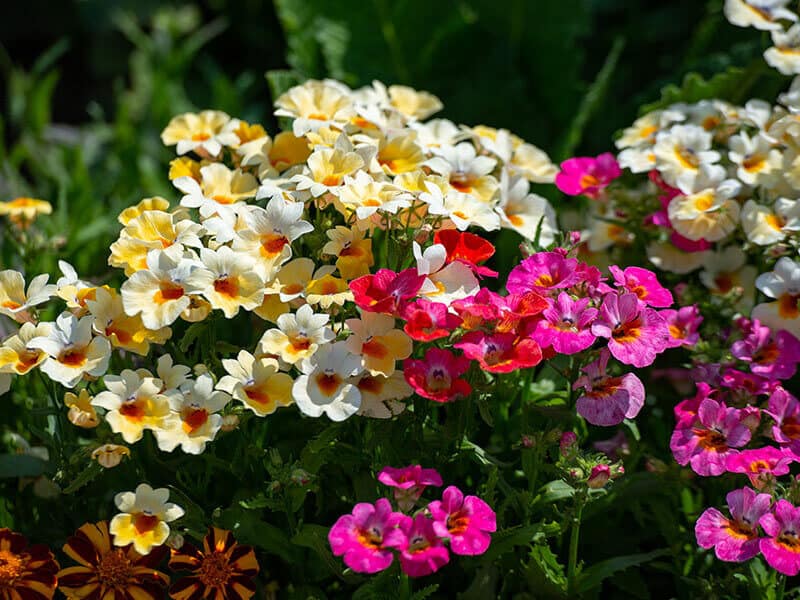
Nemesia belongs to the Plantaginaceae family, and you can start it from seeds or cuttings. The plant is popular as an attractive ground cover. The flowers are similar to orchids, but they are significantly easier to grow.
Nemesia tolerates partial shade and moist soil. To boost the growth of your plants, apply a slow-release fertilizer in spring. When taking care of Nemesia, pruning is essential to keep the plant healthy and tidy.
145. Nemophila
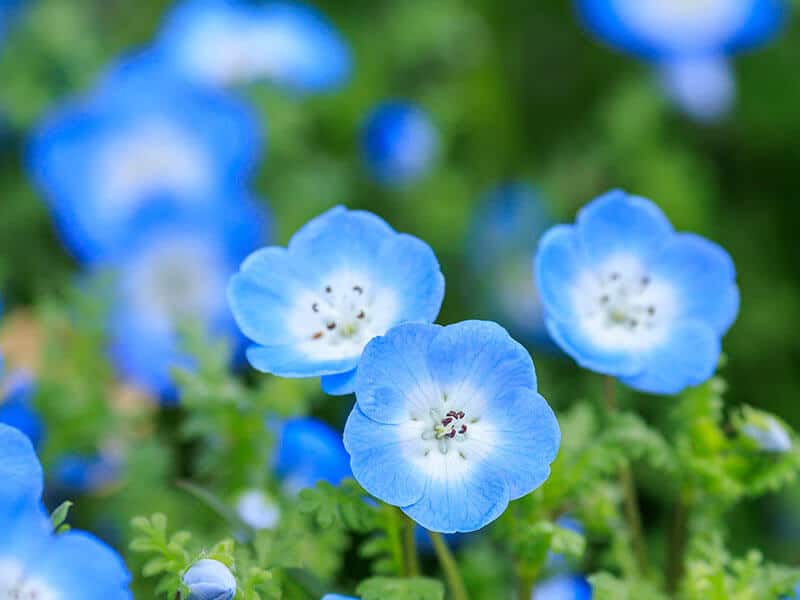
Nemophila tolerates a variety of soil types. You can plant it in alkaline, neutral or acidic soil, sand, chalk, or clay. Protection from winds and drafts is important, and the plant doesn’t mind growing in partial shade.
You can plant Nemophila in flower beds and garden borders. Nemophila flowers are better suited for informal garden settings, but you can combine them with other plants in formal gardens.
146. Nepeta
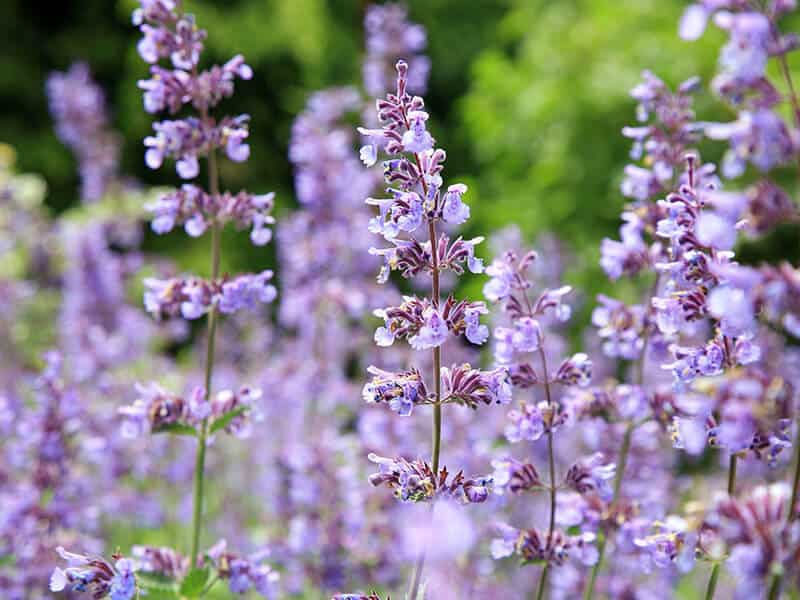
Nepeta got the common name Catmint because its lovely foliage attracts cats. It is an easy-going perennial plant with silvery leaves and charming bluish flowers.
Nepeta needs well-draining soil and a lot of sunlight to grow. If you decide to grow Nepeta from seeds, start it in spring or fall.
147. Nicotiana
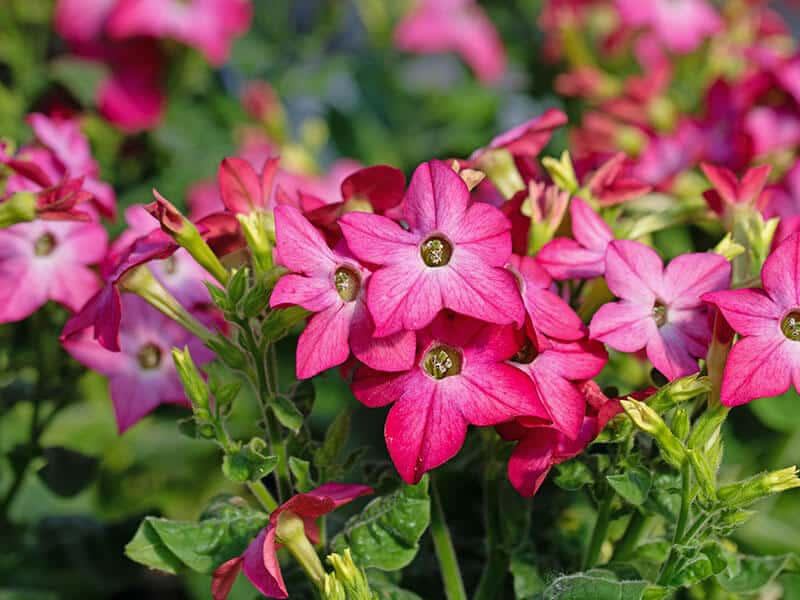
Nicotiana or Tobacco plant is available in different colors and sizes.
Most cultivars develop trumpet-shaped flowers which distribute aroma at night! You can grow it in mixed planters or as a bedding plant.
Nicotiana also provides lovely cut flowers, which remain good-looking for a long time. The plant needs six hours of sunlight and moist soil with excellent drainage.
148. Nolana
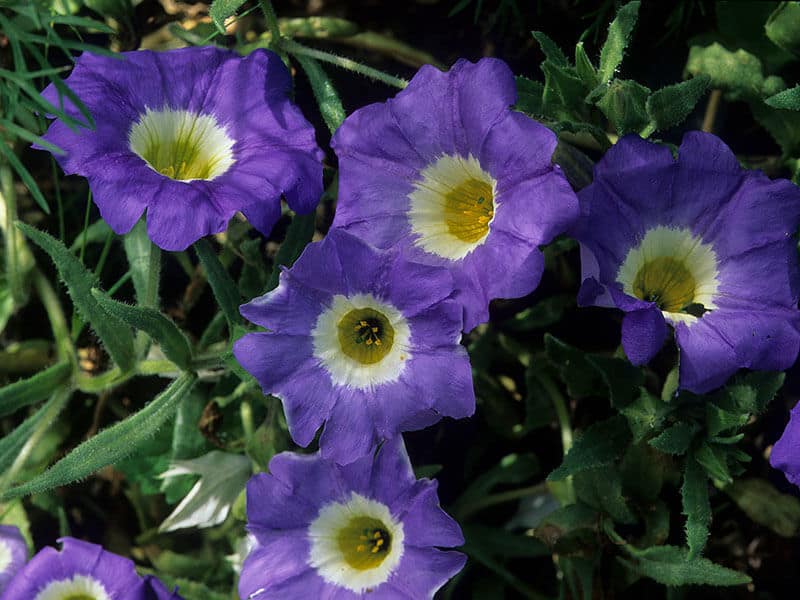
Nolana flowers have bright yellow centers and bright-colored petals. The plant is tricky to grow from cuttings, and growing from seeds is generally an easier path to take.
Once your Nolana or Chilean bell flower gets established, the plant is ridiculously easy to grow. It doesn’t need fertilization or a lot of water.
149. Orchid
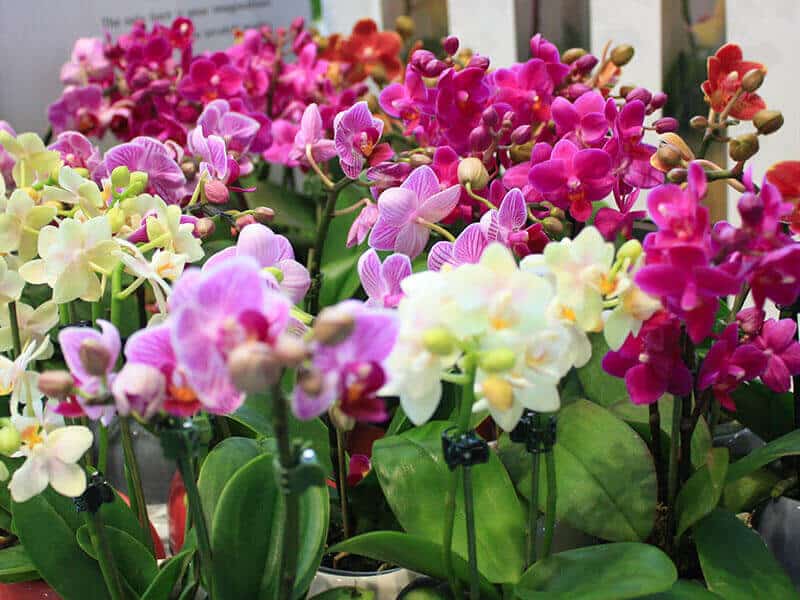
Orchid flowers are one of the most spectacular Mother’s Nature masterpieces. But, the Orchid isn’t a plant for everyone.
Growing Orchids indoors (internal link keyword “How to grow Orchids indoors”) can be tricky because they are prone to bacterial and fungal diseases due to improper care.
Strong, filtered light is best for Orchids flowers. High humidity is another condition as well as proper air circulation. Heavy watering mixed with dry periods works the best for Orchids.
You can see this video to know more:
150. Oriental Poppies
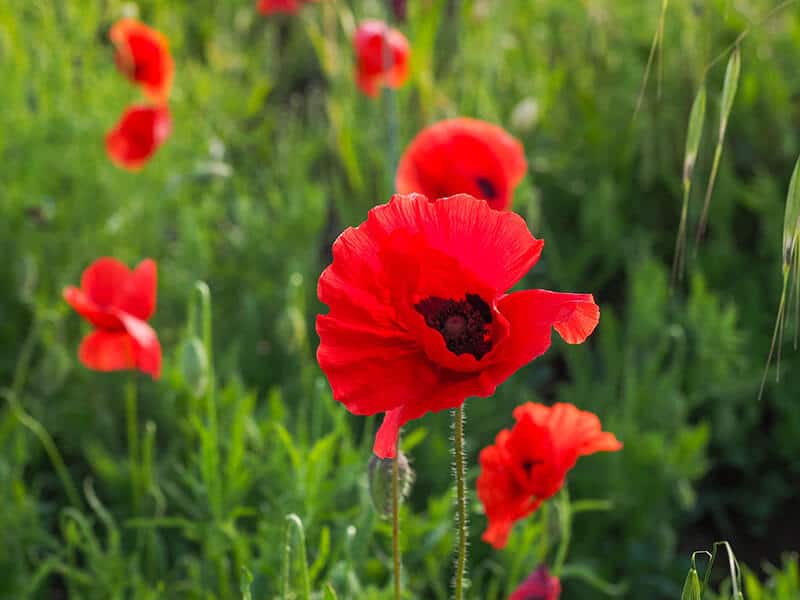
Oriental Poppies or Papaver plants prefer fertile soil and need a lot of root space. Dig a deep hole which can hold the entire plant taproot. Upon planting, enrich the soil with compost to help the plants bloom as early as possible.
After the blooming season, Oriental poppies die back.
151. Osteospermum

Only a few plants will reward you with such rich colors in a wide range of colors, Like Osteospermum. They are also called Cape Daisy flowers, and belong to the Calendula family.
The plants need only minimal effort to produce showy flowers! Osteospermums are adaptable to different soil types, including poor soil. Don’t plant them in the shade, if you want your Cape Daisies to bloom.
152. Oyster Plant
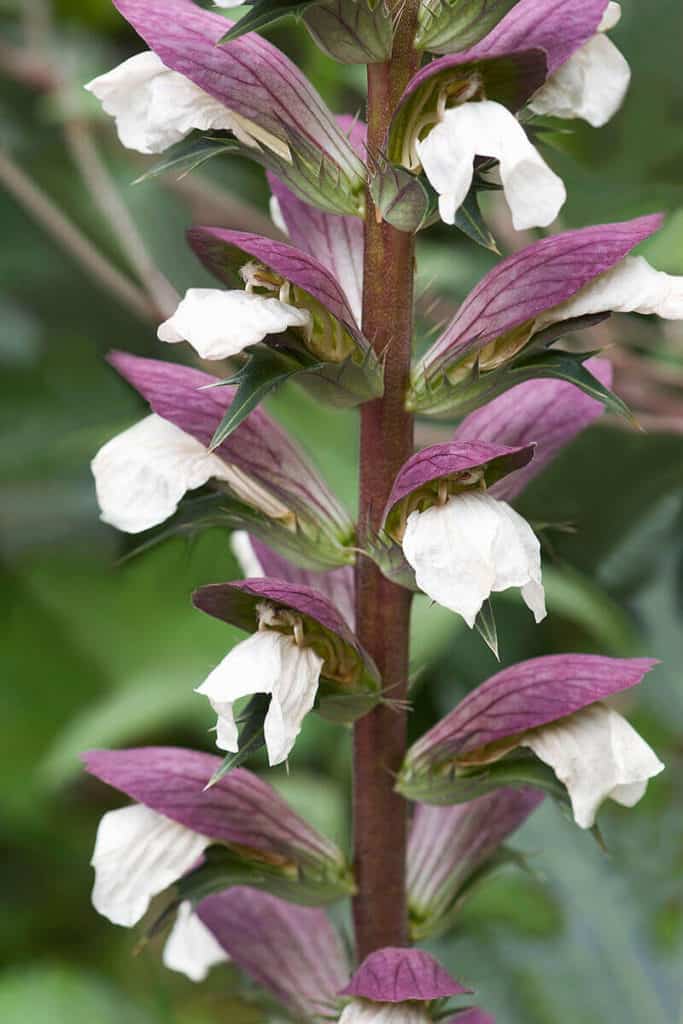
Oyster plant is a popular houseplant in colder regions, and a hardy perennial in warm climates. It has eye-catching foliage, but also develops attractive pink or white blooms.
Plant Oyster flower in full sun or dappled shade location in acidic or neutral soil. However, too much direct sunlight can scorch the leaves and cause stunted growth.
153. Pansy
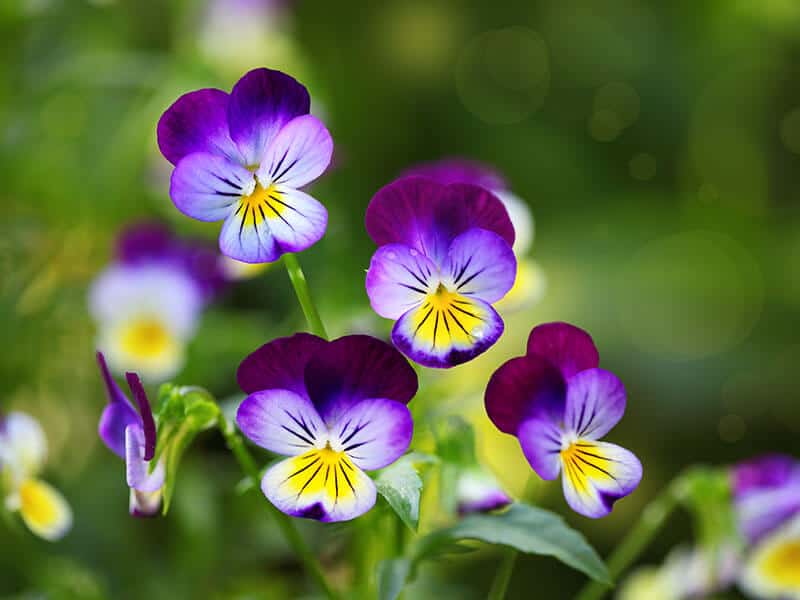
Pansies are all-time favorite garden flowers, loved for their bright blooms and low-maintenance nature. There are so many cultivars and hybrids of Pansies, available in spectacular colors and color combinations.
Overall, Pansies thrive in organically-rich soil and when they receive six hours of sunlight. You can add slow-release fertilizer to the soil at the time of planting to boost the growth and promote gorgeous flowers.
154. Passion Flower
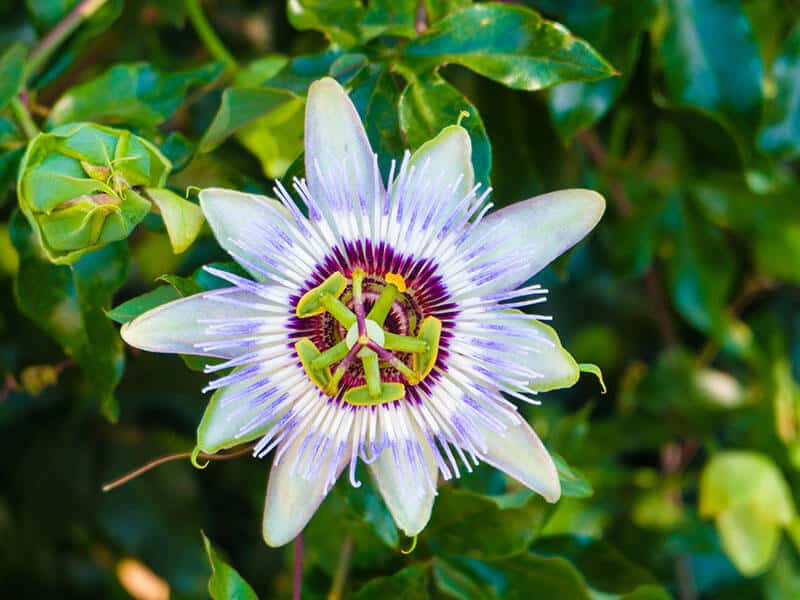
Passion flower or Passiflora is one of the most unusual flowers you have ever seen. The plant features attractive foliage as well and doesn’t need special gardening skills to thrive.
You can grow it in partial shade, in a warm and protected area. In spring, cut the plant back to the ground to promote new growth. Passiflora is a climber and it won’t take long until the plant covers a nearby wall, fence, or trellis.
155. Pelargonium
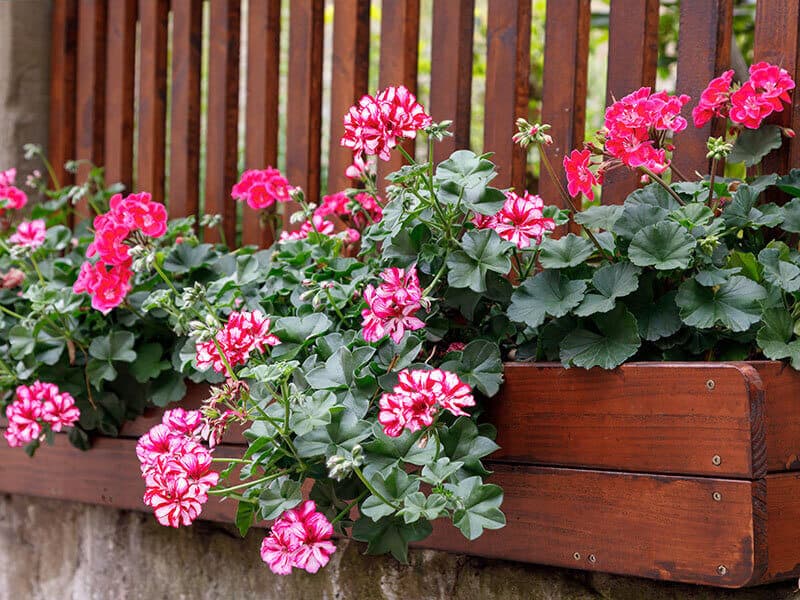
Pelargoniums are vibrant and add stunning color to garden beds and containers. You can also grow them in mixed containers, in tree stump planters, window boxes, or hanging baskets.
Plant Pelargoniums in early spring, in a sunny spot in your garden. Water them every two or three days, until your Pelargoniums get established. Then, they become easier to maintain.
156. Penstemon
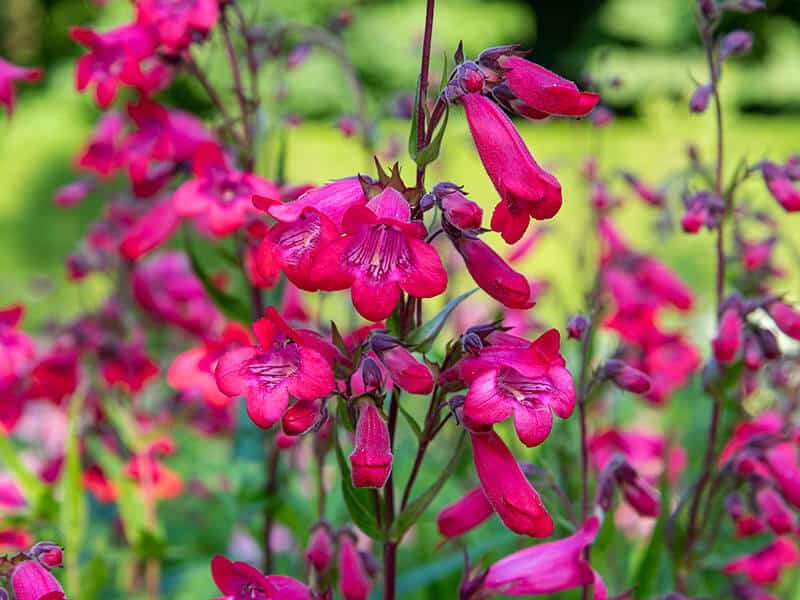
Wonderful Penstemon flowers prefer moist soil with excellent drainage. If you live in a hot climate, choose a partial shade for Penstemons. Otherwise, full sun will help them thrive.
Other steps you can take to grow Penstemons are annual mulching and weekly fertilization in the summer.
157. Peony
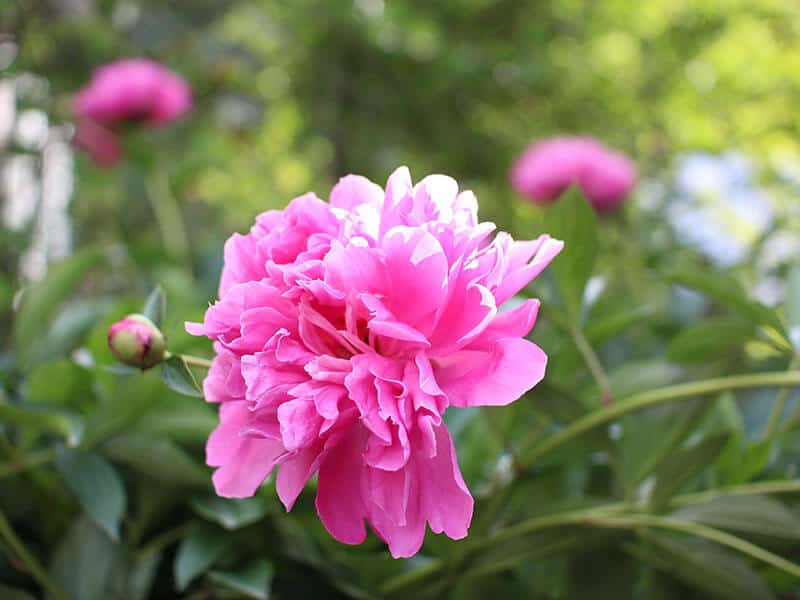
Peonies feature delicate flowers but they are actually quite hardy plants and easy to grow. You can grow them in large containers for several years, but your plants will be happier in the ground.
Peonies need rich and loose soil. Waterlogged soil leads to rot diseases and less showy blooms. In addition, plant Peonies in a sheltered area and keep them moist.
158. Petunia
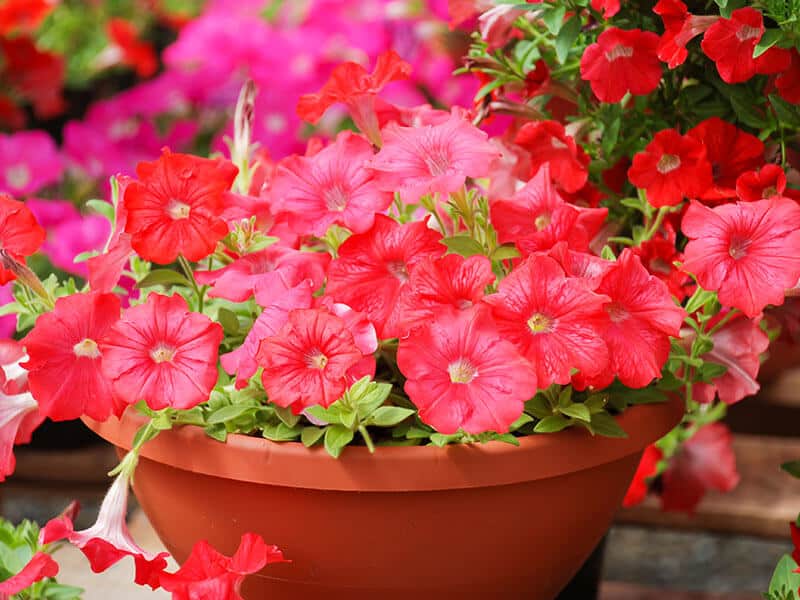
Petunias are common in all types of gardens. They aren’t frost-tolerant so wait for the last frost to pass to start them in your garden.
These flowers need rich soil. You can boost the quality of the soil with well-rotted compost or fertilizer before you plant Petunias to provide better chances for success.
If you want to prevent your Petunias from looking spindly, grow them in a full sun location.
159. Pincushion Flower
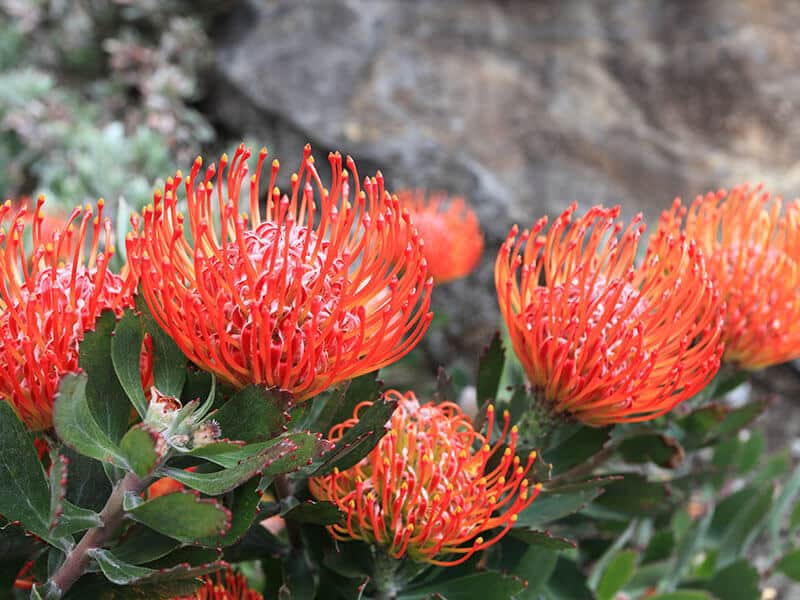
Pincushion flowers are easy to grow from seeds. In addition, some nurseries transplant plants.
These flowers perform ideally in organic-rich soil with fast drainage. Peat moss will improve the quality of the soil for the Pincushion flower, and you can also use compost or rotted manure. The more sunlight Pincushion flowers get, the better.
160. Poinsettia
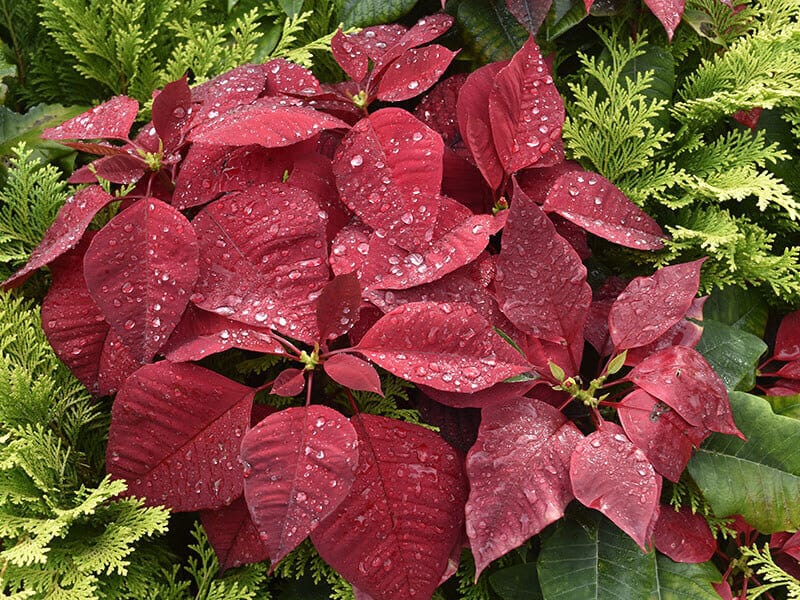
Poinsettia is a famous Christmas flower that doesn’t actually produce flowers. What you see as flowers are colorful bracts or modified leaves.
Nevertheless, Poinsettia is an attractive plant, suitable for regions with temperatures above 65 degrees. The plant needs four or five hours of sunlight, and organic-rich soil.
161. Polyanthus
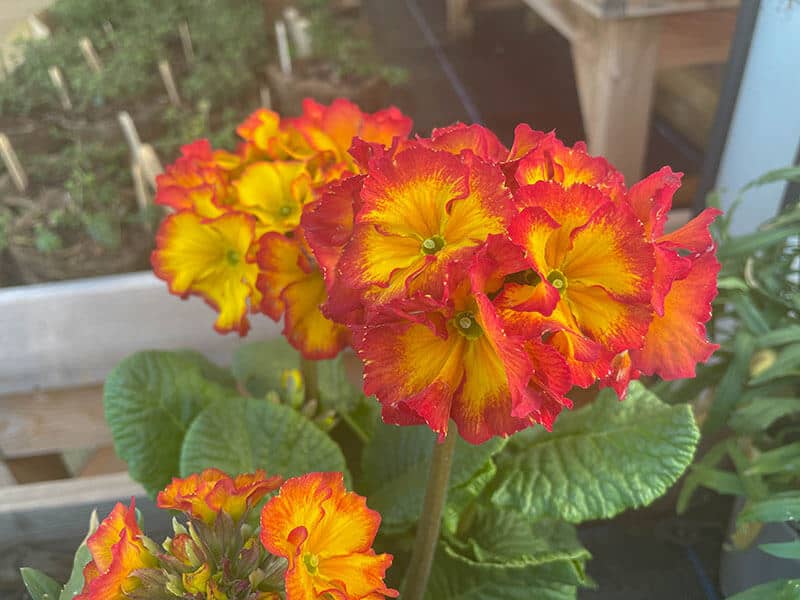
Bright Polyanthus flowers easily transform any landscape in the blooming season, from July to October. These flowers are suitable for containers and gardens and available in an excellent range of colors.
The key to success when growing Polyanthus is to prepare the soil in advance. Mix a lot of compost and add pelletised fertilizer to the soil. Don’t forget to mulch to help the soil retain moisture.
162. Portulaca Grandiflora
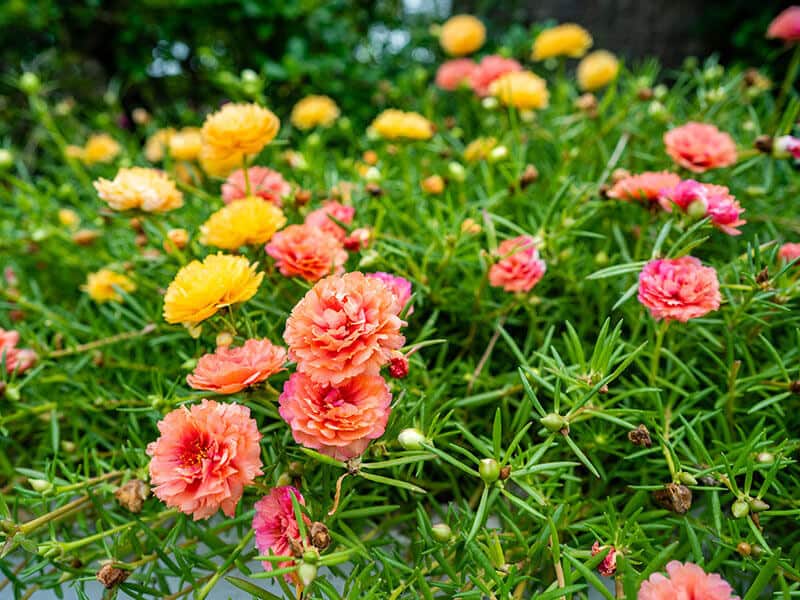
Portulaca Grandiflora or Moss rose is a popular flowering succulent, great for dry and warm climates. With minimal care, Portulaca Grandiflora blooms throughout the entire summer and provides bursts of color in summer gardens.
You can also grow it in containers, or mixed with other plants for attractive succulent displays.
163. Primula
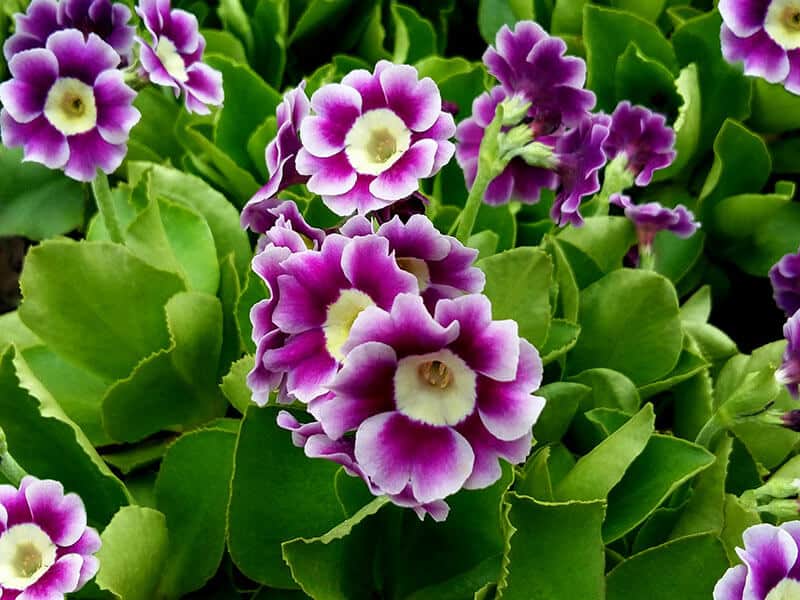
Primula is suitable for partial shade and moisture retentive soil. The plant requires simple care. You can start it in spring, deadhead after the blooming season. If you don’t deadhead Primulas, the plants will self-seed and spread around your garden.
Every few years, you need to divide Primulas to rejuvenate them and prevent diseases.
164. Quaker Ladies
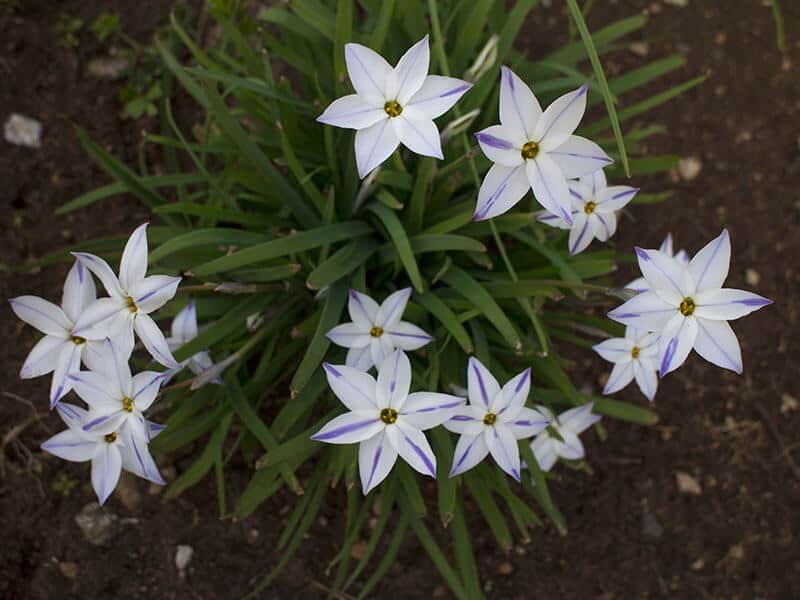
Quaker Ladies or Houstonia flowers are small and charming, available in white, blue, yellow and pink. The plant is an easy-care creeping perennial, which starts the blooming season in spring. But Quaker Ladies continue to bloom during the entire year.
You can grow it as groundcover, pathway liner or bedding plant. Quaker Ladies are an excellent natural weed killer.
165. Queen’s Cup
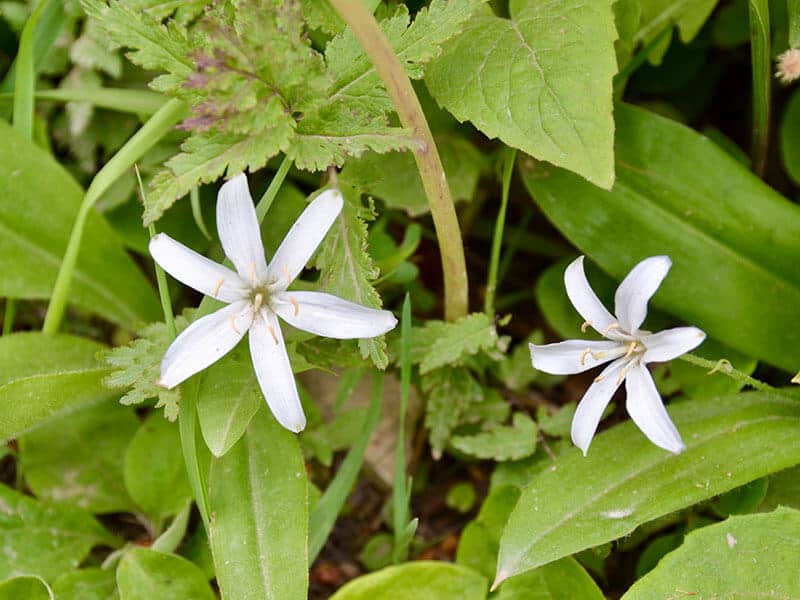
A beautiful perennial flower, Queen’s cup, belongs to the Lily family. The plant is native to North America mountains and is suitable for growing in full shade. It needs evenly moist and rich soil to grow to its full potential.
The flowers are large and showy with six distinctive petals. Growing a Queen’s cup takes time from seeds, because the plant needs several years to bloom. Starting it from root division is much faster.
166. Queen of the Meadow
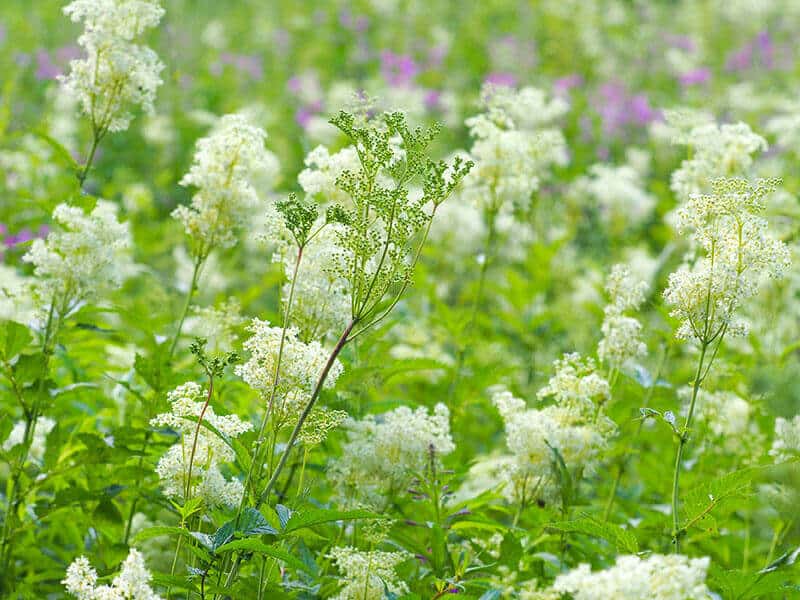
Queen of the Meadow or Filipendula is tricky to grow from seeds. The seeds need to go through cold stratification to be able to germinate. The entire process may last up to three months.
The plant is somewhat tolerant of wet soil and grows particularly well in partial shade or full sun. Furthermore, mulching in spring and summer helps the soil retain moisture.
The fragrant flowers appear on short stalks and have five petals.
167. Rock Rose
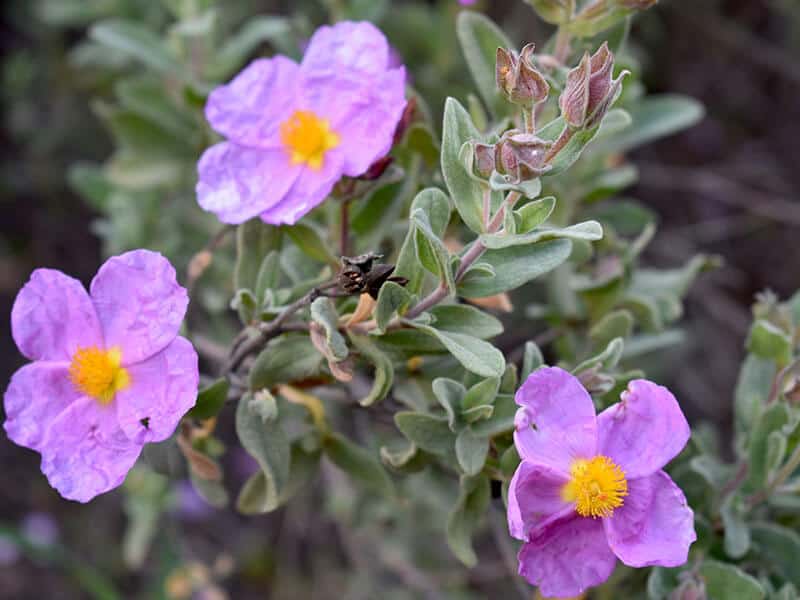
Rock rose, or Cistus incanus, is an easy shrub to grow. Pick a full sun location with deep soil so the plant has enough space to spread roots.
Rock rose shrub is a great, low-maintenance plant that grows where most other shrubs won’t.
The shrub tolerates different soil types and temperatures and only needs frequent watering and fertilization in the first season.
168. Rondeletia
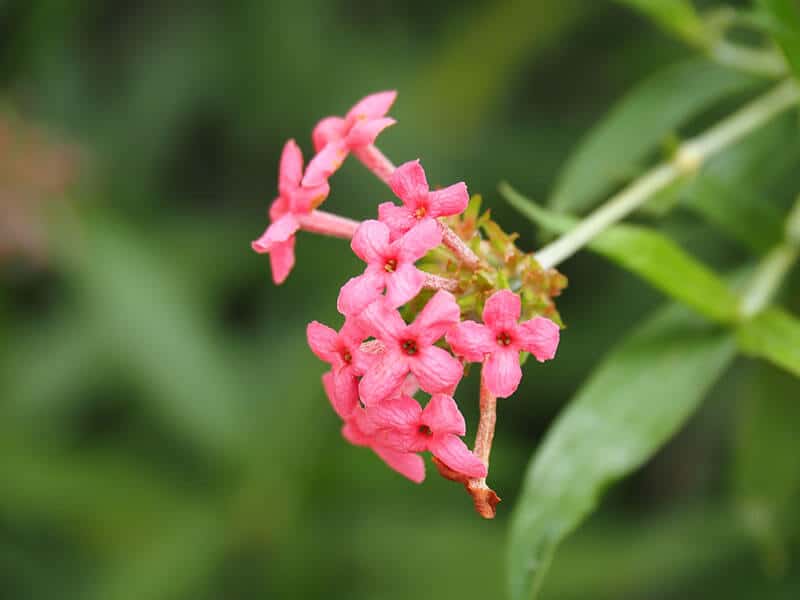
Rondeletia is a beautiful tall evergreen shrub that is perfect for landscaping. You can add it to garden borders or grow it as an informal hedge.
The shrub blossoms every spring. The second blooming season starts after four months.
The flowers are small, salmon pink, and have a sweet aroma. The shrub is drought tolerant and provides year-round visual interest to your garden.
169. Rose
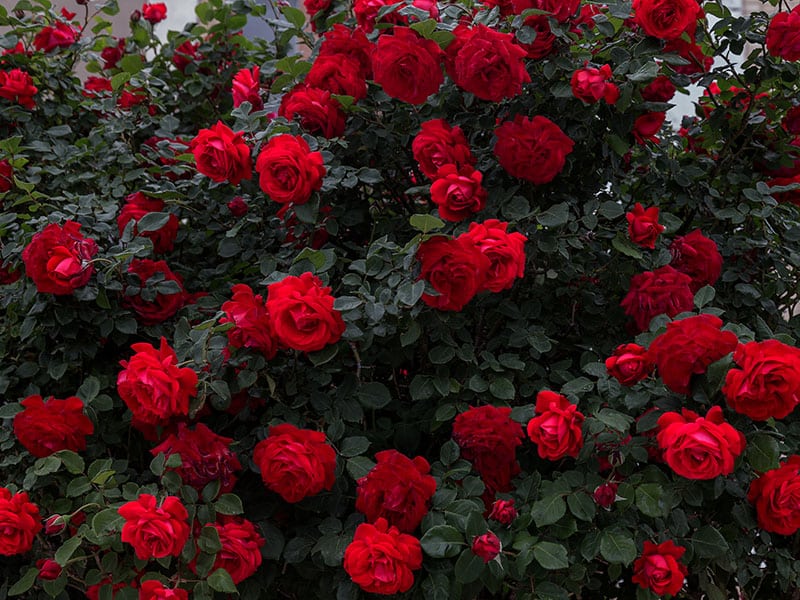
Rose is one the most widely spread and cultivated perennials ever, and a beautiful cut flower. Some rose varieties are thornless, and they are available in different sizes and flower colors.
People also choose climbing Rose cultivars, as a beautiful addition to their patio and garden trellises.
Most cultivars grow best in soil pH between 6.0 and 6.5, with regular mulching and pruning.
170. Salvia Splendens

Salvia splendens or Tropical Sage provides wonderful red, white, blue, pale pink, and multicolored flowers. The average height of mature Salvia splendens is between eight and 18 inches, and the average spread is around 12 inches.
Salvia splendens need six or more hours of sunlight per day and moderate watering. It looks beautiful in bouquets and containers on the patio!
171. Saponaria
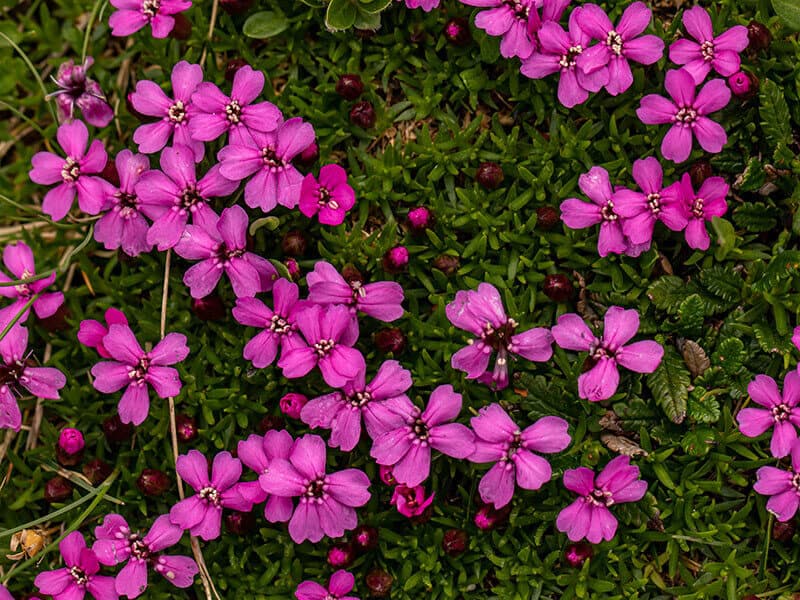
Saponaria is also known as the Soapwort plant. It develops gorgeous clusters of purple and pink flowers, which match informal and cottage garden settings the best.
The average height and spread of Saponaria are around 20 inches, and the plant is low-maintenance. In well-draining soil with plenty of moisture, Saponaria will bloom the entire summer!
172. Scaevola
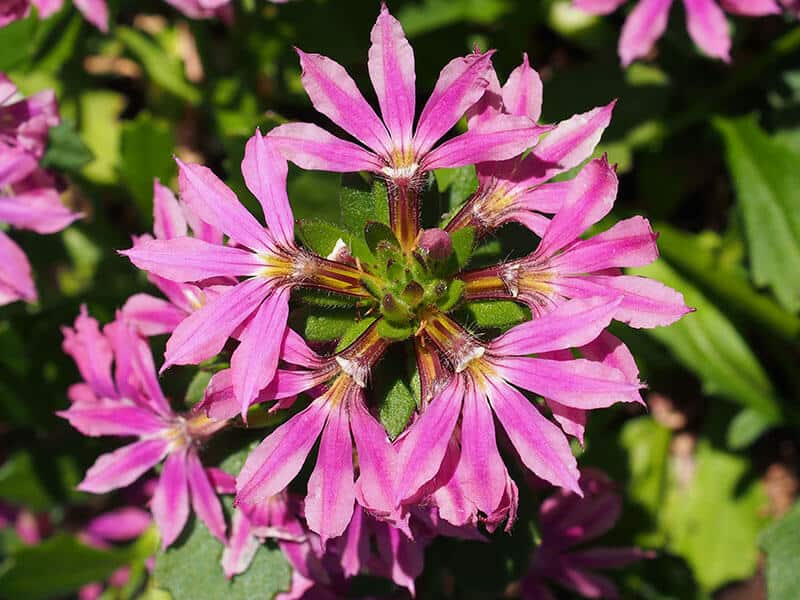
Scaevola features fan-shaped, five-petaled flowers, frequently in shades of blue, pink, purple, and white. Scaevola is self-cleaning, so you don’t have to bother with dead-heading.
Scaevola is the perfect plant for hot and dry summers.
Plant it in average soil and water moderately. The soil should be dry to touch between waterings.
173. Sedum
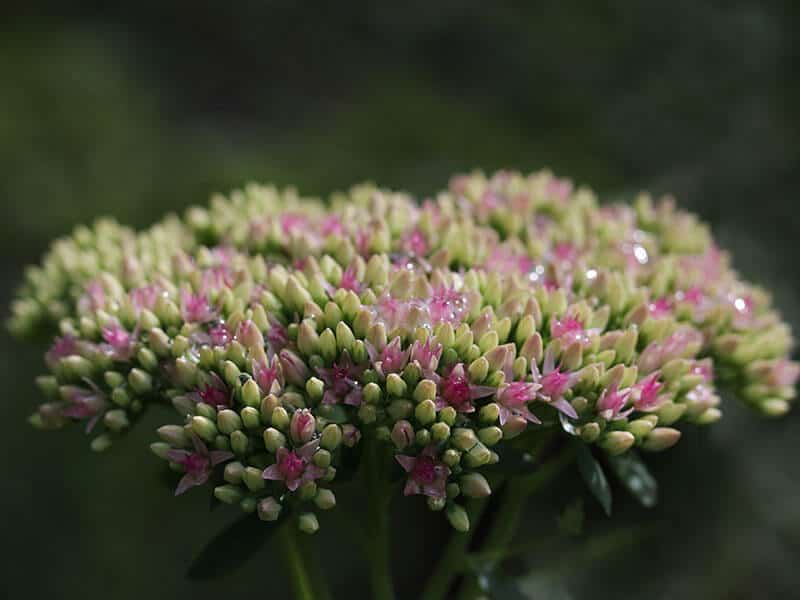
There are two types of Sedum succulent – creeping and clumping. In general, creeping cultivar grows better in partial shade, while clumping and taller varieties thrive in full sun.
The plant doesn’t need extensive moisture, except in the first year. After that, it becomes drought tolerant.
You can see this video to know more:
174. Silene
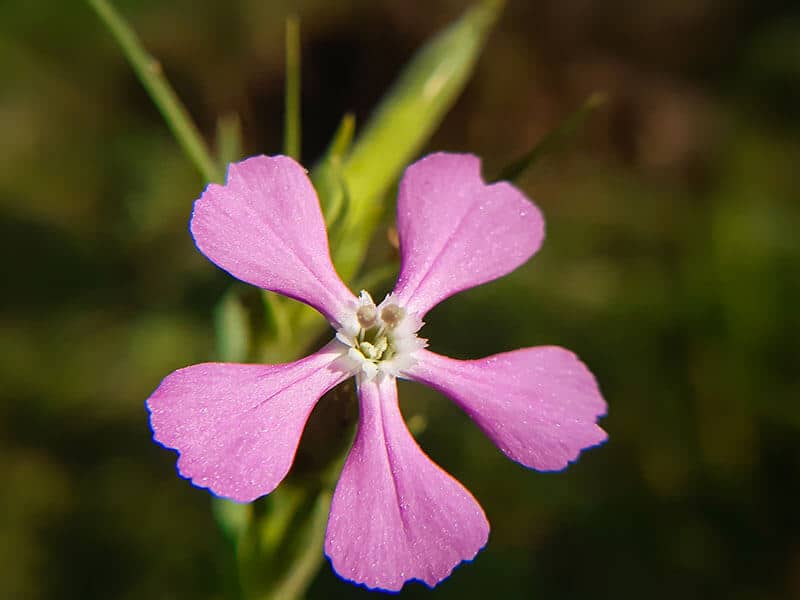
If you are setting up a rock garden, pick Silene as one of your plants. It is a remarkable plant for shady garden corners, which will surprise you with its beauty.
Silene is easy to grow in different soil types and conditions. The only thing the plant doesn’t tolerate is too acidic soil.
It blooms from April through July and pairs well with most other rock garden plants.
175. Snowdrops
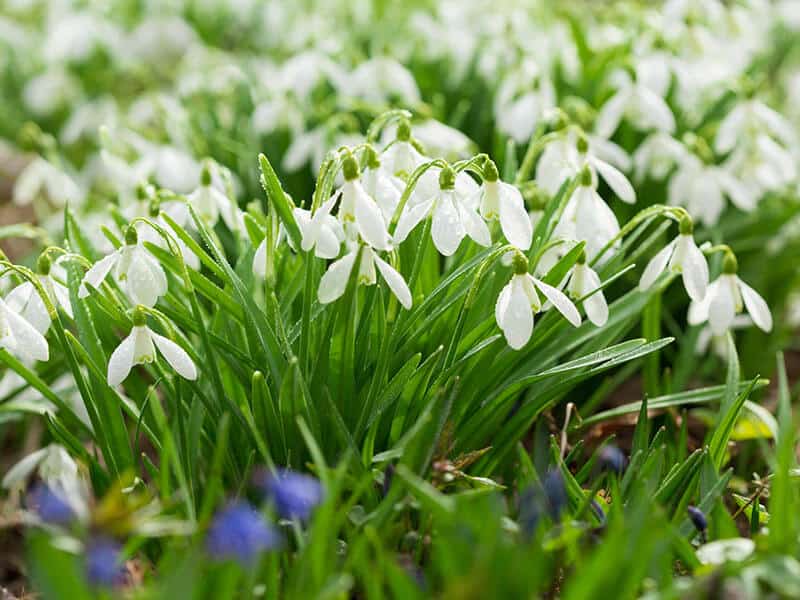
Snowdrops are fuss-free, hardy plants that are suitable for all garden styles. They are also tolerant of all conditions, except for dry soil. If you are growing them in a full sun location, make sure to water your Snowdrops regularly.
The scientific name for the plant is Galanthus, and the blooming season is from January to March. You can start Snowdrops from dormant bulbs in the summer.
176. Snowflake
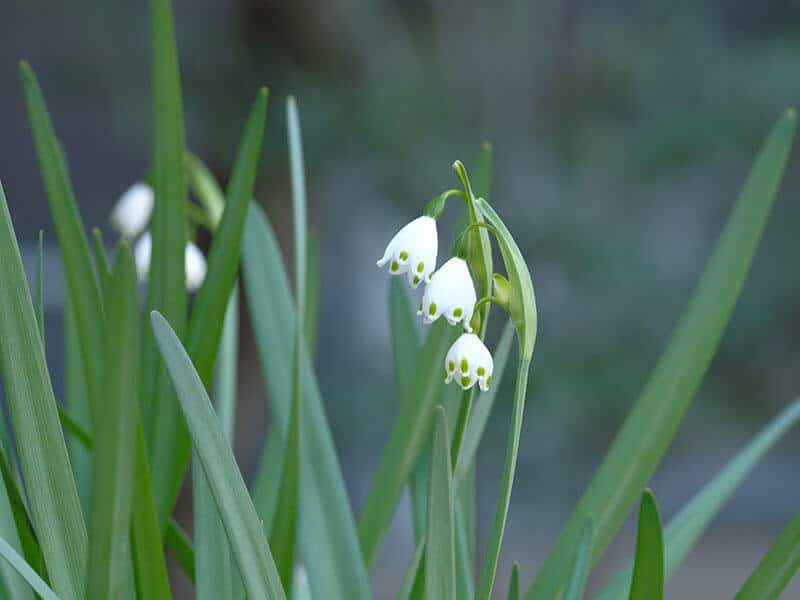
If you like Snowdrops, but you live in a hot climate, pick Snowdrops for their attractive appearance and easy-going nature. Snowdrops are suitable for all zones, and the bulbs should be planted in autumn.
After planting, your Snowdrops need regular watering and fertilization until the end of the growing season.
177. Speedwell
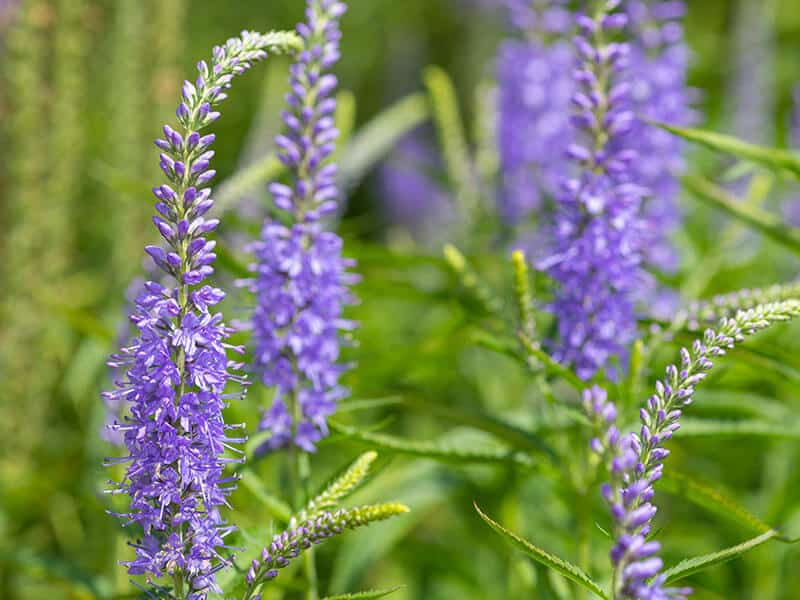
Speedwell plant is popular under the female name Veronica. The flowers are popular in floral arrangements and mixed containers.
Furthermore, Speedwell blooms for six or eight weeks in the summer with relatively simple care.
It grows better in sunny areas and sandy soil. The plant is tolerable to various soil pH balances, including alkaline, acidic and neutral. Keep the soil moist, but not soggy for the best results.
178. Sun Drop
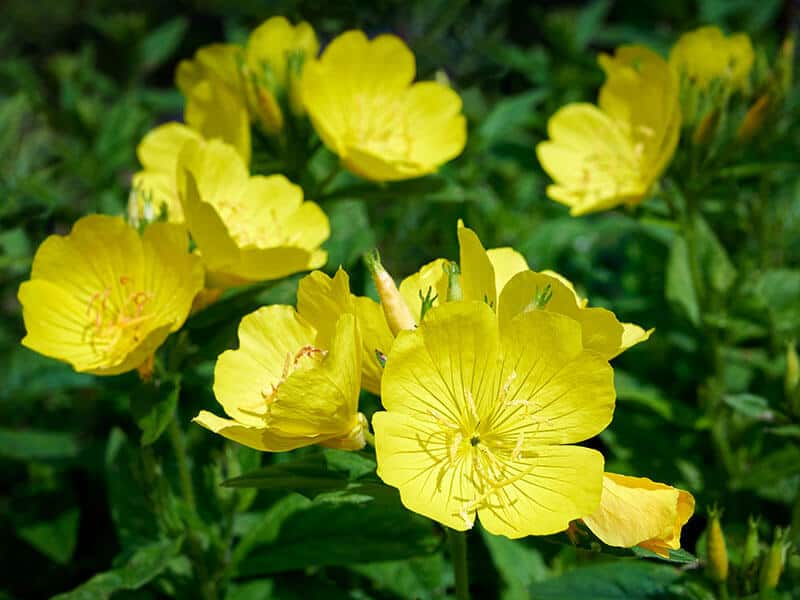
You can sow Sun drop seeds directly in moist garden soil in early spring, summer or fall. Germination takes around 20 days.
The plant develops sweet-scented yellow or pink flowers with soft and velvety textures. Humus-rich soil and occasional fertilization are all it takes for your Sun drop flowers to thrive. You may find it under the name Oenothera.
179. Sunflower
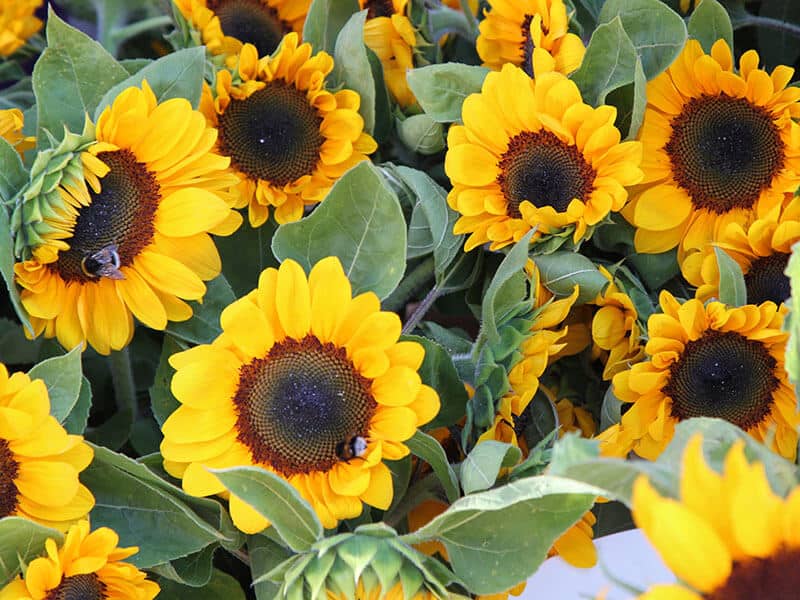
The Sunflower is an eternal summer favorite with bright yellow blooms that appear on tall stalks. These flowers are native to North America, but people grow these cheerful sunflowers (internal link keyword “How to Grow Sunflowers”) almost everywhere.
Sunflowers are simple plants to grow because they don’t suffer from pests or diseases. Plants grow fast and tolerate heat and drought.
The scientific name for the Sunflower is Helianthus.
180. Tiger Flower
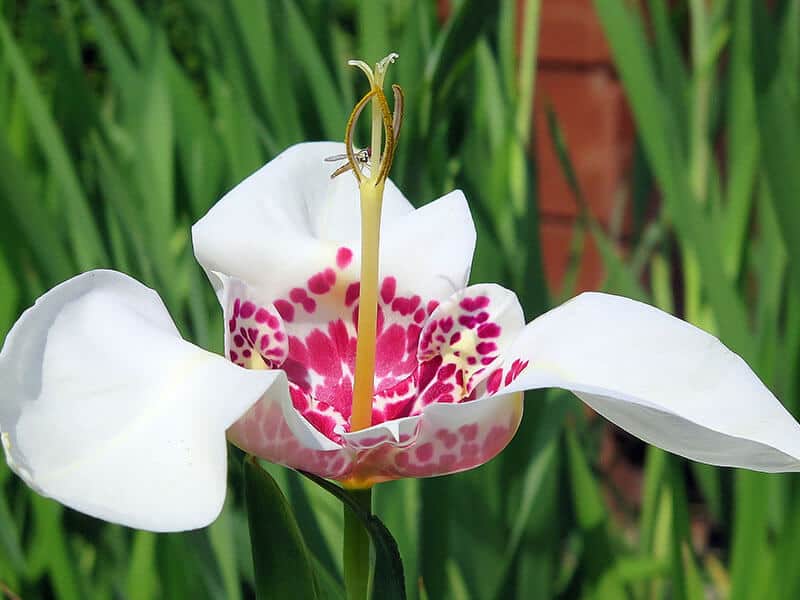
The Tiger flower or Tigridia is one of the rare flowers which can tolerate heat and harsh afternoon sun without damage. In fact, Tigridia needs a lot of sunlight to develop its stunning colorful flowers.
Tiger flower is suitable for a container garden, too, and can be mixed with flowering perennials in garden borders.
181. Tithonia
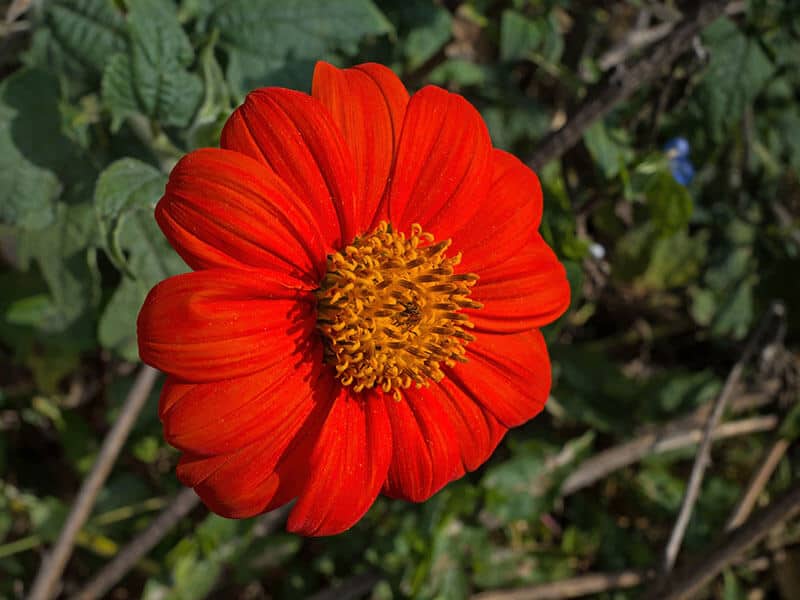
Tithonia prefers full sun exposure but doesn’t mind growing in poor-quality soil. If you want to induce blooms, never grow Tithonia in fertile soil. Nutrients will stimulate bushier growth and foliage production, and the flowers will remain insignificant.
Moreover, don’t fertilize Tithonia if you want to promote flowers! Don’t forget to stake taller Tithonias to prevent them from falling down.
182. Trillium
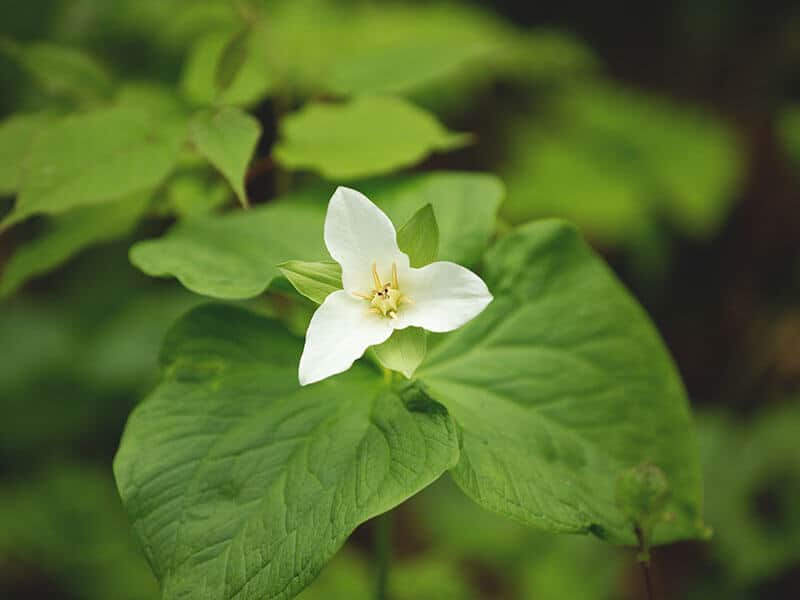
Trillium flowers are woodland spring stars, often referred to as Trinity flowers. They feature distinctive three-petaled flowers in white, red and multi-color.
Trillium is a perennial, but it spreads slowly and doesn’t need complex care.
The ideal time to plant Trillium is early spring or late summer. It will give the plant enough time to establish before too warm or cold temperatures.
183. Trollius
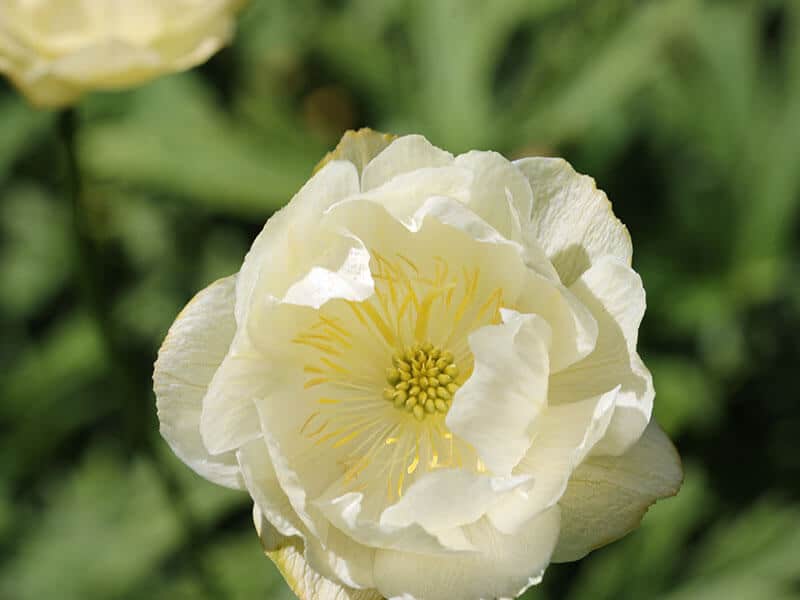
Trollius or Globeflower is the perfect addition to damp areas and boggy gardens. Full sun or partial shade is preferable for Trollius to ensure a fast-growth rate.
If you want to prolong the blooming season, remove spent flowers regularly. Likewise, the flowers are attractive to wildlife in your garden.
184. Trumpet Vine
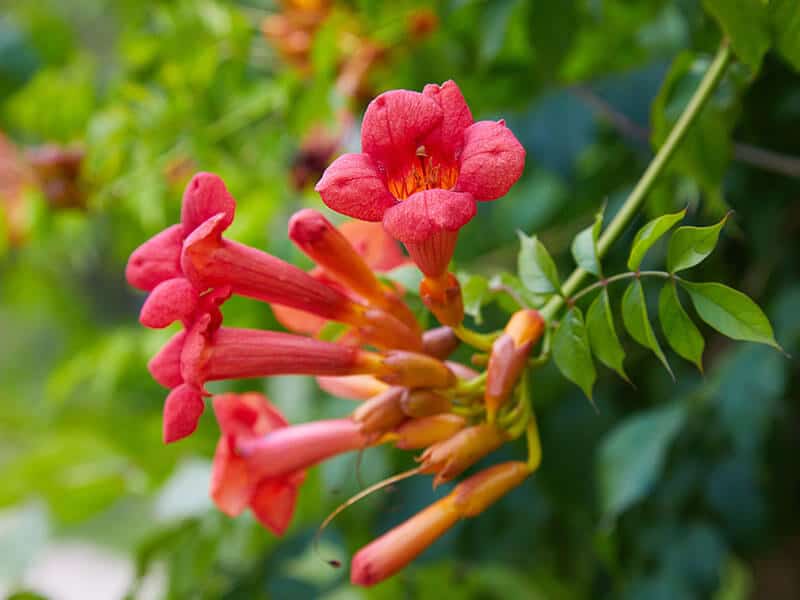
Trumpet vine is called Hummingbird vine because it attracts these birds. It is perfect for average soil and doesn’t need frequent watering and fertilization.
You have the best chances for success if you purchase established plants from nurseries and transplant them to your garden in the early fall. Purchase several plants and space them approximately five feet or more apart.
185. Tuberose
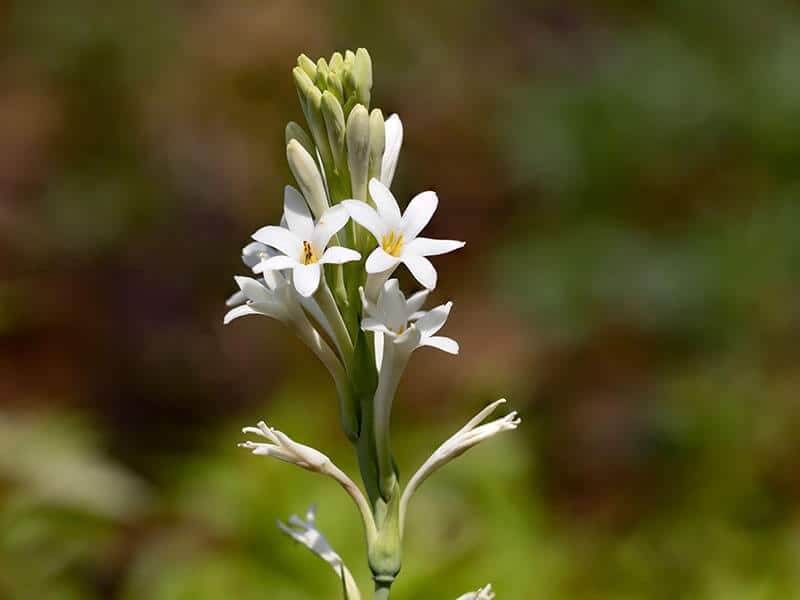
Tuberose bulbs are suitable for container gardens, raised beds, and garden borders. A tip you can try before planting them is to soak the bulbs in water to hydrate them and ensure maximum nutrient absorption.
Water regularly after planting and add balanced, slow-release fertilizer. The plant has several common names, including Snapdragon root and Fever root.
186. Tulips

Tulips are brightly colored garden gems, which start to show above the ground in late winter. The flowers prefer colder weather because mild climates can cause premature growth and mess up the flower life cycle.
If you want to enjoy lovely spring blooms, plant Tulips in the fall, before the first frost. A full sun location with plenty of afternoon sun is perfect for tulips.
Learn how to choose the best Tulips for your garden.
187. Urn Plant
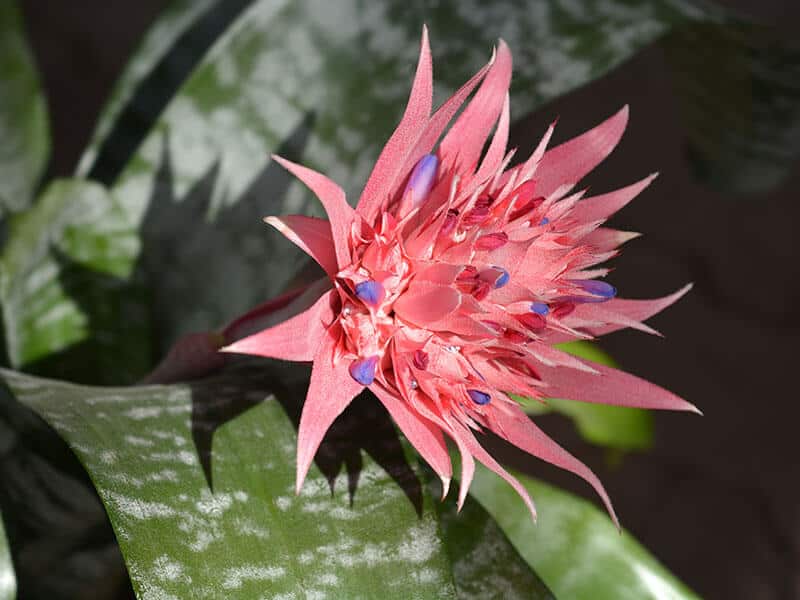
Urn plant or Aechmea is a fascinating plant with an unusual, exotic-looking flower. The plant comes from Brazil and prefers a lot of moisture and high humidity to thrive. If the flower petals and foliage tips turn brown, it signalizes your Urn plant is thirsty.
The plant should be exposed to sunlight gradually because too much sunlight can scorch the leaves.
Overall, the Urn plant is tricky to grow. But, its beautiful appearance is worth all the effort!
188. Uva Ursi
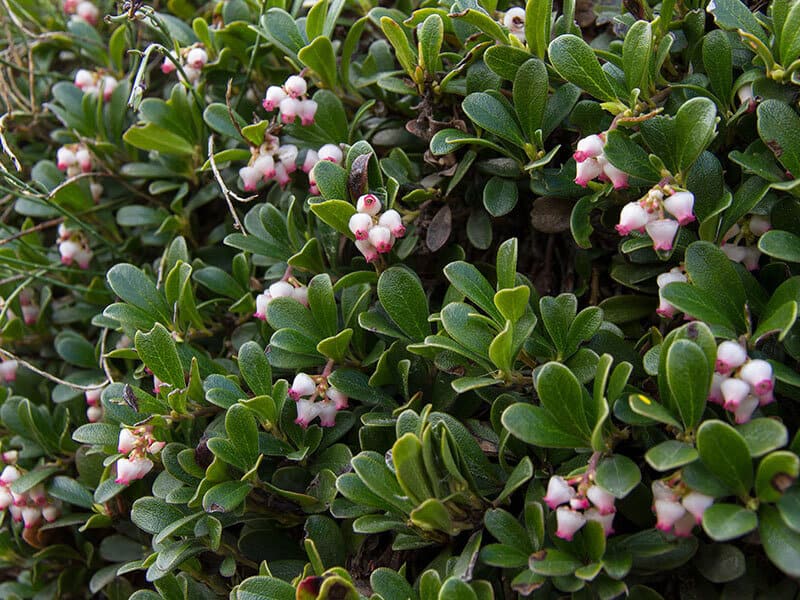
Uva ursi, or Bear berry plant, is common specie in northern parts of the USA. It is the perfect low-maintenance groundcover for subtle landscaping in poor soil. This carefree perennial rarely grows above ten inches.
Uva ursi produces small, pastel pink flowers between March and June on flexible stems. The plant grows slowly during the first year, and then quickly spreads even in the poorest soil.
189. Verbena
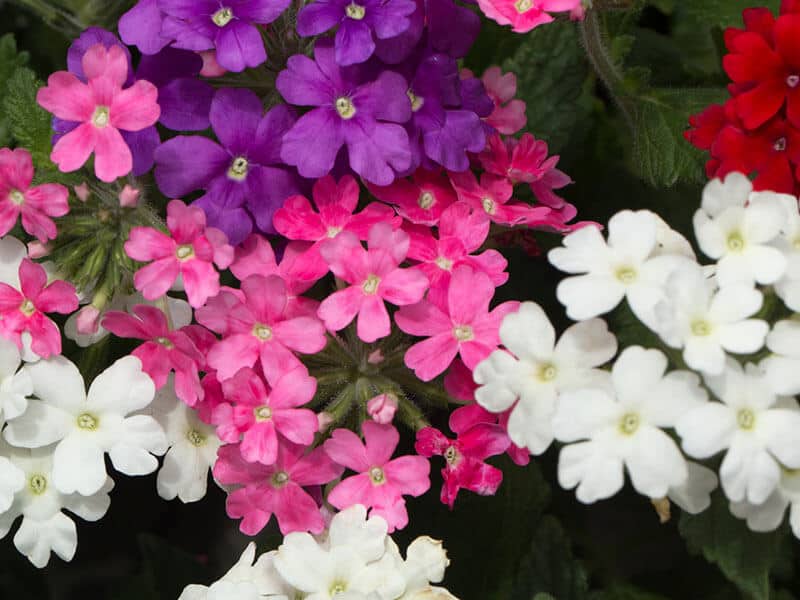
Verbena is native to South America and is a large genus of flowering plants. Most of them live shortly, but they produce lovely flowers filled with sweet nectar, perfect for pollinators.
Some Verbena varieties grow well in pots, and you can grow them on your balcony, too. Others are remarkable for gardens.
Grow Verbena in moist, moderately fertile soil and full sun. Also, even though some Verbena cultivars are tall, they don’t need stalking because the stems are rigid.
190. Viburnum
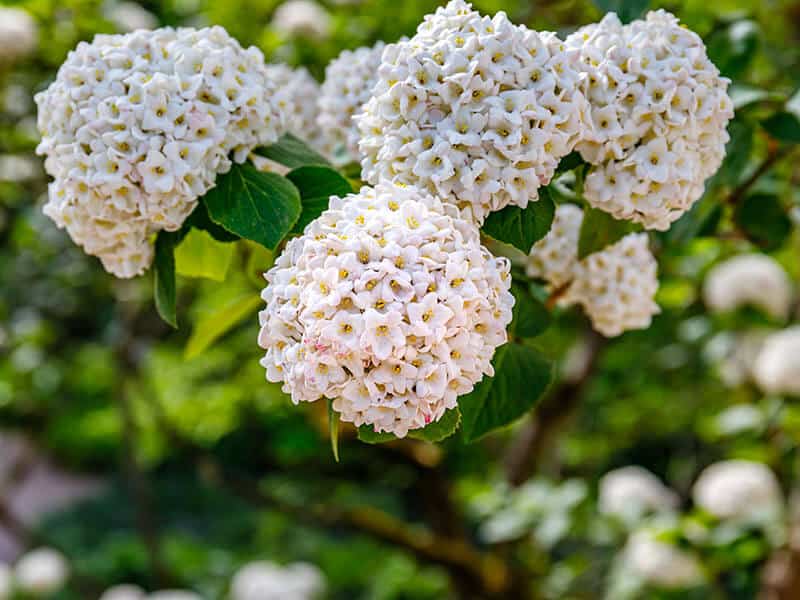
Viburnums have more than one ornamental feature. The plants produce pleasing flowers, attractive berries, and lovely deep green foliage.
Viburnums are easy to grow in zones from two to nine. You can grow them from seeds, but it seems like unnecessary trouble because germination isn’t reliable. Growing Viburnums from established plants is much simpler.
191. Vinca Minor
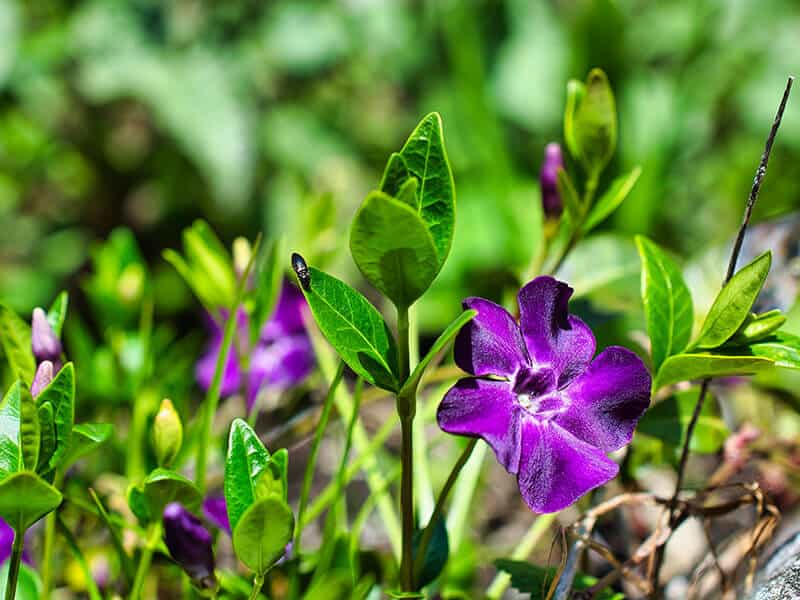
Vinca minor or Periwinkle plant is a tough and pest-free, low-maintenance flowering creeper. The broadleaf foliage and attractive flowers develop equally in all soil types and sunlight conditions.
Vinca minor is native to Europe, but it is easy to grow in zones four to nine. It is exceptional for covering large spaces but grows excellent in pots, too.
192. Violet
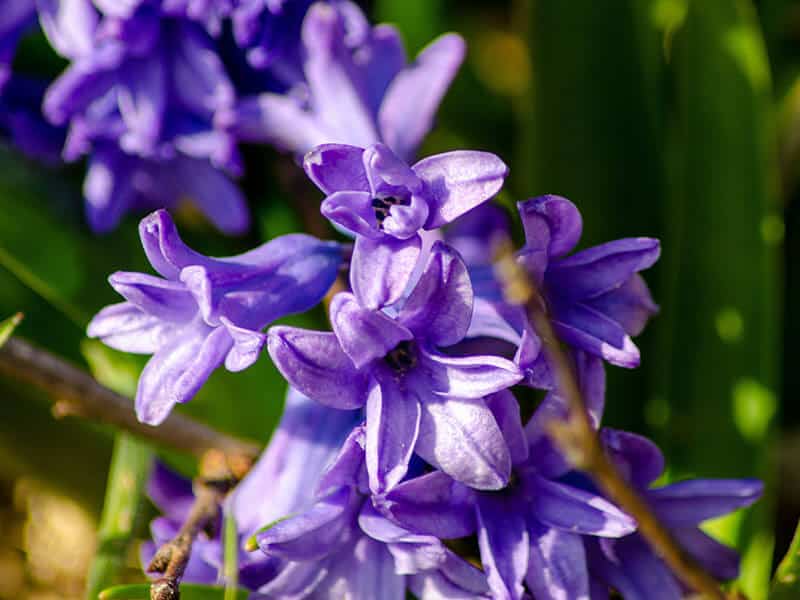
Violet flowers need to be distinguished from Violas or Pansies. They feature five-petaled flowers which appear on short stems. The plant belongs to the Violaceae family and is easier to grow from established plants. Plants are usually trouble-free and require little care.
Violet cultivars bear white, pink, and purple colors. The flowers are a sweet-scented and important source of nectar for pollinators.
193. Virginia Creeper
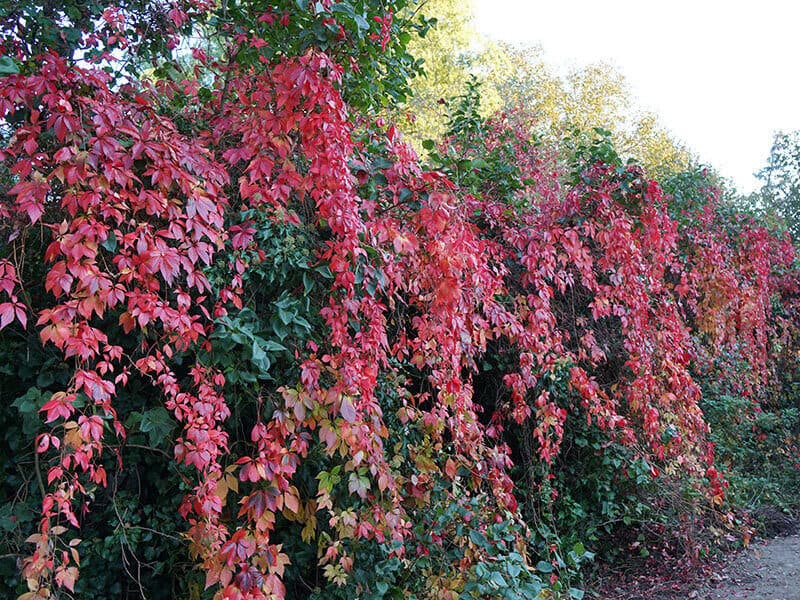
Virginia creeper is often planted to cover large walls or fences. The flowers aren’t particularly significant and are followed by berries in the autumn. Also, Virginia creeper looks spectacular in the fall, when the foliage turns to dazzling shades of orange and red.
Plant Virginia creeper is moist and well-draining soil. The plant needs annual pruning, ideally in autumn.
194. Wallflower
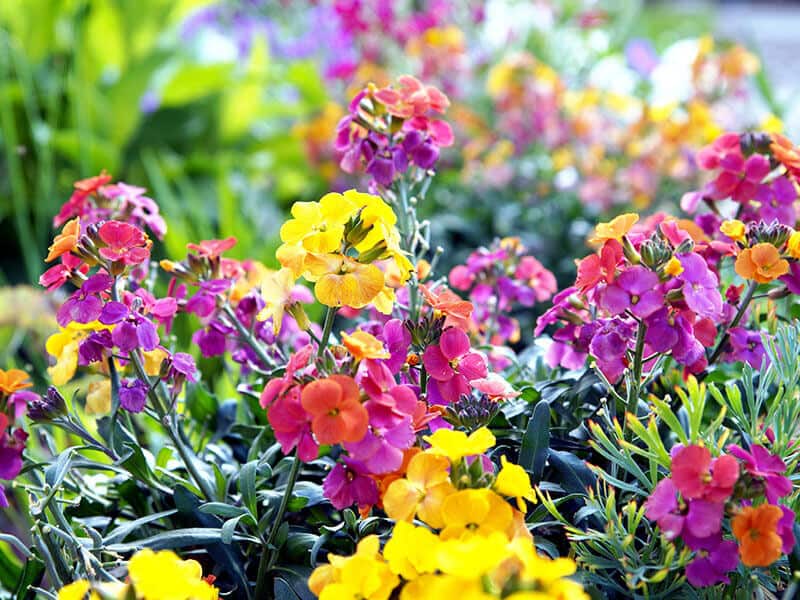
The Wallflower is a heavily fragrant and perky flower native to the United States. Most gardeners successfully grow Wallflower without trouble. Most commonly, flowers are lush orange, but modern cultivars produce pink, blue, and yellow blooms.
Wallflowers are drought-tolerant, and some have evergreen foliage. Those are especially good for zones eight to ten.
195. Watsonia
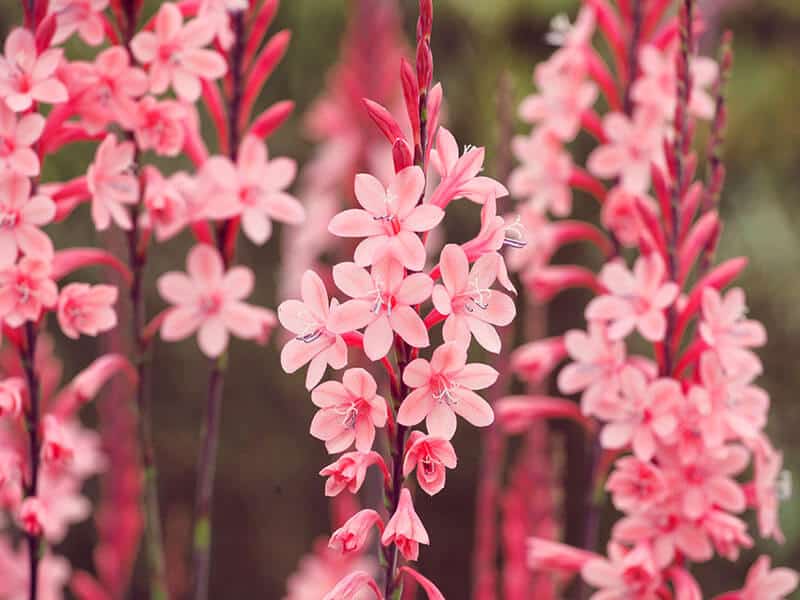
The stunning Watsonia flower is also known as the Bugle Lily plant. You can grow it from seeds or bulbs, and Watsonia prefers a warmer climate.
The flowers are delicate and available in a wide range of peach and orange hues. Caring for Watsonia flowers is simple, as long as you don’t plant the bulbs in waterlogged soil. Good drainage, warm temperatures, and several hours of sunlight are enough to keep your Watsonia thriving.
196. Wax Plant
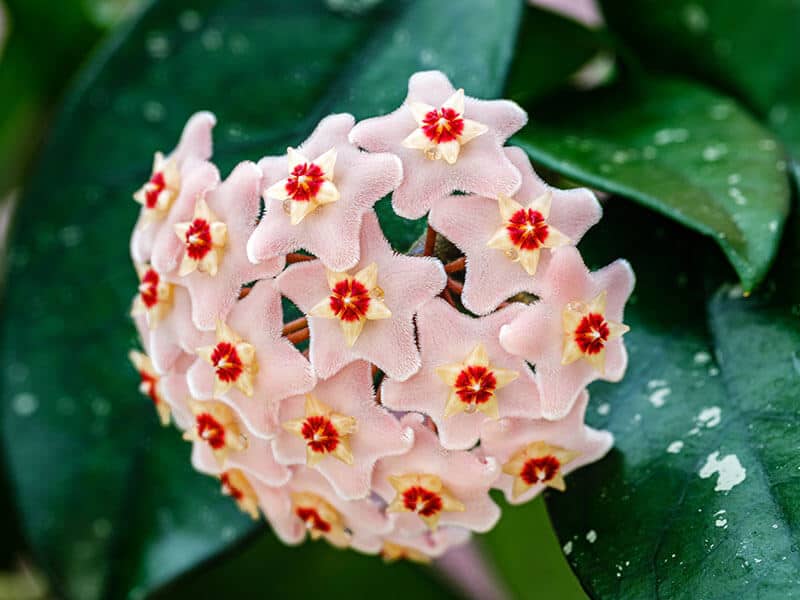
The popular Wax plant or Hoya carnosa is an attractive climbing vine you can start from cuttings. The vine grows better in partial shade, protected from too much sunlight, which can burn the leaves.
If you grow it as a houseplant, you can keep it in the bathroom to increase humidity. Otherwise, misting is beneficial for the plant.
The Wax plant doesn’t suffer from pests and diseases.
197. Wedelia
Interestingly, Wedelia can grow perfectly well in the sun or shade. But, if you are growing it for its wonderful flowers, plant Wedelia in a sunny spot. This creeping perennial is often used as ground cover and needs periodic trimming.
If you don’t trim it, Wedelia can grow up to 24 inches. Regular trimming can help you keep Wedelia at a 4-inch height.
Wedelia is practical for erosion control in some regions.
198. Weigela

Weigela is a delightful ornamental shrub that flowers in the spring. Plain Weigela cultivars drop leaves in the fall, and modern hybrid varieties have variegated fall foliage or burgundy leaves. So, Weigela can provide year-round interest in your garden.
Weigela shrub is versatile, and it can adapt to full sun or shade. Moist soil enriched with compost is suitable for the shrub.
199. Winter Aconite
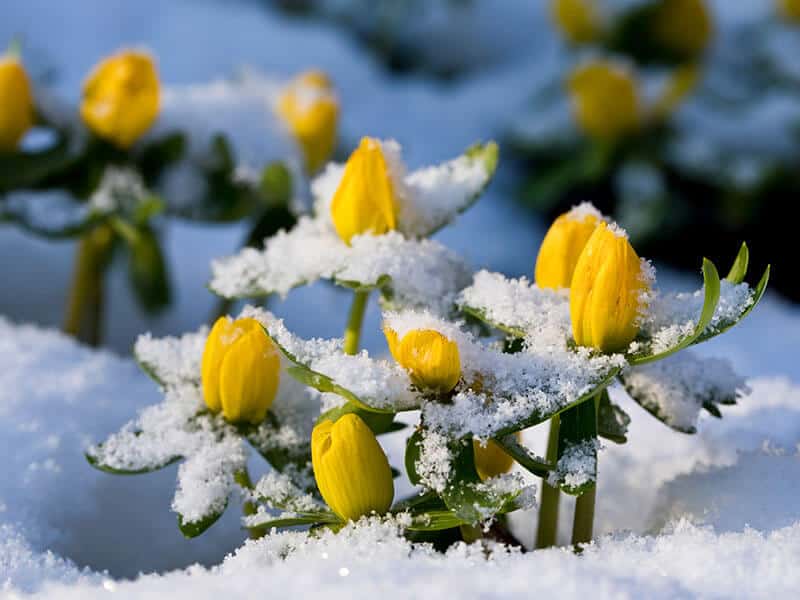
If you want to grace your garden with stunning yellow flowers in February, plant Winter Aconite. These flowers look best when you plant them in masses or on garden borders.
At first, Winter Aconite might be tricky to grow. But, once the plant gets established, it becomes fuss-free and spreads quickly.
Winter Aconite needs partial shade and consistently moist soil. These flowers are best suited for woodland garden settings.
200. Winterberry
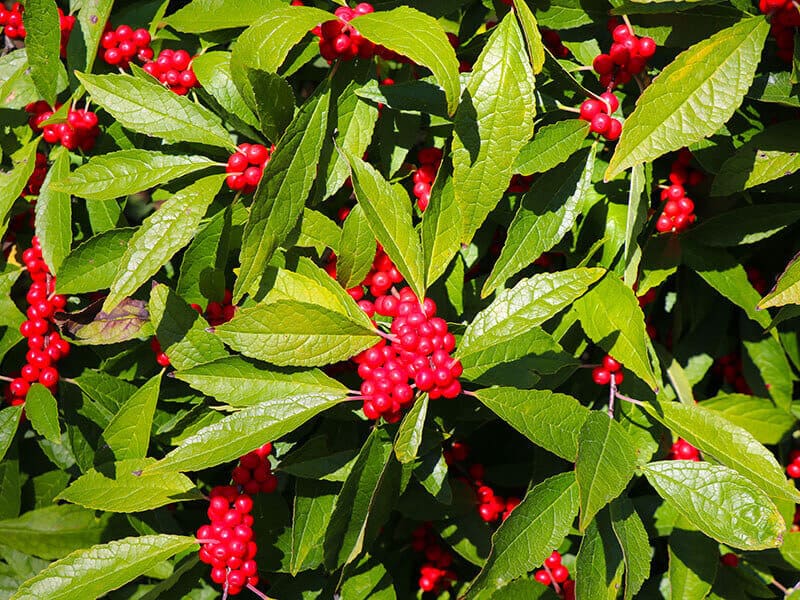
Winterberry is a popular shrub in the USA and Canada. It is easily recognizable because of the red berries, which hold well against harsh winter weather. On average, Winterberry grows between six and 15 feet tall. It spread about the same.
If you don’t prune it, your Winterberry shrub maintains an informal round shape. The shrub isn’t tolerable in dry conditions, so ensure you water it regularly. Avoid planting Winterberry in alkaline soil because it can lead to diseases.
201. Wishbone Flower
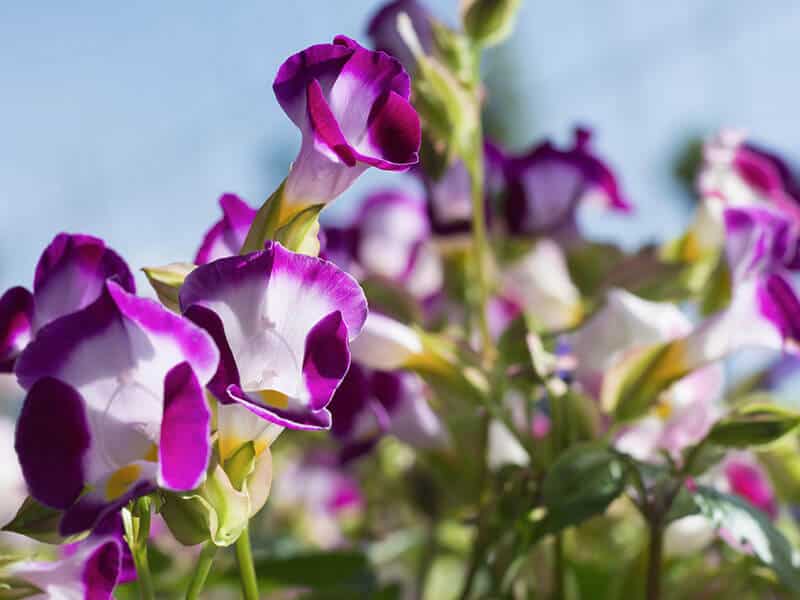
If you want to ensure long-lasting success with your Wishbone flower, pick the planting location wisely. Even though the plant is adaptable to various conditions, choose rich and moist soil for the Wishbone flower.
Ideally, the plant should be exposed to morning sunlight, and have protection against the harsh afternoon sun, especially in warmer zones.
Wishbone flowers need regular fertilization twice a month during spring and summer. Pick a fertilizer with a high phosphorus content.
202. Wisteria
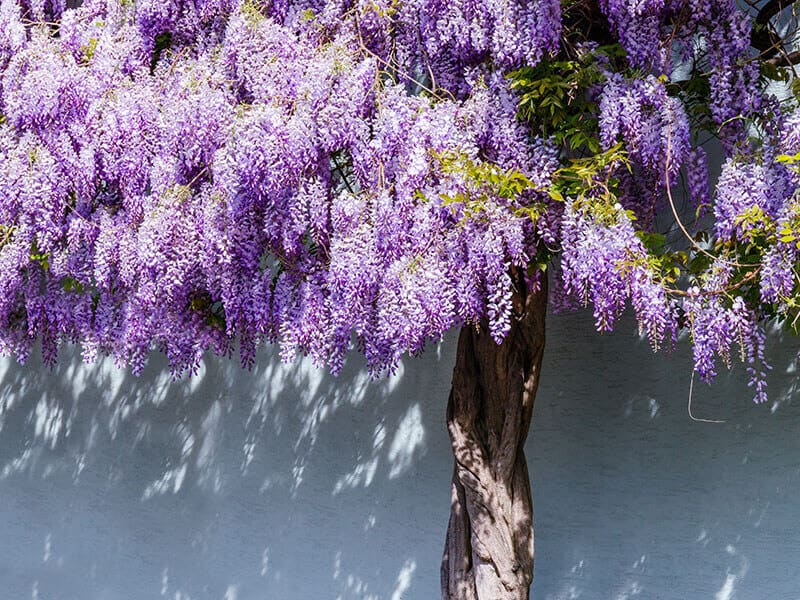
Despite its tricky plant reputation, Wisteria is adored by many gardeners because of its attractive and fragrant flowers. Wisteria is famous for its vigorous grower, especially if you plant it in full sun.
Growing Wisteria can be tricky and requires regular care and pruning. You can choose between American and Asian Wisterias to create an attractive landscape in your backyard.
You can see this video to know more:
203. Xanthoceras Sorbifolium
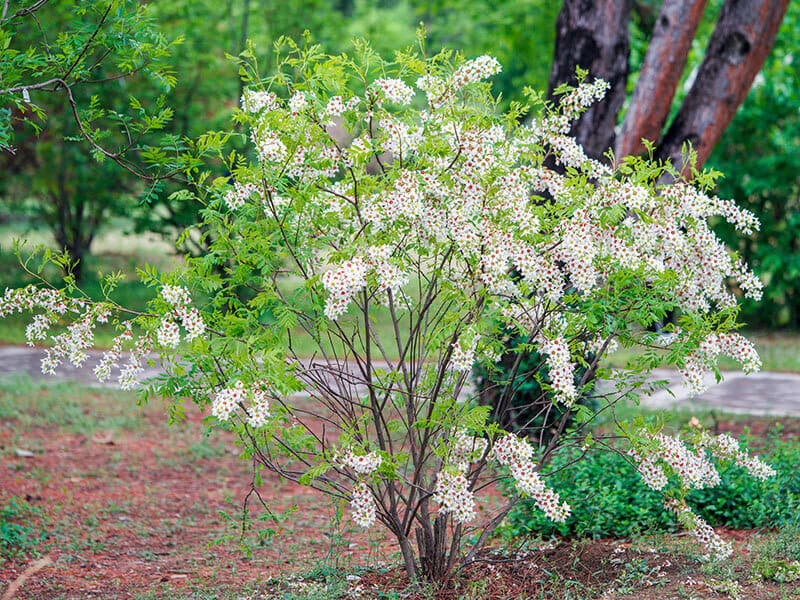
Xanthoceras Sorbifolium or Yellowhorn is native to China and is popular under the name Chinese Flowering Chestnut. This deciduous shrub is easy to grow and, if you give the shrub enough space, it can reach 25 feet in height.
Most popular cultivars produce compact white flowers with bright red centers. Yellowhorn thrives in full-sun, loose, and loamy soil with moderate moisture.
204. Xeranthemum
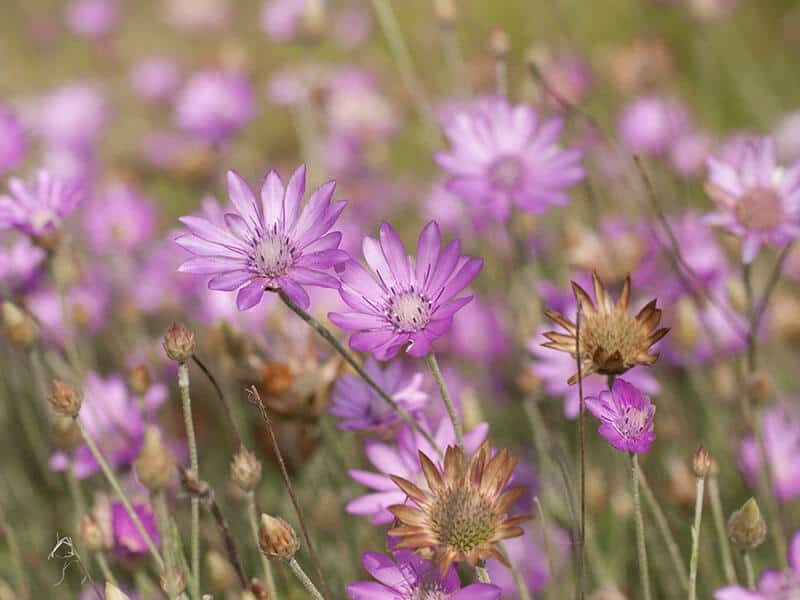
Xeranthemum features silvery foliage and blooms at the end of the summer. The flowers are usually pink or purple and look a little like daisies.
Xeranthemum is easy to grow. The flower is drought-tolerant and practically thrives on neglect. All you have to do is water the plant occasionally.
205. Xerophyllum
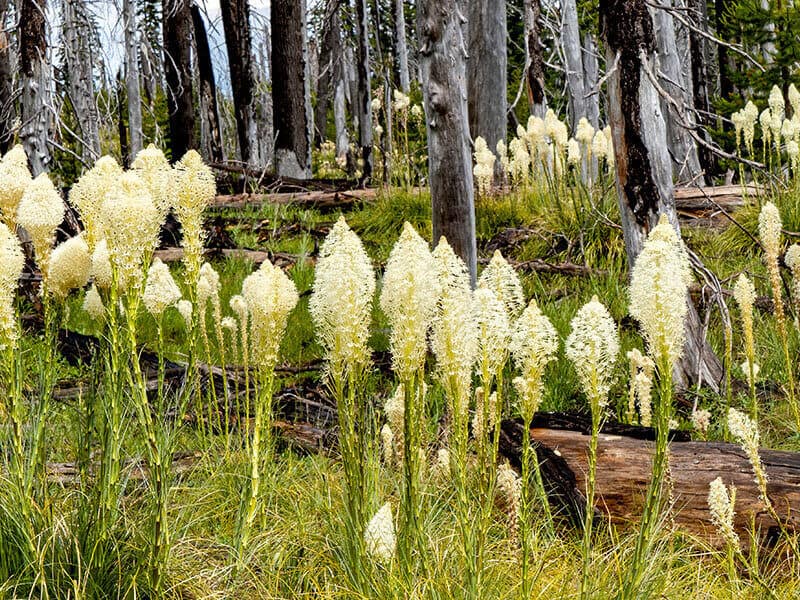
Xerophyllum or Bear Grass is best known for its large spherical summer flowers. The flower appears on tall stems and consists of hundreds of tiny flowers, which give the flower a unique appearance.
Xerophyllum is easy to grow in full sun or dappled shade. It tolerates drought and prefers excellent soil drainage.
206. Xylosma
Xylosma is a charming compact shrub, native to China. The flowers aren’t showy, and most people grow Xylosma shrubs because of the ornamental leaves. The foliage is thick and shiny, and new growth appears brown or reddish and slowly turns light green.
Xylosma shrub is a fast grower, and you can choose between various cultivars with upright and round growing habits. The plant tolerates various conditions and only requires occasional pruning to remain good-looking.
207. Yarrow
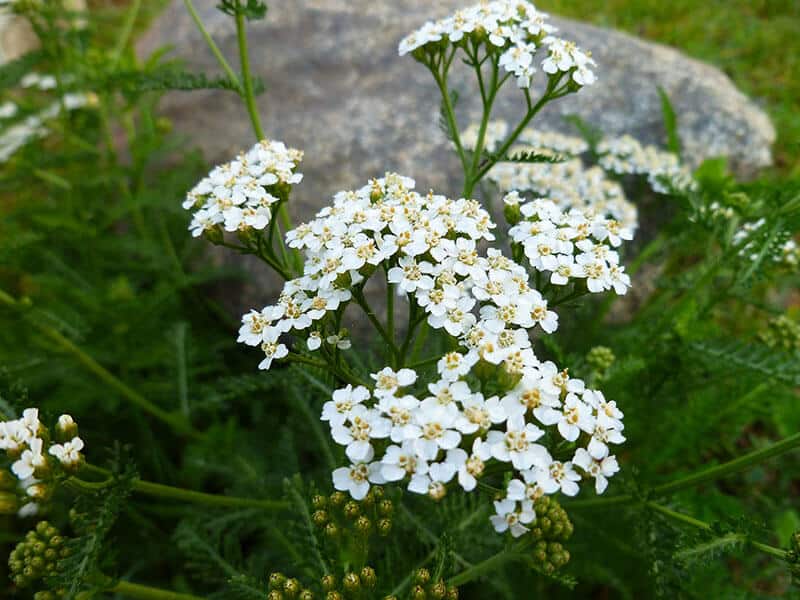
Yarrow is an aromatic herb with plenty of benefits and uses in alternative medicine. But, you can also grow it as an ornamental plant in your garden.
If you choose to plant Yarrow in your garden, keep an eye on it because it is an invasive plant, which spreads quickly and can overcome your entire garden.
Yarrow grows better in drier soil but may tolerate occasional wetness. Loamy soil is the best, but you can also plant Yarrow in clay soil.
208. Yellow Archangel
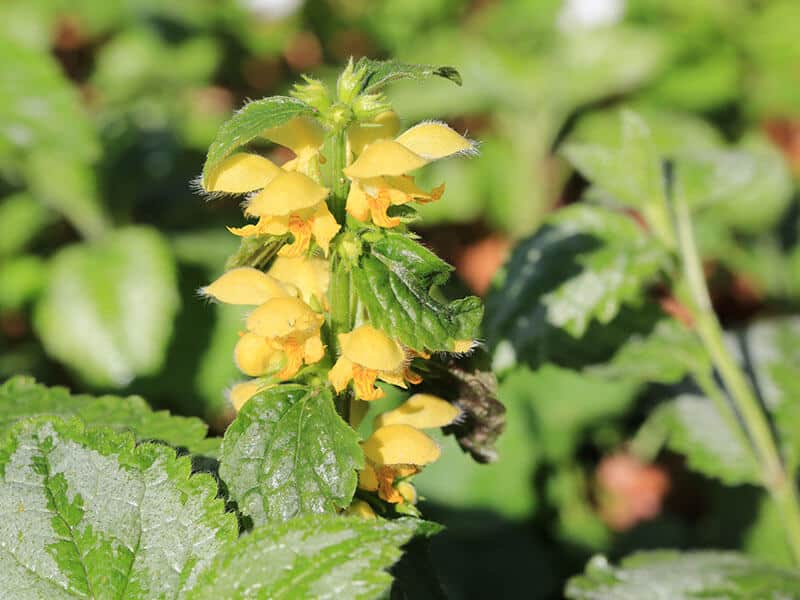
Whatever the soil is in your garden, Yellow Arcangel can tolerate it as long as it isn’t waterlogged. It is a lovely, fragrant perennial plant that disperses a mint-like aroma from tiny yellow flowers.
The plant blooms in the spring and is hardy in zones from four to nine. Because Yellow Archangel grows fast and tolerates most conditions, it can be invasive.
Yellow Archangel is also called Aluminum plant or Golden dead nettle.
209. Yellow Bell
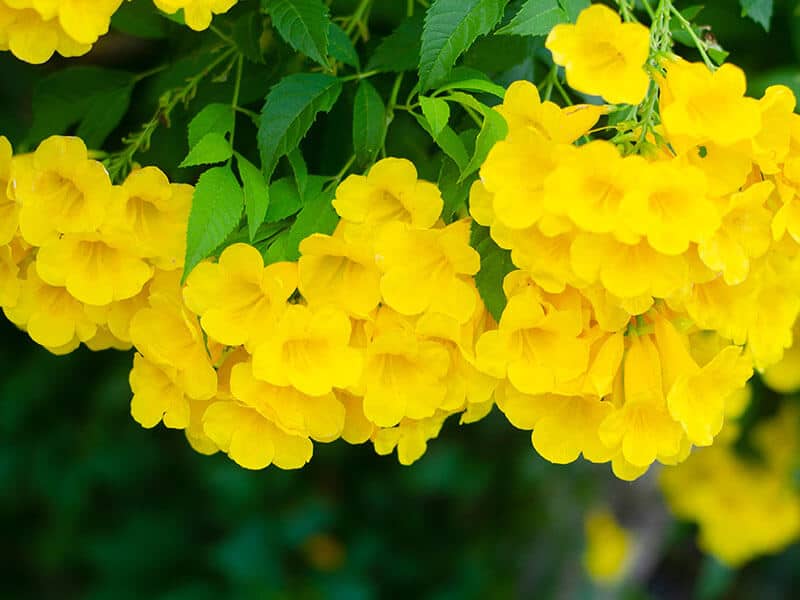
The Yellow bell shrub is a fast grower and looks attractive with its golden yellow, trumpet-shaped flowers. These lovely blooms are pleasant to most beneficial pollinators and hummingbirds.
You can grow Yellow bell flowers in partial shade in hot zones or full sun in moderate climates. In addition, the shrub needs airy soil, loamy or sandy.
The shrub isn’t high-maintenance and looks terrific in all gardens.
210. Zephyranthes
Zephyranthes may be confused with grass when there aren’t flowers. But, during the blooming season, Zephyranthes develop lovely pink or white, star-shaped flowers.
Zephyranthes is an easy-going plant, and you can start it from seeds. It has moderate watering needs and prefers a semi-shade location. However, in northern climates, Zephyranthes grow best in full sun.
211. Zinnia Elegans
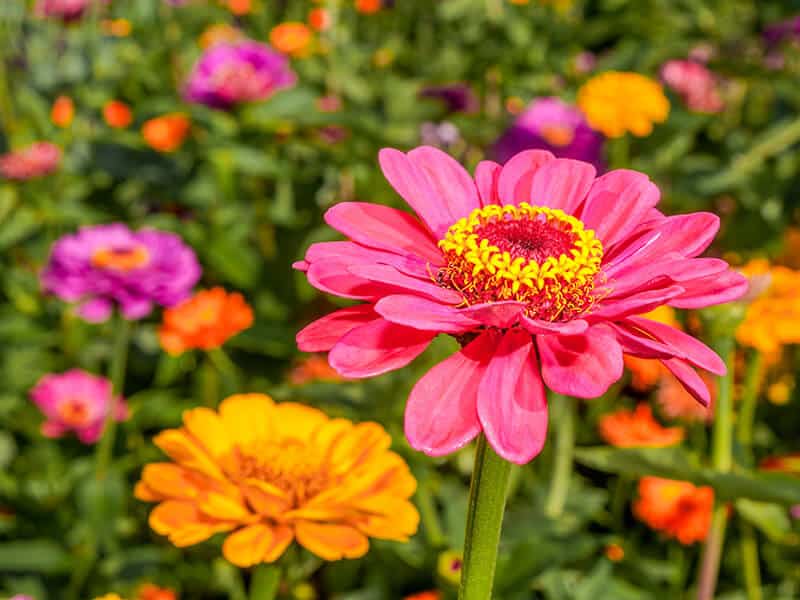
There are several types of attractive and low-maintenance Zinnias (internal link keyword “Zinnia types”).
Zinnias grow rapidly and bloom without any special requirements. They are excellent for ensuring a burst of color in your garden.
These colorful flowers need six or more hours of sunlight per day, excellent air circulation to prevent powdery mildew, and good drainage.
Grace Your Garden With The Best Flowers
Mother Nature was especially generous when she created all these different types of flowers. As a gardener, you’ve got a tough choice in front of you!
But, consider your garden condition, hardiness zones, skills and preferences to find the best flowers! You can always increase your flower collection and rotate them!
How did you like the list? Which are your favorite flowers?
